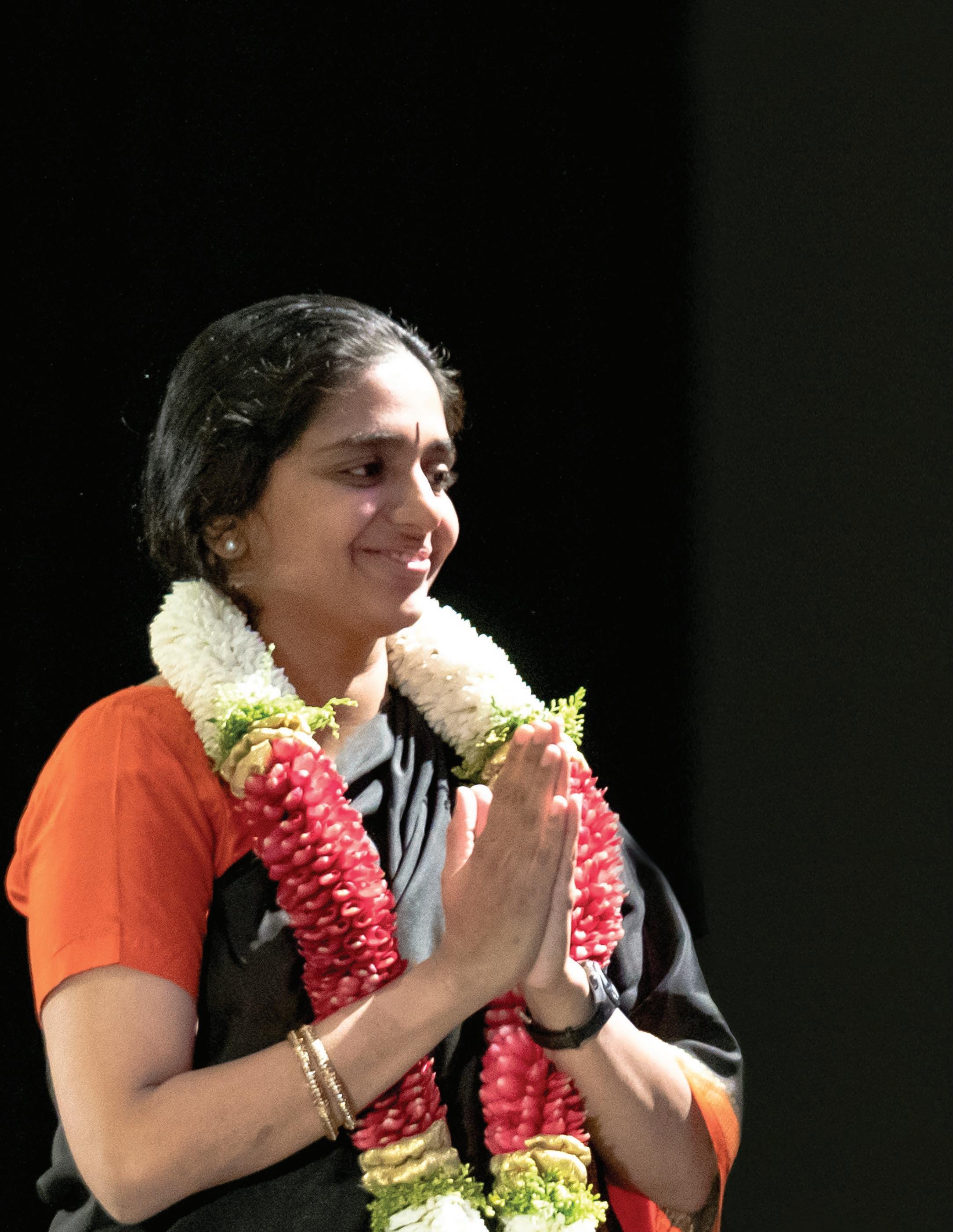
Fall 2022VOL. 2 NO. 1 Sankalpa A Compassionate Eye – Rebecca Lerner From Breath to Prana – Pauline Schloesser Power of Inversions – Roger Cole, Ph.D. Pranayama John Schumacher Pajama Yoga – Marcia Monroe Back Leg in Standing Poses – Lois Steinberg, Ph.D. Tribute to Faeq – Carolyn Belko
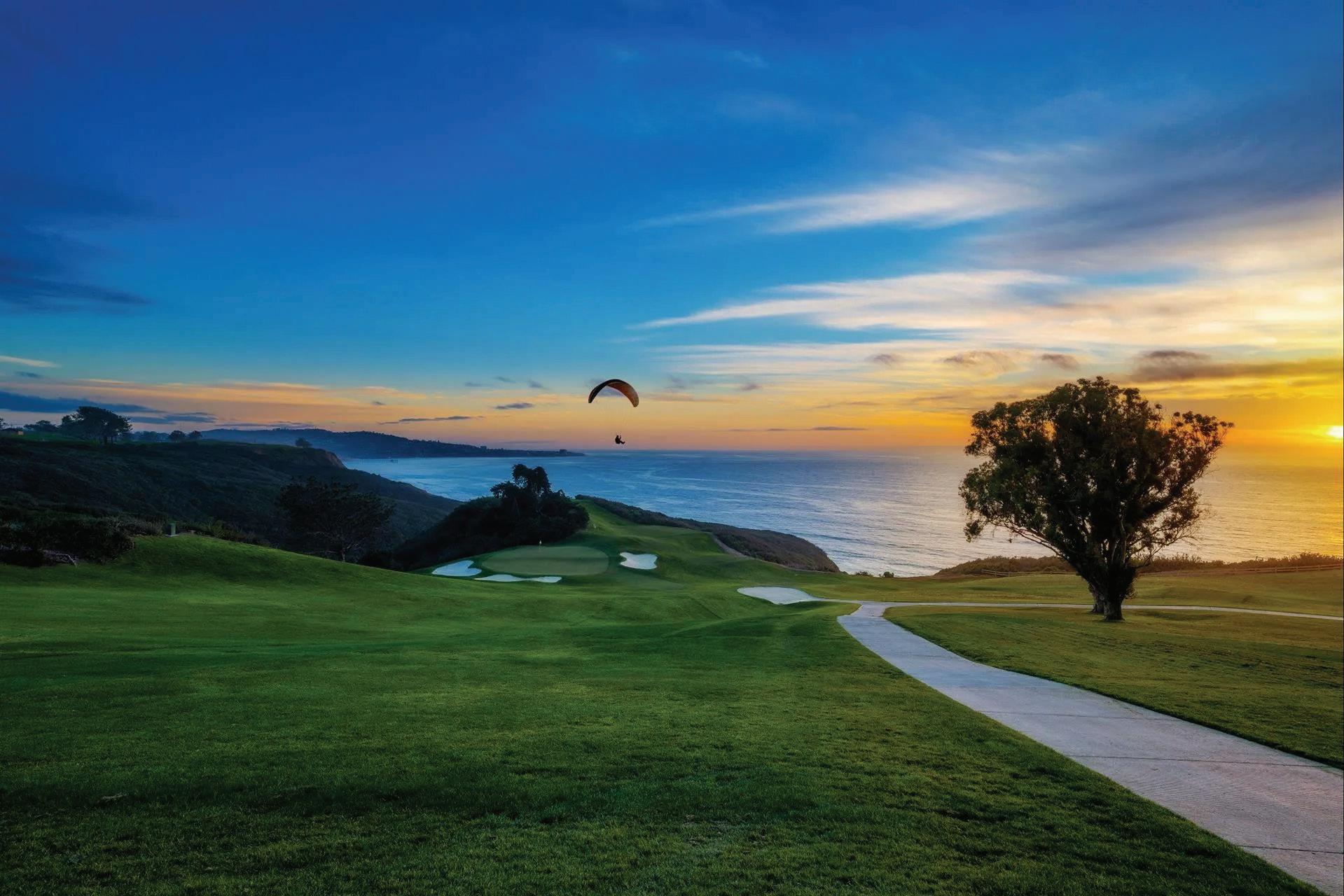
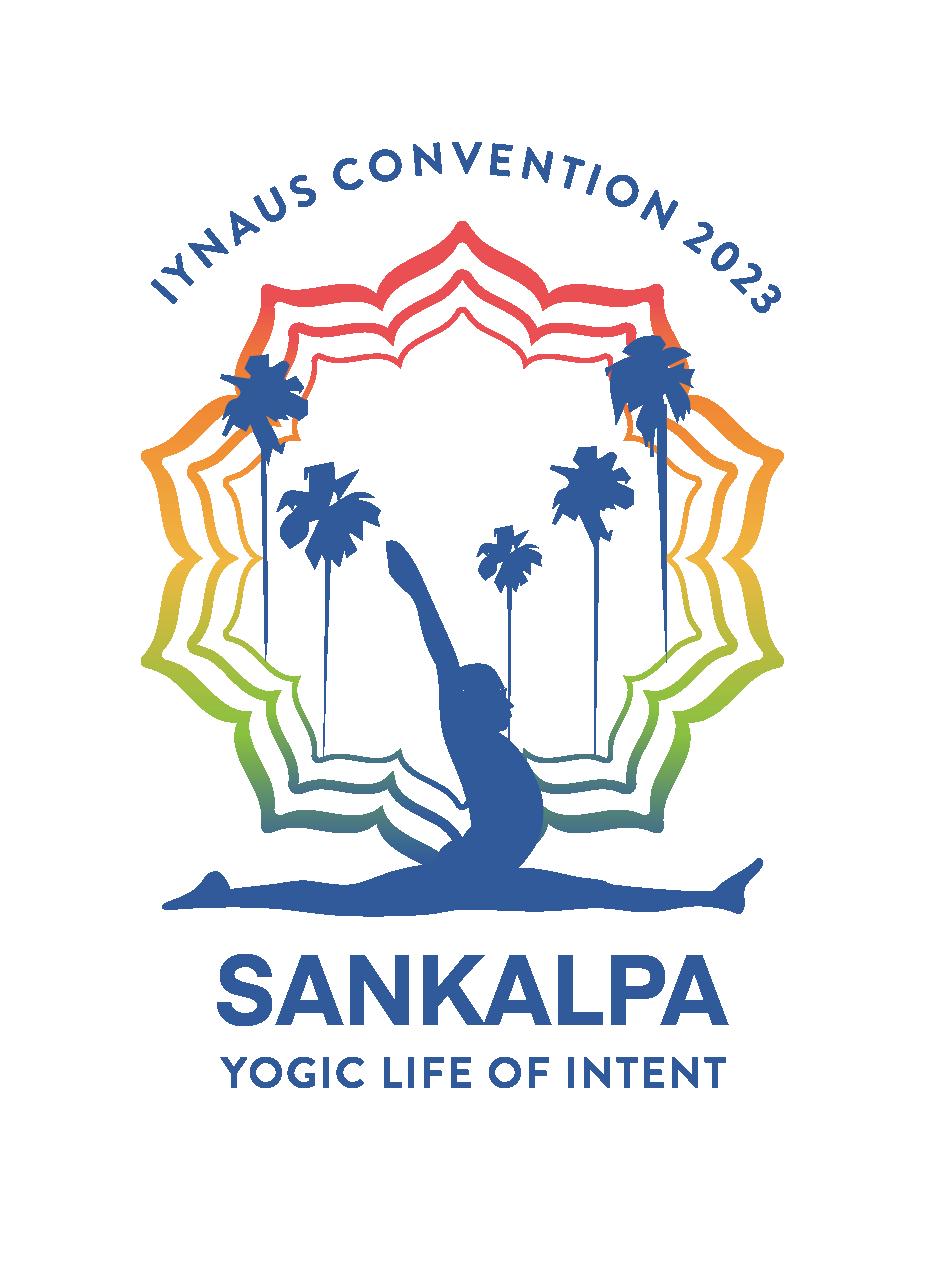
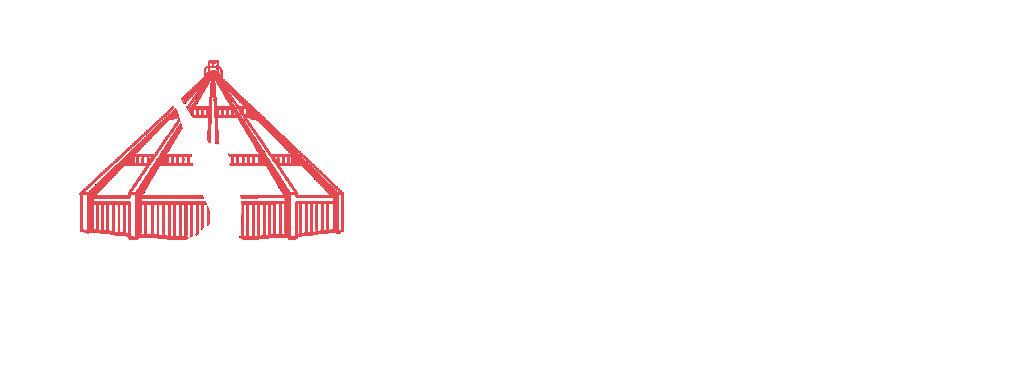
IYNAUS CONVENTION 2023 with ABHIJATA IYENGAR MAY 15 — 20 TOWN & COUNTRY RESORT SAN DIEGO, CA VISIT: https://iynaus.org/convention2023 REGISTRATION OPENS SOON
THE LIGHT’S MISSION
The Light, the magazine of the Iyengar Yoga community in the U.S., is published twice a year by the Publications Committee of the Iyengar Yoga National Association of the U.S. (IYNAUS). The Light is designed to provide interesting, educational, and useful information to IYNAUS members to:
• Promote the dissemination of the art, science, and philosophy of yoga as taught by B.K.S. Iyengar, Dr. Geeta S. Iyengar, and Prashant Iyengar.
• Communicate information regarding the standards and training of certified teachers.
• Report on studies regarding the practice of Iyengar Yoga.
• Provide information on products and services related to Iyengar Yoga.
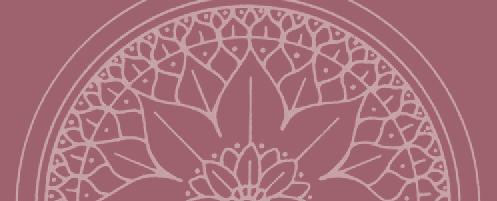
• Review and present articles and books written by the Iyengars.
• Be a platform for the expression of experience and thoughts from members of all diverse backgrounds, both students and teachers, about how the practice of yoga affects their lives.
• Present ideas to stimulate every aspect of the reader’s practice.
IYNAUS BOARD OFFICERS AND COMMITTEE CHAIRS CONTACT LIST
Fall 2022 PRESIDENT Gloria Goldberg president@iynaus.org
VICE PRESIDENT
Hector Jairo Martinez vice.president@iynaus.org
SECRETARY
Adrienne Klein secretary@iynaus.org
TREASURER
Tay Bulanda treasurer@iynaus.org
CHIEF EQUITY AND INCLUSION OFFICER
Stephanie Perry Bush yogaequityspb@iynaus.org
ARCHIVES
Kathleen Quinn, Chair archives@iynaus.org
ASSESSMENT
Nina Pileggi, Chair assessment.chair@iynaus.org
CONTINUING EDUCATION
Susan Johnson, Chair continuinged@iynaus.org
ETHICS
Janet Lilly, Chair ethics@iynaus.org
EVENTS
SulieAnna Tay (Tay), Chair events@iynaus.org
FINANCE
Tay Bulanda, Chair treasurer@iynaus.org
TABLE OF CONTENTS
Letter from the President . . . . . . . . . . . . . . . . . . . . . . 2
Letter from the Editor 3
A Compassionate Eye, Rebecca Lerner, Dan Shuman 5
From Breath to Prana, Pauline Schloesser 11
Power of Inversions, Roger Cole, Ph.D. 17
In the Beginning Preliminary Pranayama, John Schumacher 30
Pajamas Yoga, Marcia Monroe 33
Back Leg in Standing Poses, Lois Steinberg, Ph.D 35
Tribute to Faeq, Carolyn Belko 38
Patricia Walden birthday, Randy Just 42
GOVERNANCE
Gretchen House, Chair regional.support@iynaus.org
MEMBERSHIP
Gretchen House, Chair membership@iynaus.org
PUBLICATIONS
Daniel Shuman, Chair publications@iynaus.org
PUBLIC RELATIONS/ MARKETING
Emilie Burnod, Chair socialmedia@iynaus.org
REGIONAL SUPPORT
Gretchen House, Chair regional.support@iynaus.org
SERVICE MARK & CERTIFICATION MARK
Gloria Goldberg, Attorney in Fact for B.K.S. Iyengar, Chair trademarks@iynaus.org
SYSTEMS AND TECHNOLOGY
Nicholas Jouriles, Chair technology@iynaus.org
VOLUNTEER
Janet Lilly, Chair volunteer@iynaus.org
YOGA & EQUITY
Hector Martinez, Co-chair Megan Bowles, Co-chair yogaequity@iynaus.org
YOGA RESEARCH
Anne Clatworthy, Chair research@iynaus.org
THE LIGHT IS PRODUCED BY THE IYNAUS PUBLICATIONS COMMITTEE:
Dan Shuman, Chair, Editor, The Light Jennie Williford, Editor, Samachar Don Gura, Art Director David Monteith, Copy Editor Sheryl Abrams, Advertising Susan Goulet, Advisor
WRITERS: Roger Cole Lois Steinberg Marcia Monroe Daniel Shuman Lucienne Vidah
Carolyn Belko Jim Benvenuto Pauline Schloesser John Schumacher
ADVERTISING
Text-only ads start at $50. A premium classified ad can be purchased for up to $125. Full-page, half-page, quarterpage, and classified advertising is available. All advertising is subject to IYNAUS board approval. Ads are secondary to the magazine’s content, and we reserve the right to adjust the placement of ads as needed. For more information and ad rates, please contact Sheryl Abrams at (512) 571-2115 or yogabysheryl.tx@gmail.com
The Light | Fall 2022 1
Cover photo: Caption and credit here
IYNAUS COMMITTEES
ARCHIVES
Kathleen Quinn
ASSESSMENT
Nina Pileggi
CONTINUING EDUCATION
Susan Johnson
ETHICS
Janet Lilly EVENTS
Tay Bulanda
FINANCE
Tay Bulanda
GOVERNANCE AND ELECTIONS
Gretchen House
MEMBERSHIP
Gretchen House
PUBLICATIONS
Jennie Williford
Dan Shuman
PUBLIC RELATIONS AND MARKETING
Emilie Burnod
REGIONAL SUPPORT
Gretchen House
SERVICE AND CERTIFICATION MARK
Gloria Goldberg
SYSTEMS AND TECHNOLOGY
Nicholas Jouriles
VOLUNTEER
Janet Lilly
YOGA AND EQUITY

Hector Martinez
Megan Bowles
YOGA RESEARCH
Anne Clatworthy
PAST PRESIDENTS:
Organizational Board-1991 Mary Dunn
Dean Lerner
Karin O’Bannon
Neuberger
Salaniuk
Apt
DiCarlo
Beach
Lucey
Carpenter
For a full list of committee members and volunteers, visit our website Board and Staff
Letter FROM THE PRESIDENT
Dear Members,
With this issue of The Light, I would like to welcome and introduce you to our new Chair of Publications, Daniel Shuman. We have had an extraordinary group of volunteers heading up publications over the last few years.
First, Holly Walck Kostura revamped the entire publication format. She renamed the magazine “The Light” and separated out Samachar as a quarterly newsletter. In addition, she moved the magazine into a fully digital publication. When Holly stepped down, Jerrilyn Crowley took the reins. Jerrilyn put together several issues of The Light. I was always thrilled and fascinated with the content she curated and published.
Now Daniel Shuman! Daniel is a CIYT, and a CYT, and a faculty member of the Iyengar Institute of New York. He began practicing postural yoga in 2004 and started teaching in 2009. In July of 2019, Daniel spent a month in Pune, India, studying with the Iyengar family. From 2014 until 2020, he apprenticed with senior teacher James Murphy. Daniel is not only a CIYT but also a bass player with a BA in Jazz Studies and Performance from William Paterson University. His bass playing is well-documented on over 40 recordings in genres ranging from Americana to metal. As a musician, he has toured most of the continental United States, as well as much of Europe and the U.K.
When I first spoke to Daniel regarding this position, he immediately resonated with the creative aspect of putting the magazine together. To give you a little insight into how these magazines come together—first the chair comes up with a theme and then works with our community to develop articles and content to fit that theme. It requires hunting down photos, finding previously published articles, and coaxing members to write articles. Once the content is ready, the magazine is edited, laid out, and designed. While it is a very fun job, it is also challenging to get the magazine done on a schedule. It is a lot of work.
The next issue of The Light will come out this winter with the theme of “Recovery.” As I said, the Publications Committee is always looking for contributions from our community. If you have an interesting idea for an article, please let us know. In the meantime, enjoy the latest issue of The Light!
Randy Just President
2 The Light | Fall 2022
1992 1998
1998 2000
2000 2002 Jonathan
2002 2004 Sue
2004 2006 Marla
2006 2008 Linda
2008 2012 Chris
2012 2014 Janet Lilly 2014 2017 Michael
2017 2019 David
2019 2022 Randy Just
“
Letter
If you can adapt to and balance in a world that is always moving and unstable, you learn how to become tolerant to the permanence of change and difference.” —B.K.S. Iyengar
Welcome to the Fall 2022 issue of The Light. The theme of this issue is “Sankalpa”, which is a familiar concept to practitioners of Iyengar Yoga. During these challenging times, we are repeatedly tasked with cultivating a deeper sense of intention in the face of adversity. I am deeply grateful for the guidance I’ve received from David Monteith, our copy editor, and Don Gura, who does our layout. I would also be completely lost without President Randy Just’s tireless efforts, as well as Advertising Coordinator Sheryl Abrams, and Jerri Crowley, The Light’s previous editor in chief.

This issue finds us, still, in complex and shifting times. Our practice offers us a cornerstone of consistency and solace, in order to better adapt to life’s challenges. My new vantage point as editor of The Light allows me some fresh perspective on the work of the devoted educators, who, despite maintaining many professional obligations, have contributed fantastic and substantive pieces for this issue. Rebecca Lerner bared her soul, and showed how an early trauma led her to the path of yoga. Pauline Schloesser unpacked some of Prashant Iyengar’s profound ideas about pranayama Carolyn Belko, Lucienne Vidah, and Jim Benvenuto, all longtime students of Faeq Biria, presented a moving tribute to their teacher.
John Schumacher and Lois Steinberg provided insightful pieces on practice, pranayama and asana, respectively. And, of course, we have an absolutely massive piece from Roger Cole, who explains some of the science behind inversions, and gives us a way to understand that science experientially. Finally, Marcia Monroe shares some personal experiences about teaching and assessing online during the pandemic. I hope to share more members’ experiences on that in forthcoming issues.
I hope that you find this issue helpful for your practice and teaching. Perhaps some of you who feel inclined to write but haven’t quite gone through with it will feel compelled. Please consider submitting—we want to hear from you!
Dan Shuman
Editor in Chief, The Light
IYNAUS OFFICERS AND REGIONAL REPRESENTATIVES
OFFICERS AND EXECUTIVE COUNCIL PRESIDENT Gloria Goldberg
VICE PRESIDENT Hector Jairo Martinez
TREASURER Tay Bulanda
SECRETARY Adrienne Klein
CHIEF EQUITY AND INCLUSION OFFICER Stephanie Perry Bush
SENIOR ADVISOR AND ATTORNEY FOR THE IYENGARS
Gloria Goldberg
ETHICS
Janet Lilly ASSESSMENT Nina Pileggi
REGIONAL REPRESENTATIVES
IYAGNY Dan Shuman
IYALA
Amy Brown
IYAMW Jennie Williford
IYANE Rosie Richardson IYASCUS Gretchen House
IYASE Janet Lilly
STAFF
IYASW Lisa Henrich
IYAUM Susan Johnson IYACSR Sheri Cruise
IMIYA Avery Kalapa IYANW Sara Russell
IYANC Ramona Atanacio
Julia Fogelson, IYNAUS Store Manager store@iynaus.org
Nicholas Jouriles, IYNAUS Web manager webmaster@iynaus.org
The Light | Fall 2022 3
FROM THE EDITOR
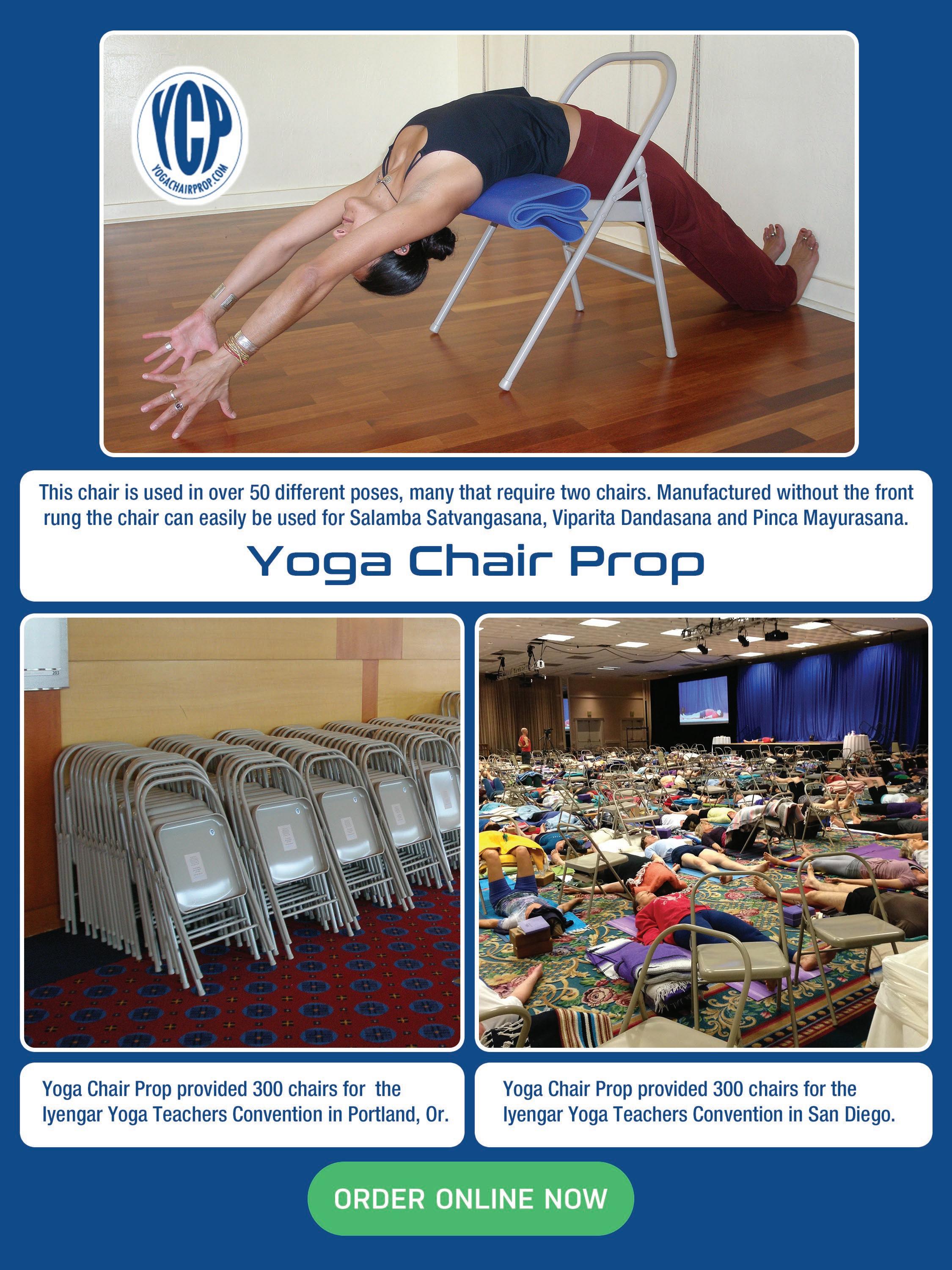
4 The Light | Fall 2022
A Compassionate Eye:
Senior CIYT Rebecca Lerner
BY DAN SHUMAN
Rebecca Lerner is a name that is likely familiar to many Iyengar Yoga students, both in the United States and abroad. A four decades-long practitioner, she operates the Center for Well Being in Lemont, Pennsylvania, where she teaches alongside husband and fellow senior teacher Dean Lerner. She serves both her local community and the broader Iyengar community, including many teachers who travel to Lemont regularly for teacher intensives. (pre-COVID, that is)
I knew Rebecca from her workshops at the Iyengar Yoga Institute of New York, as well as teacher training at the Center. One of the silver linings of the pandemic Zoom era was that I was able to be a regular online student of hers. I draw great inspiration from her ability to teach a varied, multilevel group, creating a truly profound sense of unity. I am grateful that Rebecca granted me an interview, which, originally I had intended to be part of a larger issue on trauma. As with many things, the project changes as you get into the weeds with it. In the end, I feel we have a portrait of Rebecca as a student and teacher that I am sure will be inspirational to our community, and I hope you enjoy it as much as I did! I have edited it for purposes of clarity and readability. —Dan Shuman
TRAUMATIC STARTS
REBECCA: I’d had a horrific trauma on Friday, June 13, 1973. Over the years, I think I identified with my injury and my trauma a lot. As a young person—I was 16—and that was my identity. I wasn’t into yoga or natural... anything. I was living at home, in a tight knit, Roman Catholic family. I was the eldest of six. I didn’t know anything about alternatives, or how to deal with what happened to me on a different plane than the physical. Like, Ok, great, I almost lost my leg and now I’m wearing a full leg brace, and now what?
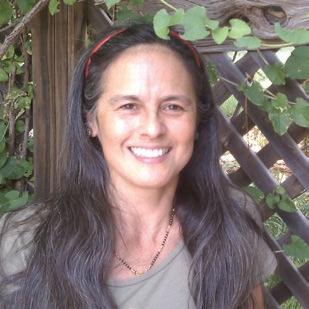
I fell through a greenhouse where I was employed. It was a dumb thing to do, but I sat on the roof. Supposedly, the wooden structure of the glazed panes was really sturdy. But it was an old roof, and I fell through a few panes— buttocks first—and was hanging, suspended there.
I could have crashed to the floor, about 8 ft. below, but I panicked. Maybe I should have just let myself go through, but I held myself up and twisted to get out and jump down from this low roof with a submerged greenhouse. I ended up severing the femoral artery and the sciatic nerve right down to the bone. I remember hearing the blood pouring out of my body, and no one was around. I was crying for help. An employee about my age heard me, and thought very quickly. She grabbed a towel by the pool, and a stick, and crafted a tourniquet up above the injury, to stop the flow of blood. I think I
They were able to stitch everything back up, but I had a permanent sciatic injury.
would have otherwise bled to death. Her intervention basically saved the leg and saved my life. Eventually, the ambulance came. It was all a blur, and I was in shock.
As a young person in high school, trying to blend in, I wanted to be just like everybody else. I was not a renegade person who liked to be different. After the accident, I wasn’t the same. They were able to stitch everything back up, but I had a permanent sciatic injury. I had to wear a full leg brace to my upper thigh crease which was heavy, metal, and bulky. I felt disfigured. And it’s a terrible thing to say. I’m not proud of what I thought, because I believed I would be stigmatized because of the disfigurement.That was my 16-year-old mentality. Now I’m different, and people are going to think there is something wrong with me mentally! Of course, you grow out of that ignorant stage. But, at the time, I had to deal with looks and stares, and being handicapped. It was an egoic blow to be unable to wear trendy shoes and clothing and instead walk about with orthopedic shoes and crutches.
At the time, we were not aware of sports medicine and special therapies. My supportive parents did the very best they could do. I was fortunate to have
The Light | Fall 2022 5
some sessions with a Czech physical therapist who did biosound therapy. It was the first time after the accident I felt that my life might go on. The treatments were meant to trigger the sciatic nerve to bring about dorsiflexion. There was a glimmer of movement in my toes and ankle, but that was it. I discovered I had only plantar flexion and inversion.
FINDING YOGA
Before my accident, I was a gymnast in high school. Afterwards, I lost my ability to engage in that sport as well as other typical fun activities. The world has made incredible advancements to accommodate being physically challenged. There’s a surfer with one leg, marathon blade runners, Special Olympics, etc. But mine was the typical world of the 70s. We were a middleclass, large family without huge resources. We didn’t have connections to specialists or alternative modalities that may have helped.
In 1976, a friend suggested I try yoga, and I purchased Richard Hittleman's 28-Day Yoga Plan. I practiced the poses in my living room, holding on to a wall for balance, as I couldn’t balance independently on my left leg. But I learned the poses, and thought, I love this yoga. And it was only on the physical ‘hatha’ yoga part of it. I wasn’t into meditation or anything spiritual yet. It was more like, Oh, this is something with my physical body that I can do, and I think it’s going to help me.
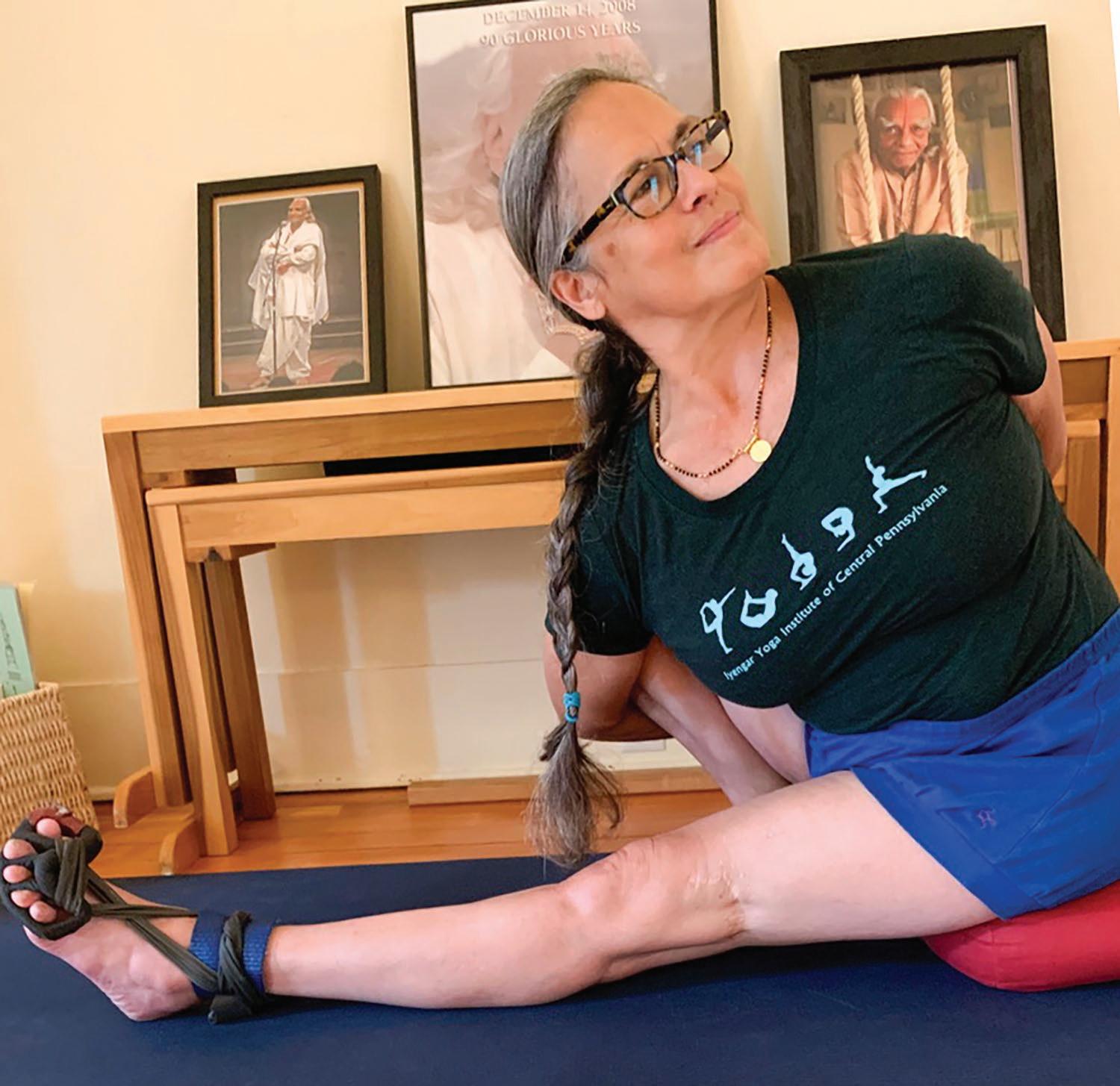
After a while I realized I needed more information. The instructions would refer to breathing, but I didn’t understand when or how to breathe. So the same friend said, “Let’s go take a class.”
That was my first experience. I took off my brace, got on a mat, and did yoga. It was very life-changing for me. I started to experience compassion for myself, and to develop much needed self-esteem. Those weren’t the words I had then, but I can articulate them now, looking back.
I realized I was getting my self-esteem back from the accident but still was thinking only superficially. That was my attitude at the time, but that’s gradually changed over the decades of being involved in yoga. In my classes, prior to the invocation, I’ll sometimes tell my students, “You get entangled in the outer self and the outer identity, the outer narrative, of who you are.”
About three years later, I discovered Iyengar Yoga, and then all hell broke loose! I thought, There is a CHANCE I might cure myself with yoga, and get my properly functioning leg back. While I had great success recovering on many levels, the sciatic nerve did not regenerate to provide strength, structure, and dorsiflexion. I did not develop back pains that can afflict many due to sciatic nerve injuries, but because of my asymmetric gait and limp, my right hip required a replacement in 2007. In any case, yoga gave me a new chance, a new try at feeling good about myself.
The poses were meaningful and strengthened my physical body. Through the physical aspect of asana I became more intrigued with the emotional/mental body where I was still suffering. I thought I was a lesser individual because I wasn’t “whole.” This was very damaging and incorrect thinking. In hindsight, I realize my injury was the best teacher to understand the stronghold the kleshas had on my life. Our physical appearance has nothing to do with mental acuity, or spiritual ability.
6 The Light | Fall 2022
“Don’t practice for cosmetic beauty, practice for cosmic beauty. Practice for inner beauty and inner light.” — B.K.S. Iyengar
I started to experience compassion for myself, and develop much needed self-esteem.
Rebecca Lerner in Marichyasana I
COMPASSIONATE EYE CONTINUED
I didn’t understand the concept of the kleshas , or emotional disturbances, until after 1980, when I became cognizant of something deeper than the physical outer body. Feeling sorry for yourself and feeling dejected are the work of the ego. It fosters a passive aggressive pride that says, I don’t want to go forward, and I don’t want to do anything, because, Why should I? This is self-defeating and does not follow sound yogic philosophy, to be concerned about the impermanence of our human body.
I remember listening to an NPR interview with a fellow who was completely paralyzed, except his big toe. It occurred to me that everything in my body was basically fine, except my lower left leg. Here’s this man who communicates with people by moving his big toe! That really struck me. This interview made me see how one can fall into the trap of feeling hopeless and unable to pick oneself up, and inspired me with his tenacity to thrive. It’s important to be thankful for what you have. Some years after my accident, I was able to cultivate gratitude.
SOMETHING TO OFFER
As I’ve been able to identify more with what I can achieve rather than my limitations, it’s become clearer to me that I might have something to share with people. They might not have a sciatic nerve injury, which is unique, but injuries are not unique. So many practitioners have many obstacles such as osteoarthritis, comorbidities, scoliosis, cancers, aging, etc. People began to ask me about their problems. I think I had empathy, having been there, through a whole range of negative emotions, having practiced classical asanas that are no longer advisable. I would ask myself, "How can I start to adapt certain asanas so they are therapeutically sound and uplifting? I became more and more interested in modifications that benefited me. And I was able to cultivate that eye, that intuition, when working with students.
When I say intuition, I mean it in the sense that everybody has it. Everyone has intuition, and the next step is to tune into one’s inner wisdom/buddhi As I taught more, I developed an interest in helping
others. Helping students online can be done. Modifying poses with commonly accessible props as well as modifying the stages students will potentially be able to accomplish is my goal. Not all will have an array of wooden props found in studios, nor someone to help adjust the props. It's not a perfect situation teaching online, but it is workable.
BREAKING IT DOWN
My teacher Mary Dunn was always supportive and objective when helping me. She'd say, “Rebecca, try this,” and she never made me feel like there were limitations. She was always inspiring. Mary had such a gift for helping others help themselves. That is the goal of my teaching, too. I was inspired by Mary, Guruji, Geetaji, and Patricia Walden. Dean, who has helped me tremendously, is another inspiration. He worked with me to put together my yoga foot brace that I wear while practicing and teaching.
I’m interested in breaking a pose down into its principal actions, its key characteristics, its signature components, the natural way a pose can flow, or how it doesn’t flow. How does one access the fluidity? Where do people get stuck? I sort things out with the use of props, if necessary, and I try to make it an enjoyable learning and discovery process. I do believe that sukha is a very key word—sthira sukham asanam. Sukha is happiness, happiness in the yogic context of neutrality and equanimity, sthira is steadiness.There should be sthira sukham asanam always present in our practice. People have told me I have inspired them to keep going when things get tough. I’m deeply honored and happy that I’ve helped someone feel that they can go a little further. Many of my students are teachers. They find that this approach is helping them be more effective in supporting their students. Just a small way of looking at the asanas with a different eye, a compassionate eye, a friendly eye, an analytical eye. Self-analysis is really important. You have to analyze it for yourself.
LEARNING FROM THE IYENGARS
Guruji gave me the biggest gift of self-actualization. At an early U.S. convention he saw my left leg and said, “Let that side be your guru and teach the rest of you.” I saw Guruji in Pune in '87. He had that critical, objective eye. It was the straight shot of an arrow to the problem
The Light | Fall 2022 7
Everyone has intuition, and the next step is to tune into one’s inner wisdom/buddhi.
with a pose. He taught us the principles of trial and error, comparative study, and judicious practice. Over the years, this has been a motto for me. As Guruji has told his teachers, we need to put ourselves in the students’ situation. He would try to emulate a person’s problem. He could emulate a kidney problem, a neck problem, even a brain tumor, and figure out how to help. Abhi, Geetaji, and many others who worked closely with Guruji speak of his brilliance in this regard. A small atom of that is the ability to have an interest. Mary Dunn always said you have to keep a keen interest, a deep interest in pranayama, in asana. Guruji expected us to dive deep into this subject.
When I began traveling to Pune to study in the late 80s, Guruji was teaching less and less of the public classes, although during the intensives he did teach. I am definitely part of a cohort born and bred in the briar patch of Geetaji Iyengar during the late 80s, 90s, and 2000s. She was holding all of the public classes. I was always impressed with how seamlessly she would teach a pose in stages. Take, for instance, Uttana Padasana. That's a complex pose with the arching of your neck, arms and legs extended out and your back, abdomen, dorsal—How do you get someone into that pose? “Have your knees bent, keep your elbows down to support so you don’t put all the weight on your neck. Get the arm action.”
Look into the Preliminary and Intermediate course booklets. Prime example Utkatasana: arm action followed by leg action, leg action followed by arm action. Arms and legs together. That inspires me. When you learn an important principle of Geetaji’s and apply it to your practice of any particular pose, your understanding deepens. You begin to see where a student might have problems, and you can give them suggestions.
ALL TEACHING IS MULTILEVEL
Our center is a small place, 20 or so students would be a big class. My students are central Pennsylvanian people, with a few advanced practitioners, and our teachers. I went up for my Junior I, II, III, and Senior I Assessments working with my local core group, as well as my outof-town workshop participants. But those came later. I wasn’t doing a lot of traveling in the beginning. Being inspired to keep fresh and teach a Kurmasana action, or Ardha Baddha Padmottanasana upright, or some portion of a challenging backbend. I always thank my Monday morning gentle yoga class of women and a few men at the Center for Well- Being. They were my humble students who would give me advice or say, “This
Something I learned from my first teacher Ramanand Patel is that, when someone is experiencing an emotional breakdown, don’t run, hug, and coddle. Give them space.
variation really worked for me,” and I would say, “Did you know this was the pose you were working on?” And they would be shocked when they saw the picture in Light on Yoga. So my multilevel approach really came about as the result of teaching my local students.
As I developed our teacher education and out-of-town workshops, I was in a bigger community. There were people with different abilities. The challenge is keeping everybody going, enjoying their practice in a community. Some people can do more, some can do less, and, as a teacher, one develops the skill of doing three things at once. Abhi has done that at conventions and online, giving modifications to a wide range of people.
WHEN PROBLEMS ARISE
Something I learned from my first teacher Ramanand Patel is that, when someone is experiencing an emotional breakdown, don’t run, hug, and coddle. Give them space. Don’t immediately try to fix it.
At first it seemed insensitive, but now I see the wisdom. Depending on the student, a teacher shows karuna (compassion), in different situations, upeksha—remaining impartial or neutral. You may have to be indifferent to the fact that they are having a breakdown, but make them feel comfortable to be in class, should they choose to remain. Indifference may sound crude to some people. Strive to keep your pace as a teacher without drawing too much unwanted attention to the student. Always follow up after class with sincere support.
I remember teaching at Feathered Pipe Ranch and someone was having an emotional time. I didn’t know what was going on. So I changed the format of the class with students in standing poses facing the other direction to offer privacy to this particular student, so they could be free with their emotions in Adho Mukha Virasana. Afterwards, we talked.
You want to be able to support students, and you don’t always know what their background is. This is why cultivating sensitivity, maitri (friendliness), karuna
8 The Light | Fall 2022
COMPASSIONATE EYE CONTINUED
(compassion), mudita (joy), and upeksha—neutrality is necessary for all yoga teachers.
COMMON SENSE
Common sense is not common to you until it becomes a particular part of your mental bank of memories, thinking process, and your being-ness. Common sense does dawn on you at some point. Studying with Geetaji, I would frequently think, “Why did I not think of that myself?” Now, I’d like to think I am able to apply her principles of common sense! Geetaji is no longer with us, but she’s always with us in our hearts. Her legacy, like Guruji’s lives on. She’s always with me. Her teachings were so impactful and so deep. I still listen to her recordings frequently.
CONTINUING TO LEARN
I recently took a class online with Abhi where she used the chair to twist in a way that was so effective, and new to me. My eyes opened up. We are always students at heart and I do my best to catch as much as possible of Abhi’s teaching. I want to pass that feeling on to students to help them see and do more, and be more alive in their practice and teaching.

Our teaching is unique to us because of our own experience, but our foundational fundamental learning has come from the Iyengars. Don’t get me wrong, we all have plenty to contribute. I find myself taking one aspect of a particular teaching point of Geetaji’s and developing a whole class with this in mind. We give credit to the Iyengars, and take credit for what we develop in our own practice. Humility is necessary to remain a student of yoga.
MOVING FORWARD
Iyengar Yoga is moving. It’s fresh, and it’s going with the times. Many senior teachers are in their 70s now. Everything is changing. We are aging. As our practices change, the way we teach is going to change. I love that, in this system, we address the needs of so many different students. We have to pay attention to the younger students coming up, and guide them to feel fulfilled. We consider those in the class who can do more, and inspire them. So it isn’t just us old folks showing, “Here is a chair, here is a block, here are multiple props.”
Multifaceted teaching, the ability to teach in this stellar way that is expected of us, keeps us alive. It keeps us teaching longer, because we are held at attention with what we’ve learned, yet we can go with what we are personally capable of doing.
I’ll tell you there are a lot of poses such as arm balances that I can no longer complete as when I was younger, due to shoulder problems, hip replacement, and leg issues. Like anybody else, there are problems that arise along the way. But I still feel motivated to do things. I recently taught an arm balance class, and said to myself, “Wow, these movements are hard for me!” But I wanted to take it as a challenge, to help people help themselves. Those who can’t do the classic pose will see, “Oh, here’s what I can do. I can go this far, and others can go farther.” As a student, teacher, and mentor, I’m on my toes staying alert and present. Being in the present moment without regrets that certain asanas within my practice are over for me. Religiously maintaining my daily pranayama and meditation practices is essential. How else do we stay fresh, alert, and honest?
Whether a seasoned practitioner comes to class, or an aging, long time beginner, I’m held accountable. Thanks to the Iyengars and all my mentors, I feel motivated to keep a high standard; it keeps me alive as a practitioner and, as a result, keeps teaching fresh.
The Light | Fall 2022 9
Humility is necessary to remain a student of yoga.
Rebecca Lerner in Dwi Pada Viparita Dandasana


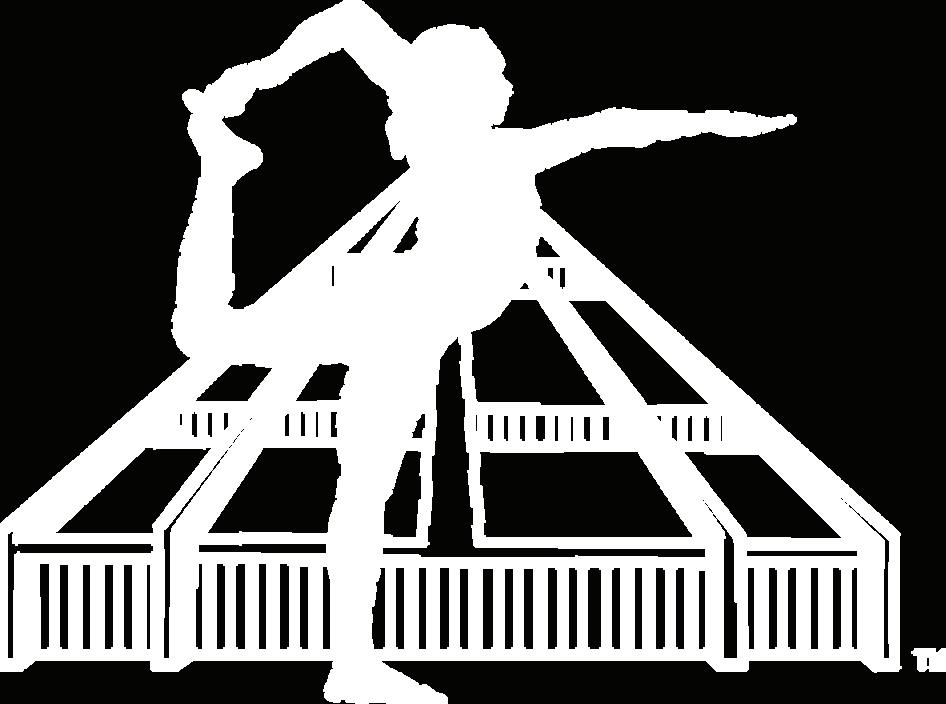
10 The Light | Fall 2022 Iyengar Yoga with Brian Tradition • Learning Practice • Study • Teaching www.iybrian.com
From Breath to Prana:
A Review of Prashant Iyengar’s Educational Lectures on Pranayama
BY PAULINE SCHLOESSER, PH.D
This article is a continuation of a project to bring to light Sri Prashant Iyengar’s lectures on YouTube. Here the focus is on 10 lectures (Sessions 25–34) dedicated to the subject of classical pranayama. Prashantji’s lectures contain many complex ideas; so many that it would be impossible to summarize them all in a few short paragraphs. Instead, I have identified a few of Prashantji’s central aims that seem to connect the lectures.
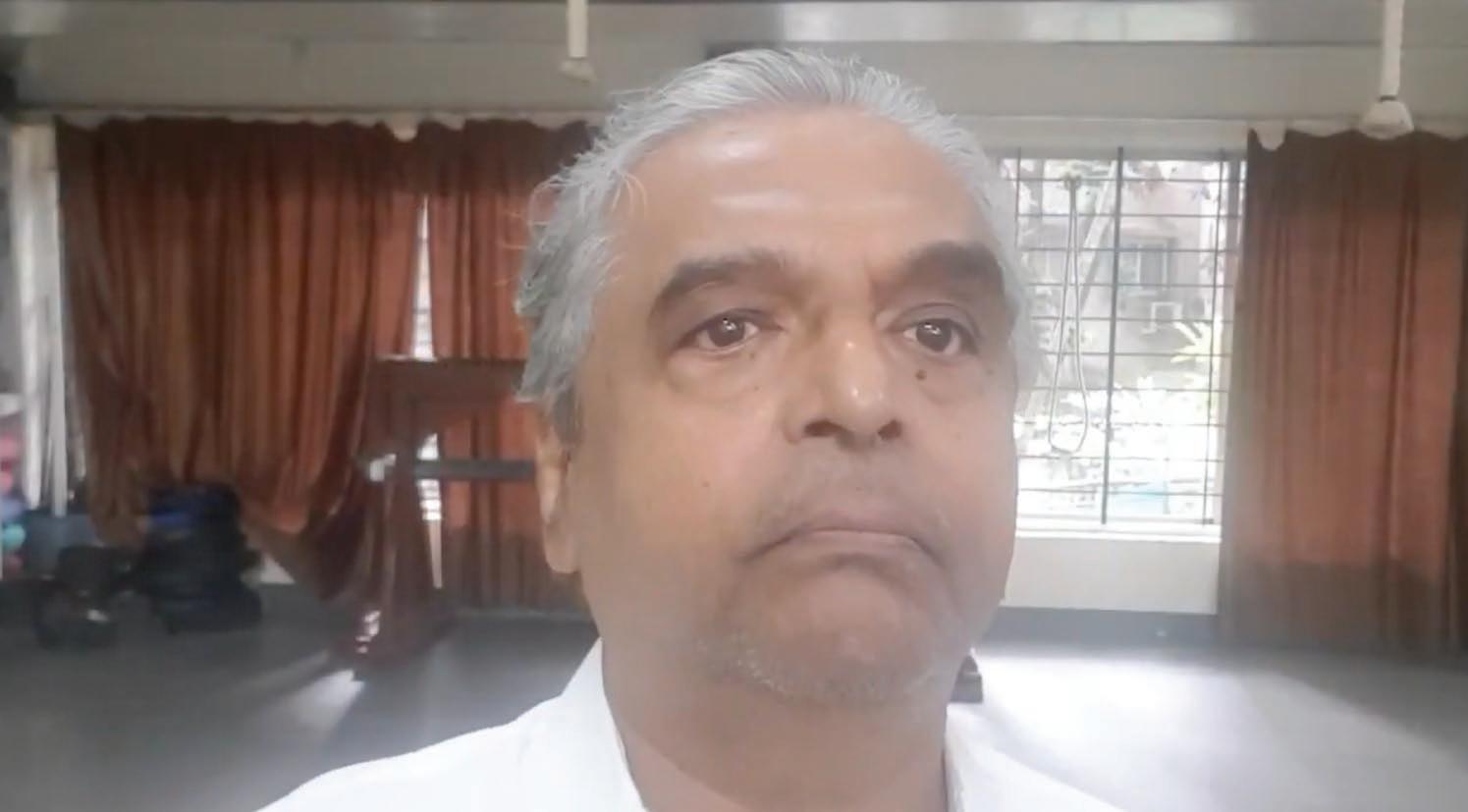
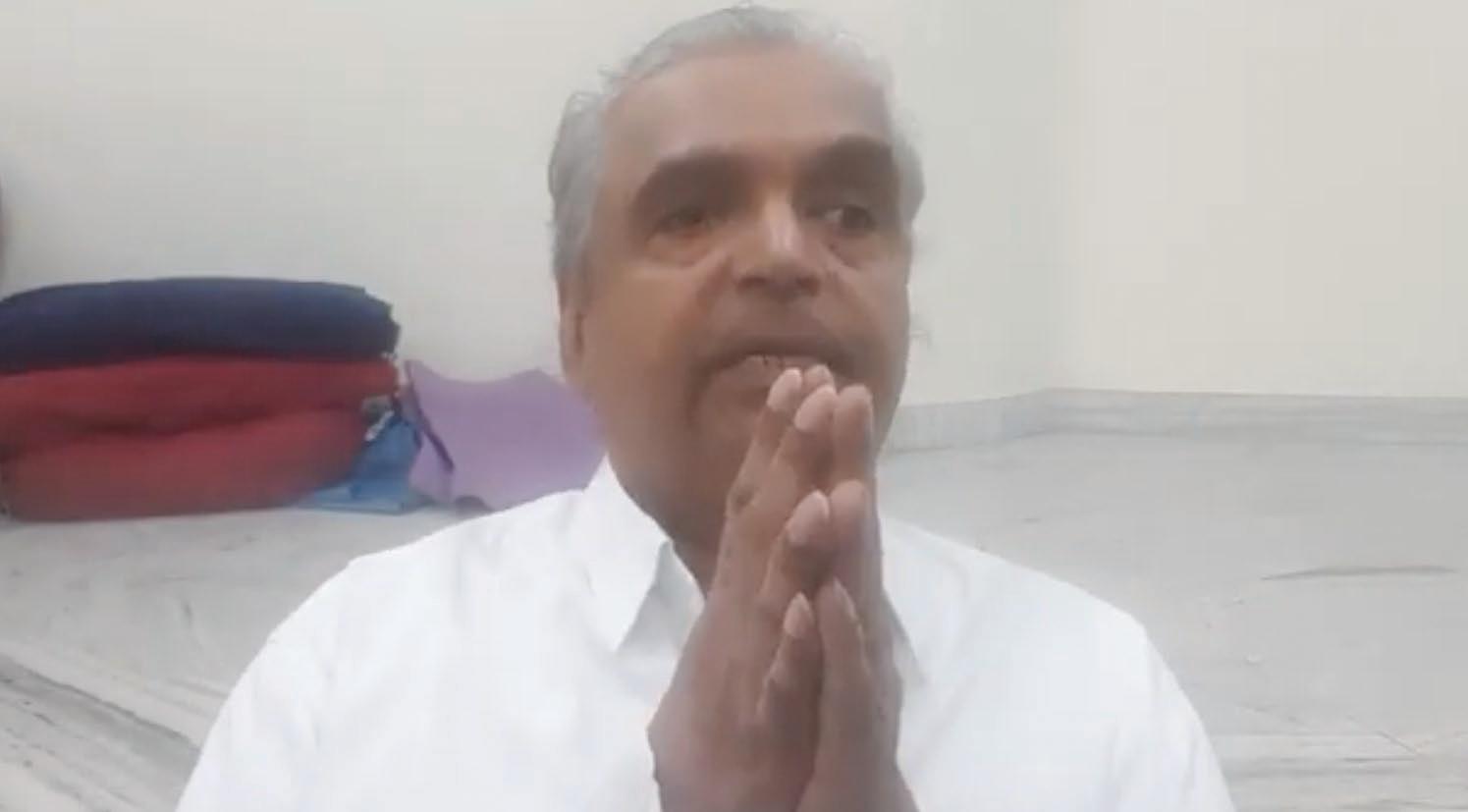
These include:
•
An attempt to define classical pranayama in its mystical and philosophical context
• A contrast between classical pranayama and what is commonly taught as pranayama today
• Practical demonstrations, through conducted audio classes, of shvasayama and pranayama to illustrate his points.
• An argument for the necessity of pranayama for any serious yoga endeavor.
What follows is a brief introduction to each lecture, with a link to the actual lecture on YouTube.
Pranayama is much more than the voluntary manipulation of breath or nostrils. Pranayama is regulation of prana, or life force.
Session 25: Koshas as the Context of Pranayama

Session 25
backdrop for understanding pranayama. In this session, the observation and regulation of breath (shvasayama) is distinguished from the regulation of life force (pranayama). And the first of the five koshas, annamaya kosha, is described.
Session 26: Pranayama Works through the Pranamaya Kosha
As yoga has become popular, more people have been introduced to pranayama. But it is not really pranayama in the classical sense. Pranayama is much more than the voluntary manipulation of breath or nostrils. Pranayama is regulation of prana, or life force. And this has to be understood in reference to the pranamaya kosha. Therefore, the entire kosha system must be the
You know that you feel good after a session of what we call pranayama, but did you know genuine pranayama works to transform our personalities? This happens when one accesses the pranamaya kosha, which houses the six chakras. Prashantji explains that the chakras have everything to do with our deep-seated tendencies, or vasanas. Each chakra governs a different set of tendencies, from our survival habits to our sense of identity, to our heart-filled passions. Pranayama helps us to burn the six enemies: anger, greed, delusion, pride, envy, and infatuation. So if we want our yoga to evolve towards samadhi, pranayama is essential. And if samadhi is out of reach, pranayama works on our culturing of our consciousness. This is because pranayama gives access to the pranamaya kosha The six chakras and their governances are described in this session. The importance of managing this inner infrastructure through pranayama is an essential key to spiritual culturing and development.
The Light | Fall 2022 11
Session 26
Session 27: Mystical Aspects of Pranayama and Manomaya Kosha
Session 28: Vijnana and Anandamaya Koshas and their Atmas
Session 27 Session 28
Before continuing his discussion of the koshas, and manomaya kosha in particular, Prashantji introduces us to the mystical aspect of sound forms as Shakti, or divine energy. These divine energy forms are necessary for essential pranayama, which has the power to work on our vasanas, and thus our destiny (prarabdha) in life. We learn that each of the six chakras has a letter form, called an akshara. These aksharas are indestructible forms of shakti. We start with “la,” “va,” “ra,” “ya,” and “ha.” If you combine each of the vowel sounds with each of the consonants in Sanskrit language, you get a myriad of divine sounds forms that resonate uniquely in the human embodiment. The silent chanting of Sanksrit sounds are the secret technology of vasana management in yoga.
A second theme is the five pranas: apana, prana, samana, udana, and vyana, which are energies that govern different parts and functions of the embodiment. The third theme is the glory and divinity of the nostrils. Yoga shastra has postulated “twin divine physicians” who guard the nostrils and keep impurities out. They are called “ashwini kumars.”
Then there is a continuation of the five koshas with a discussion of the third kosha , the manomaya kosha Manomaya kosha should not be interpreted as “mind.”
Rather, the manomaya kosha holds our karmas that will manifest in future lives. Yoga lore holds that there are 8.4 million classes of life, and we have been all those 8.4 million life forms before. The karmas of these lives are stored in the manomaya kosha. Our future incarnations will be directed by this storehouse in the manomaya kosha
More discussion on koshas takes place here; the vijnanamaya kosha is defined as containing the inner Self, the transcendent individual atma, who is free from karma and the effects of karma. Then anandamaya kosha is described as the “divinity zone,” “Isvara,” “Brahma,” or “antaryami” within us. Whereas we have some access through our intellect and senses to the first three koshas, the last two are transcendent and inaccessible to the mind. The koshas are also richly described as atmospheres having their own atma, like the sun has an atmosphere called the corona, and its center, called the core.
Just regulating the breath will not be pranayama, and you will not have the profound effect on mind and tendencies.
Pranayama works on annamaya and pranamaya koshas; and this is the context for traditional pranayama in yoga. If you know the technology of tattva kriyas and mantra, you can reach the pranamaya kosha in pranayama and transform your habits, habitual mind, tendencies, and personality. If you are not working with sound forms (bija mantra, tattwa kriya, or vowel sounds) you will not be doing pranayama, but you’ll be doing “shvasayama.” Even shvasayama is a step up from what is commonly touted as pranayama in consumerist culture where what is called “pranayama” is indistinct from mere respiratory regulation. Just regulating the breath will not be pranayama, and you will not have the profound effect on mind and tendencies. That is why it is important to start working with sound forms.
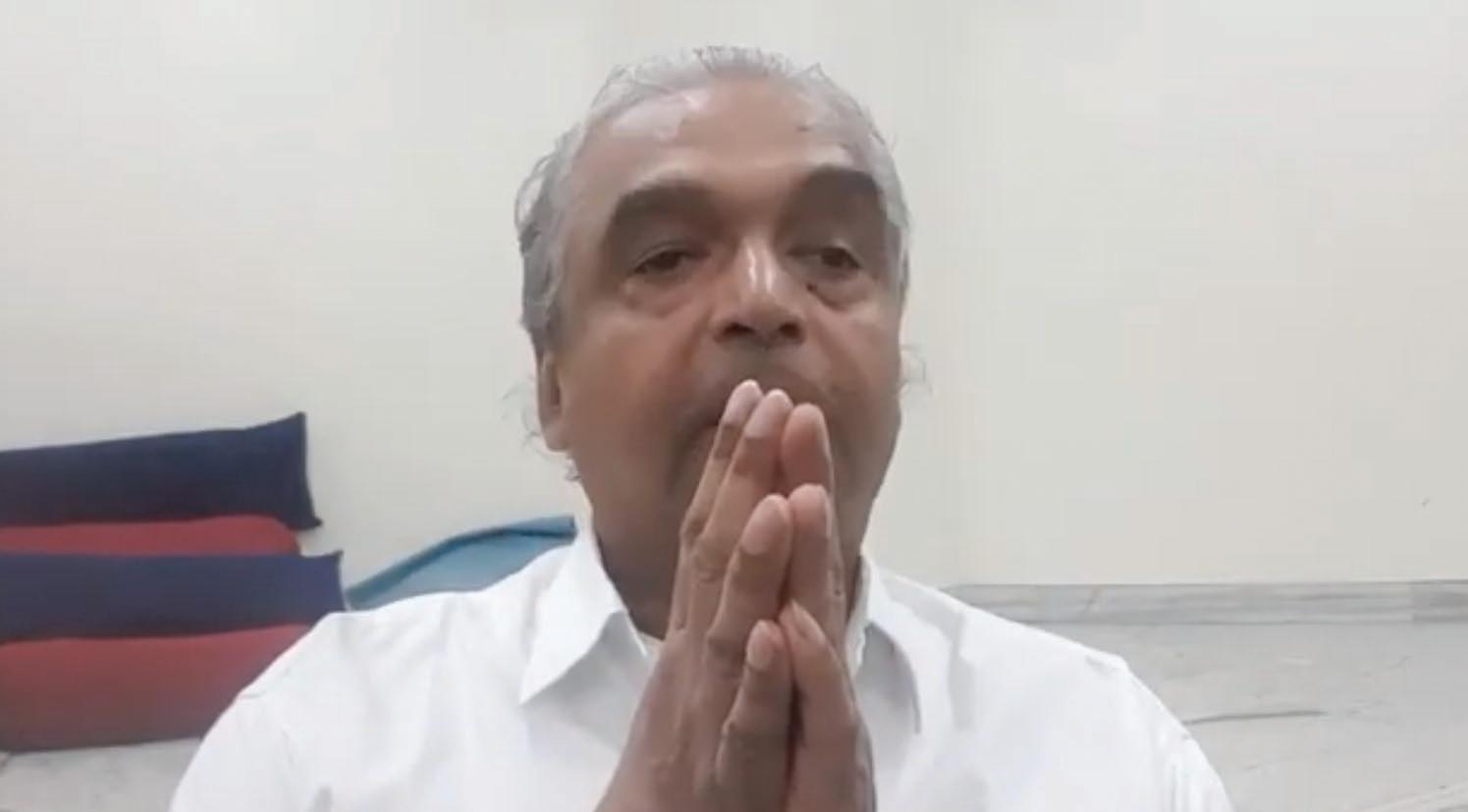
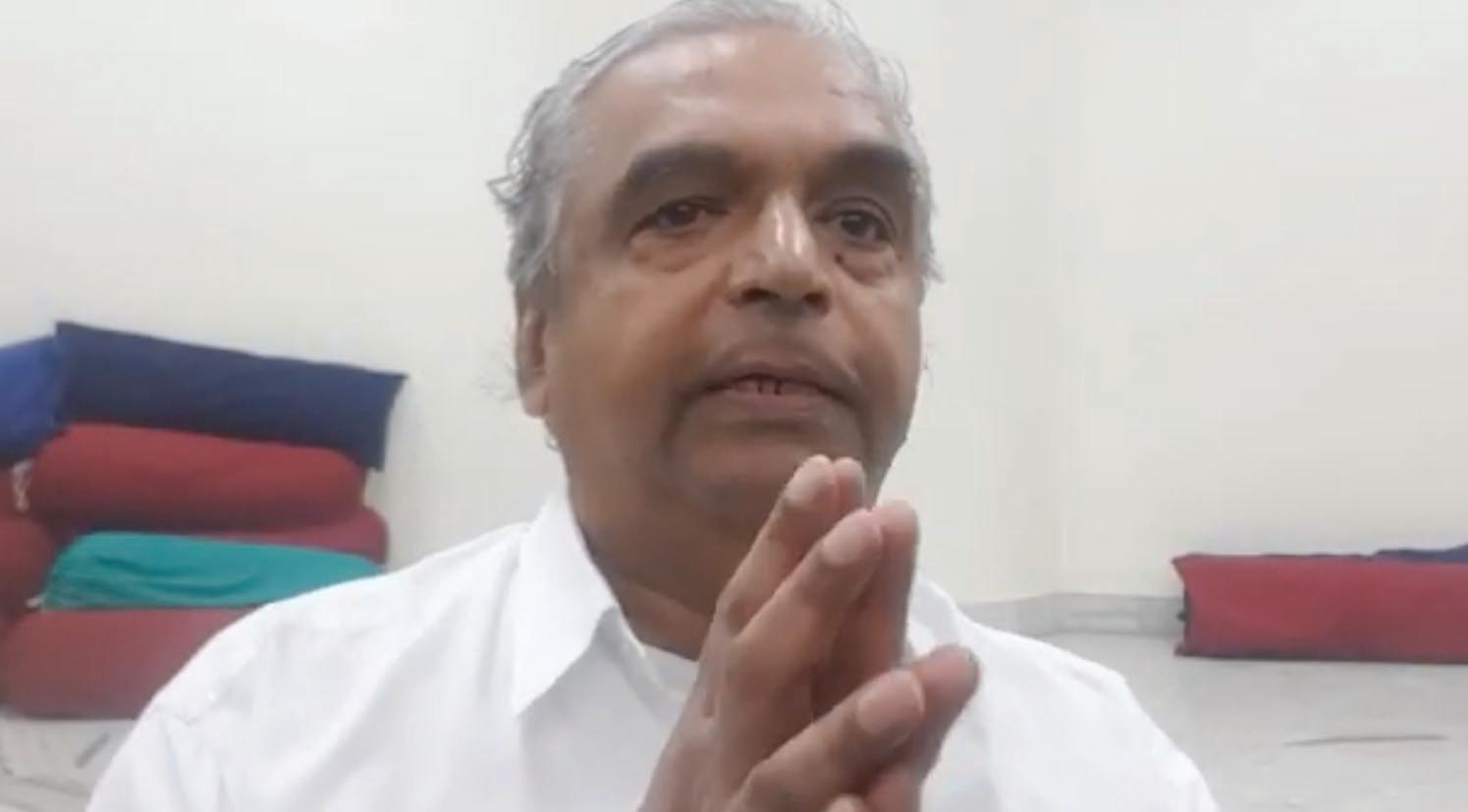
12 The Light | Fall 2022
FROM BREATH TO PRANA CONTINUED
Session 29: Factors that Distinguish Genuine Pranayama from Mockery
•
No understanding of how asana relates to pranayama, or how asana educates us about the breath, breathing, and prana
•
As a corollary, classical pranayama comes within a proper context of adhyatma (spiritual quest) and mysticism, such as the esoteric physiology of the pranamaya kosha.
•
It might also be noted here that pranayama is related to asana by Patanjali in the scheme of Ashtanga Yoga
Session 30: The Difference between Shvasayama and Pranayama
One of Prashantji’s frequent lecturing techniques is to define a concept by what it excludes. Here he defines classical pranayama by divulging how popular or consumer pranayama is a mockery. Today’s popular notion of pranayama is not classical for the following reasons:
• Dealing with the breath as merely respiratory breath; that is making reference to lungs and inhalation and exhalation (which assumes a temporal, empirical mind, not the associated or cosmic-alized mind).
• Ignorance of the pranayama mudra, its context, or even the basic understanding that it is not necessary to block the gates of the nostrils and deviate the septum to control breathing passages in the nose.
• Ignorance regarding the pranamaya kosha in the context of the other koshas; and failure to place pranayama within the context of the pranamaya kosha
• Lack of appreciation for all that the breath does in the external realm as well as the internal realm.
• Ignorance of the five pranas and their different functions.
• Lack of any reference to the distinction between pranayamas which employ the use of mantra and those that do not.
• Lack of reference to prana kriyas (350 sounds forms) or vacchika kriyas (the speech-ly acts) in asana and pranayama and their powers.
Do you know the difference between pranayama and shvasayama? For many years now, Prashantji has been trying to tell us that what passes for pranayama in pop yoga culture is actually shvasayama (Shvasa = breath; ayama = regulation). Pranayama is regulation of prana, vital energy; Shvasayama is regulation of breath.
It’s not that Shvasayama is bad and pranayama is good. Shvasayama is a necessary precursor to pranayama. Studying the breath, then regulating the breath is done before prana kriyas, tattva kriyas, and chakra kriyas; it is also done as a break after a certain set of kriyas has been performed.
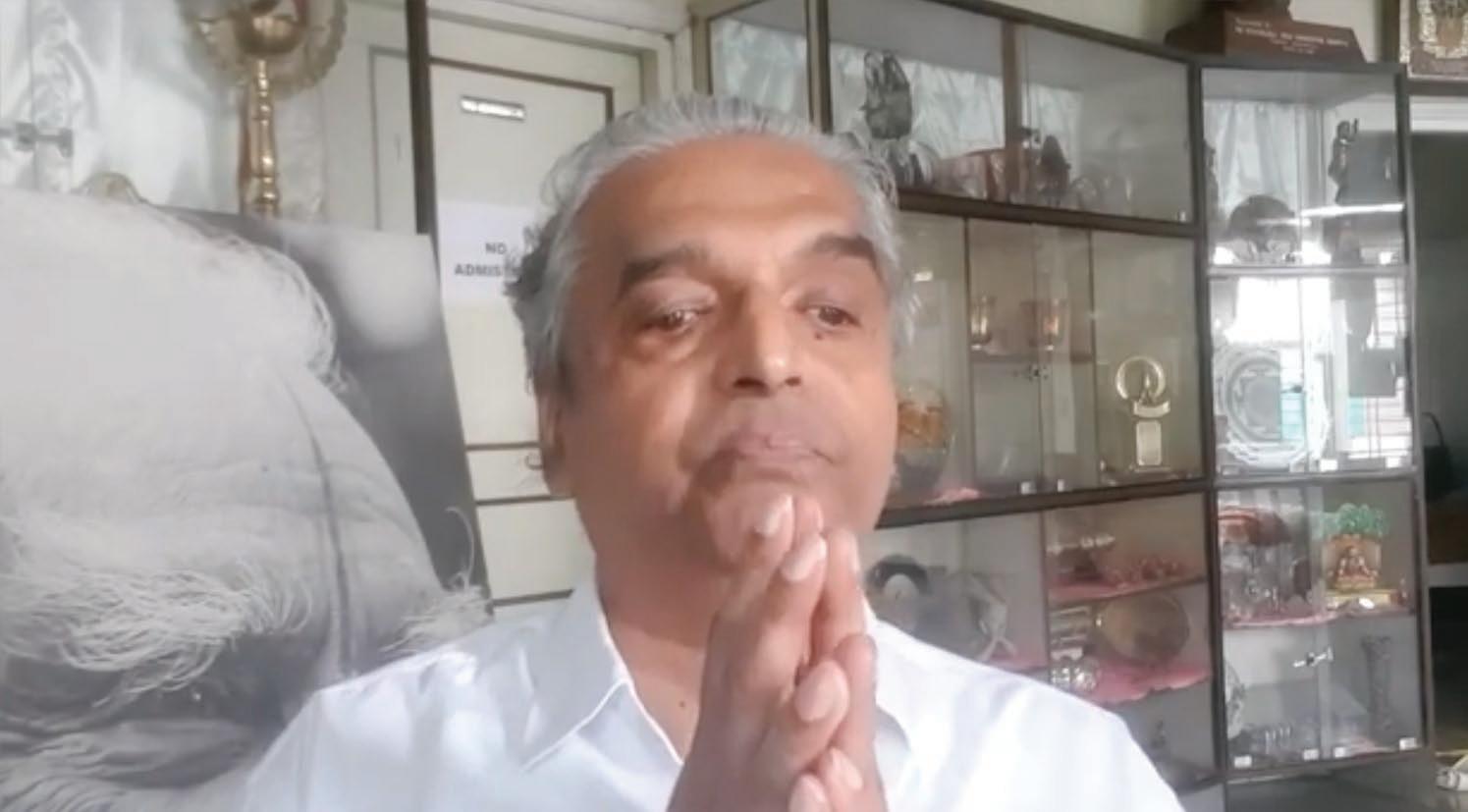
But in pop yoga culture, no one seems to understand this distinction. What they are presenting is actually shvasayama and not pranayama. Moreover, gross and low-tech blocking of nostrils with the fingers is presented as digital pranayama . As discussed in the previous lecture, there is a traditional pranayama mudra that must be played delicately on the bridge of the nose, with tips of the thumb joining those of ring and small finger. Then, the placement of the fingertips is specific to the cartilage just beneath the bony
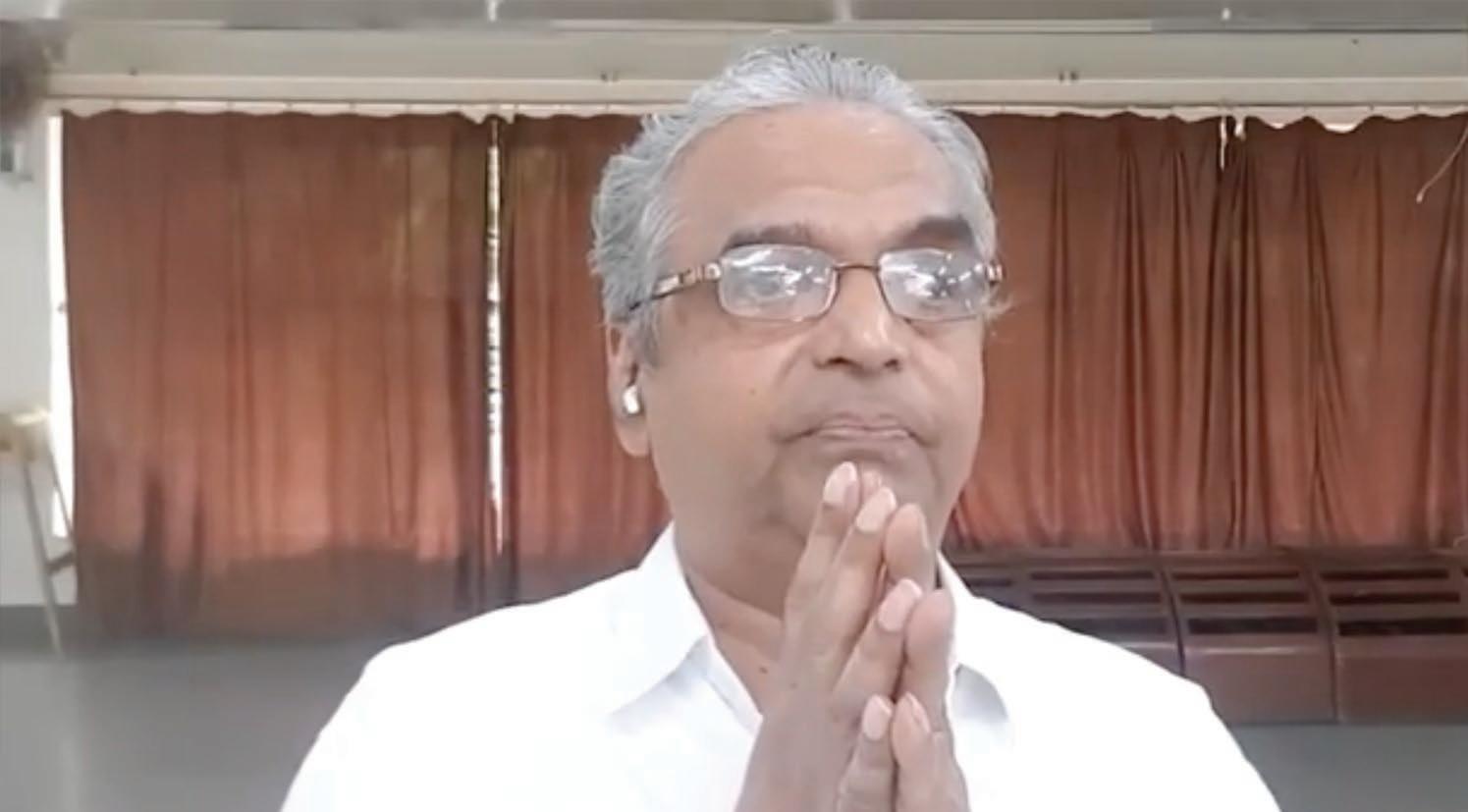
The Light | Fall 2022 13
Session 29
Session 30
structure of the nose. The hand should be thought of as a beautiful “ornament.”
A very important aspect of the breath that goes unnoticed in pop yoga culture is its freedom from karmic shackles. Now here is a fascinating discussion of how the practice of real pranayama leads toward moksha, liberation. You’ve always known you should practice pranayama regularly, but why? It is not about respiratory fitness or health; pranayama is intended for the culturing of consciousness that can put us on the road to samadhi.
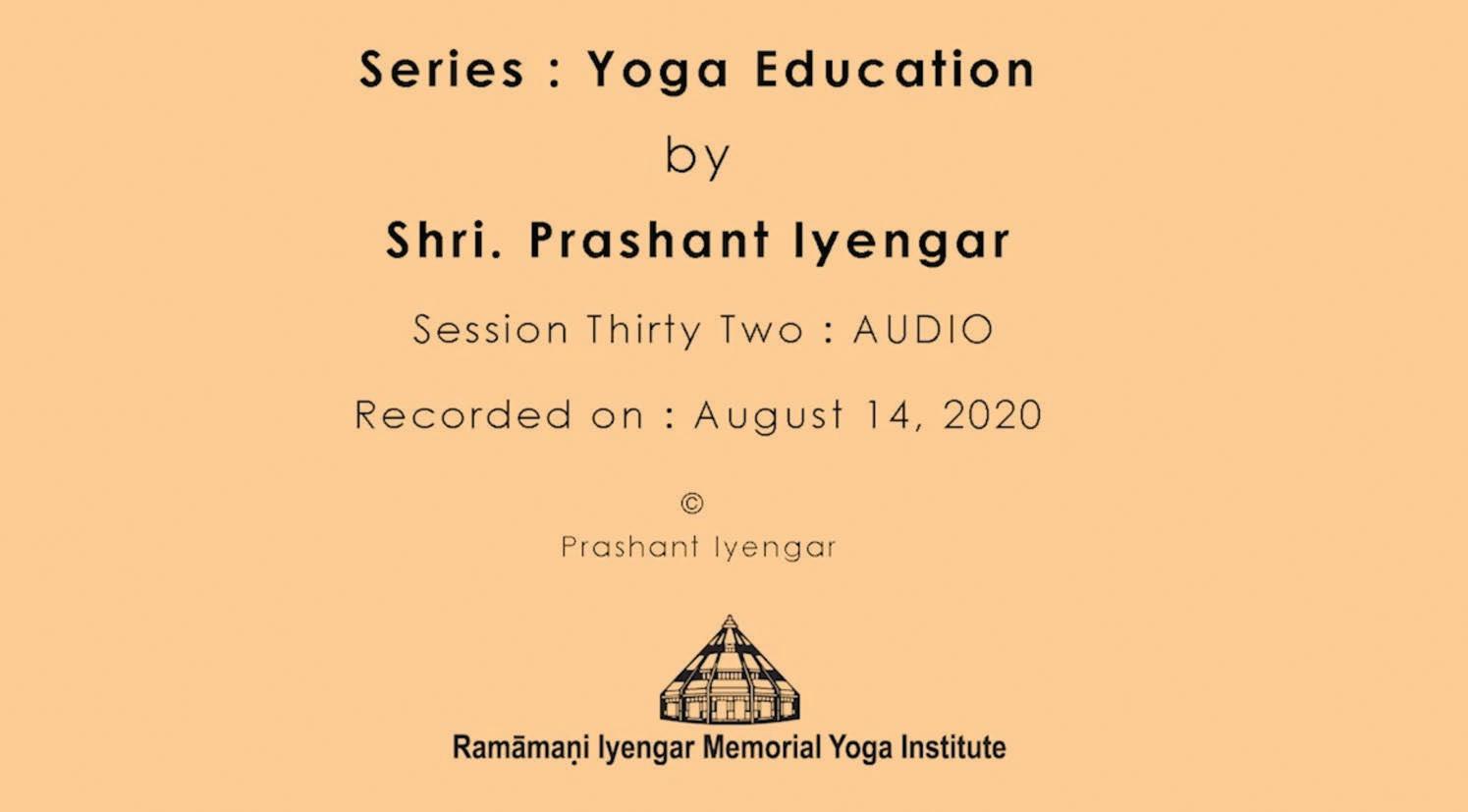
While the mind and body are limited by so many factors, including karma, the breath is like a newborn baby every cycle. It is pure and available to us, most of the time working for us, in every act, thought, and emotion. For every act, there is a corresponding breath that allows it to happen. For every emotion, there is a typical kind of breathing pattern. For every state of mind, there is a corresponding breath. These things need to be observed, studied, and understood before one undertakes pranayama
To give us a taste of the kind of shvasayama, that prepares one for pranayama, Prashant conducts a short class. We are asked to perform some supine asanas and start observing the breath. Then we get into the interactive culture of body, breath, and mind systems working for mutual benefits. After some time, “uddiyanic mannerisms” are suggested, whilst observing specific regions of the body. We are instructed to change the nature of the breath: from thick and pneumatic to thin and rarified. We are encouraged to observe the distinction between breath “ploughing” and breath “seepage.” Then we are introduced to “graphic modes” of the breath. These are some of the gems regularly given in Prashantji’s pranayama classes. Of course, the result is a progressively cleansing and soothing experience that takes the mind into what Prashant likes to call “meditativity.”
Session 31: Breath is the Vehicle for Prana
Did you ever wonder where prana would fit on the Sanhhya table of metaphysics? Well, if it’s not Isvara or Purusa, then it has to be Prakrti, right? As it happens, according to at least three different Shastra sources, Prana is on the level of Buddhi tattva, which is one generation down from mula prakrti
The import here is that if we have access to prana, we can involute, dematerialize, and transform from our mind, intelligence, and identity to citta—the cosmic consciousness. We can take ourselves back to nearly the subtlest form of prakriti by becoming absorbed in prana And yoga technology of pranayama does just that.
Prashantji divides the mind into two categories: vasanic mind and pranic mind. The normal, everyday mind we use in the business activity of life is vasani; it moves with our preferences and aversions toward and away from various external objects. Then there is the mind that is conditioned by pranayama: the pranic, purified, and cosmic-alized mind.
Session 32: Patanjali’s Criteria for Pranayama
Having explained the necessity of using sound forms for breath to become pranic, Prashantji now

14 The Light | Fall 2022
FROM BREATH TO PRANA CONTINUED Session 31 Session 32
A very important aspect of the breath that goes unnoticed in pop yoga culture is its freedom from karmic shackles.
reviews other criteria for pranayama, from YSP II. 50. “Bahyabhyantara Stambha Vrittir Desa Kala
Sankhyabhih Paridrsto Dirgha Suksmah.” If Paridrstah is regulation, it is to be applied to place or region (desa); to the issue of timing (kala); and performed repeatedly (stambha vritti ).
So, pranayama cannot be just watching the breath and having slow soft inhalations or exhalations. We’ve already seen that traditional pranayama is done with sound forms to access the pranamaya kosha. But now Patanjali tells us that there must be Desa Paridrstatah: a mental focus on a specific region in the body. In Prashantji’s classes, these desas number five or six: the head, chest, upper abdomen, lower abdomen, pelvic floor, and sometimes the back. Obviously, we are not dealing with respiratory breath here. We are dealing with esoteric anatomy: breathing channels or “nadis” said to exist all over the embodiment. The location or region qualification is about mind sensitivity of breathing channels in whatever region you have chosen.
Kala Paridrstatah, or timing of the breath cycles, has to do with volume and velocity of breath. So we can increase the volume of the breath by shortening the duration of a cycle in a thick, quick inhalation or exhalation. Or we can increase the volume with a longer, thinner, more rarefied breath. Kala is managed by regulating the speed of inhalation or exhalation as well as the volume of breath handled.
Then, Sankhya Paridrstatah requires that there must be repeated identical cycles: they must be focused on the same particular region, with the timing (velocity and volume), to qualify as pranayama. If you have not chosen a region for the sensitivity to observe, or if you are changing the velocity and volume every other cycle of breath, this is not yet pranayama. We may start like this, but eventually we have to have repeated consistent cycles to get toward pratyahara, dharana, dhyana, and samadhi.
Session 33: Nostrils and Prana Kriyas Are High-Tech Means to Divinity Within Us
Here we have a session in which Prashantji conducts a pranayama class. With a spotlight on the marvels of the human nostrils, we are educated about their parts and the mysticism of the divinities that guard the gates of the nostrils. This orientation is important to sensitize us to the importance of nostrils and their parts: membrane and membrane carpets, septum, floor, roof, and outer gates.
Next Prashantji educates us about prana kriyas. These are divine sound forms, called matrikas in the mantra shastra. Using the vowels as sound forms, we discover that the pathways of the breath and prana will change in the nostrils, depending on which vowel you use. That is why, in esoteric yoga, pranayama is considered “nada sadhana,” or a practice of sacred sounds. The sounds channelize the breath into prana nadis, or internal rivers of divine energy. And this is the essential difference between shvashayama (mere breath regulation) and pranayama, regulation of life force.
Prana is the manifestation of Devi within us, he says. The same sound forms (a to ksa) that unfolded the cosmos can be utilized within us to expand the consciousness. So also for sacred names, like the 1000 names of Visnu, or Devi, and mantras. There are too many kriyas listed to recount, but the important point is that using sound forms is high technology for reaching the pranamaya kosha, and these must be done within the parameters set out by Patanjali in combination with place, timing, and repeated cycles.
Session 34: Pranayama Opens the Corridor to Samadhi

Pranayama does not happen without Sanskrit sound forms. These could be vowels, combinations of consonants with vowels, sacred mantras, or names

The Light | Fall 2022 15
Session 33 Session 34
The sounds channelize the breath into prana nadis, or internal rivers of divine energy.
FROM BREATH TO PRANA CONTINUED

of deities. This should be understood prior to digital manipulation of the nostrils. Otherwise, we might fall prey to the common notion that anyone and everyone can just start blocking their nostrils as in anuloma, pratiloma, nadi shodhana, etc., without understanding the traditional context of pranayama, which is adhyatma, or the spiritual quest to realize God or realize the Self. It won’t work to reform the citta
Pranayama makes us feel serene, sublime, and wonderful. But this is not its traditional purpose. According to Patanjali, pranayama has one purpose: to launch us to the inner limbs of yoga (antaranga sadhana), by removing the veil of ignorance covering our inner light. YSP II.52 says “Tatah ksiyate prakasavaranam.” From that (pranayama) the covering of illusion (avaranam) is destroyed (ksiyate). Then YSP II.53 says, “dharanasu ca yogyata manasah.” Fitness and qualification (yogyata) of the mind (manasah) for concentration (dharanasu) are rendered.
In our consumerist culture, we are always looking for what asana or pranayama can do for us, Prashantji notes. So we may approach pranayama as something that will make us feel good. Prashant wants us to place asana and pranayama in the context of Patanjali's Ashtanga Yoga. There we see that the purpose of asana is to prepare the mind for pranayama. YSP II.48 says “tatah dvandvah anabhighatah,” from mastery of asana (tatah) there is a cessation of disturbance (anabhighatah) of dualities (dvandvah). So the unafflicted mind is the outcome of asana in a classical sense, not physical fitness. Similarly, the outcome of pranayama in the classical sense is to launch us into samyama, the antaranga sadhana of dharana, dhyana, samadhi, and not to make us feel relaxed and content. “Pranayama is a corridor,” Prashantji says, “and all meditation must be launched by pranayama.”
Pauline Schloesser, Ph.D., CIYT-Level 2, C-IAYT, lives in Houston, Texas, and teaches in her studio, Alcove Yoga. She is currently working on a collaborative project to transcribe Prashant S. Iyengar’s series of lectures on YouTube.
16 The Light | Fall 2022
The unafflicted mind is the outcome of asana in a classical sense, not physical fitness.
Asana
The Power of Inversions Heart and Circulation Upside Down
BY ROGER COLE, PH.D. INTRODUCTION
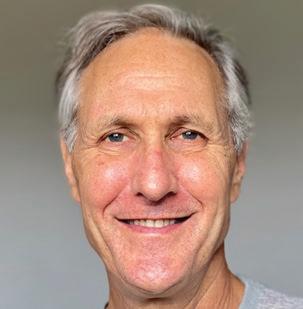
Here’s a guide to deepening your experience of inverted asanas by applying science to practice. Inversions, when performed skillfully, redirect fluid flows and pressures in your body in ways that can improve your health and quiet your mind.
B.K.S. Iyengar famously said, “Yoga is a practical art,” meaning that when you practice, you reap practical benefits. You’ll get the most out of this guide if you do the quick practice demos suggested along the way.
We’ll focus narrowly on blood circulation and the heart because this lays the foundation for understanding how inversions also affect fluid flows in the lymphatic system, brain, lungs, and elsewhere. We’ll emphasize two of the most useful effects of inverted asanas (1) draining and filling, and (2) stimulating reflexes.
Draining and filling refers to draining fluids away from one part of the body and filling up another. For example, elevating the legs enhances circulation not only by helping blood drain out of leg veins, but also by increasing the pressure, and therefore the volume, of blood filling the heart.
Stimulating reflexes refers to activating fluid pressure sensors to trigger beneficial physiological responses. For example, increasing the volume of blood filling the heart triggers a set of reflexes that, over time, can reduce your body’s overall blood volume. Reducing the body’s blood volume can lower blood pressure.
Although inversions have well-documented, important physiological effects, there is not enough clinical evidence to justify making medical claims about them, and some inversions may be risky for some people. Only attempt poses that you know are safe for you, and only teach poses that you know are safe for your students. If you have any doubts, or have a medical condition, or want to use yoga as therapy, please do it only with the approval and supervision of qualified medical professionals.
Practice Demo Round 1
Before we dig into the science, now would be a good time to do the first practice demo, if you are willing and able. It should only take a few minutes. It will help you intuitively understand the anatomy and physiology of inversions in ways that could never be expressed in words or pictures. We’ll revisit the same practice later.
To practice, simply get into the postures listed below one after another, doing the sequence first in forward order, then in reverse order. Stay in each position very briefly — just long enough to get a sense of how it feels, then move on to the next one and compare how it feels. (This is harder than it sounds, because the poses feel so good you’ll probably want to stay in them much longer.) If you can’t do all the poses, just do the ones you can. Set up your props in advance if possible (see photos).
Sequence (10 to 30 seconds per posture):
1. Tadasana (standing upright)
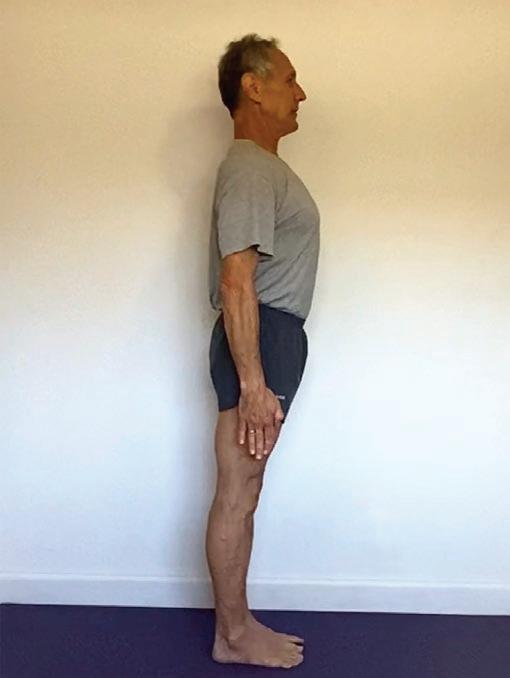
The Light | Fall 2022 17
ON
Asana 1. Tadasana
2. Supported Savasana (lying with legs and pelvis on the floor, back elevated on long folded blankets, head supported higher than the back.)
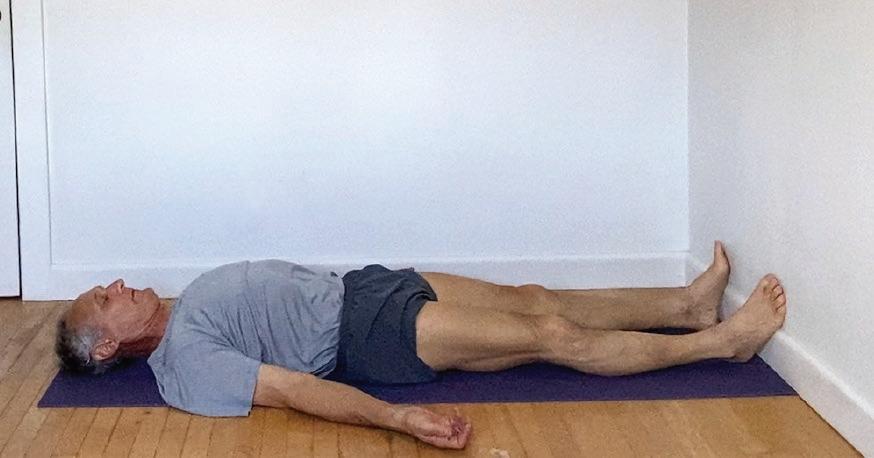
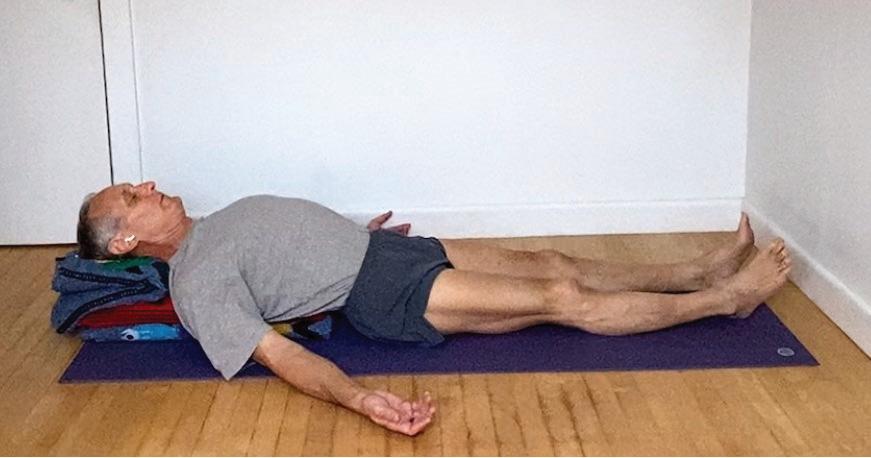
5. Viparita Karani (lying with pelvis elevated on stacked, folded blankets, legs up a wall, chest lifted, tops of shoulders and head on the floor)
3. Savasana (lying flat with legs, pelvis, trunk, and head all on the floor at the same level, or as close to level as you can comfortably manage)
5.5 Add a head support to Viparita Karani
4. Supported Urdhva Padasana (lying flat with legs up a wall, and with pelvis, trunk, and head all on the floor at the same level)
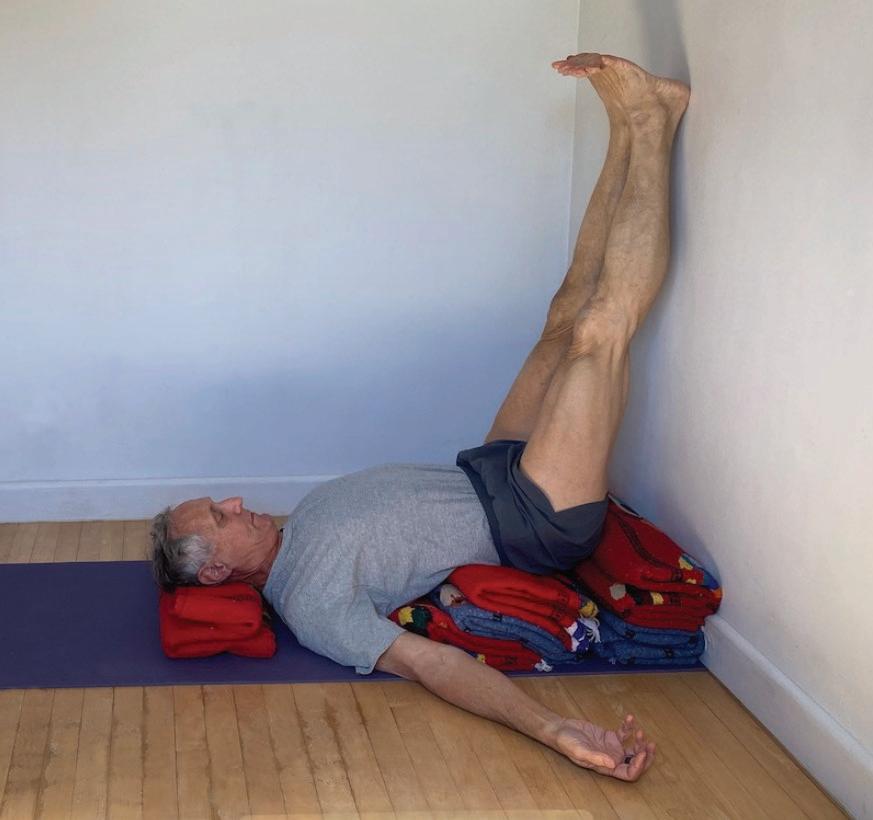
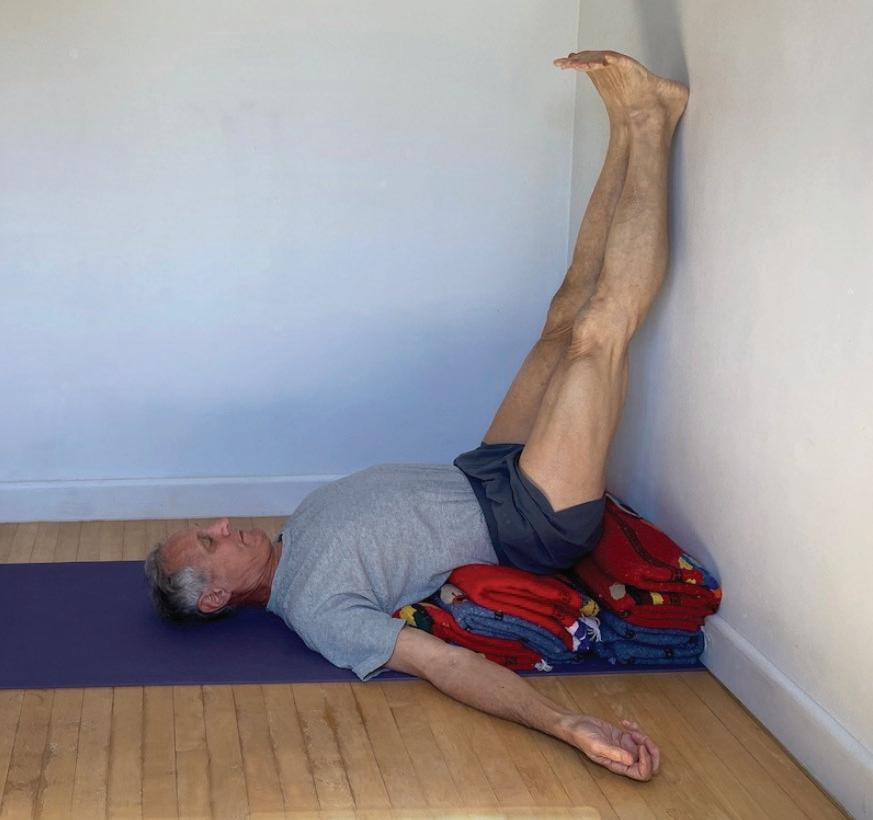
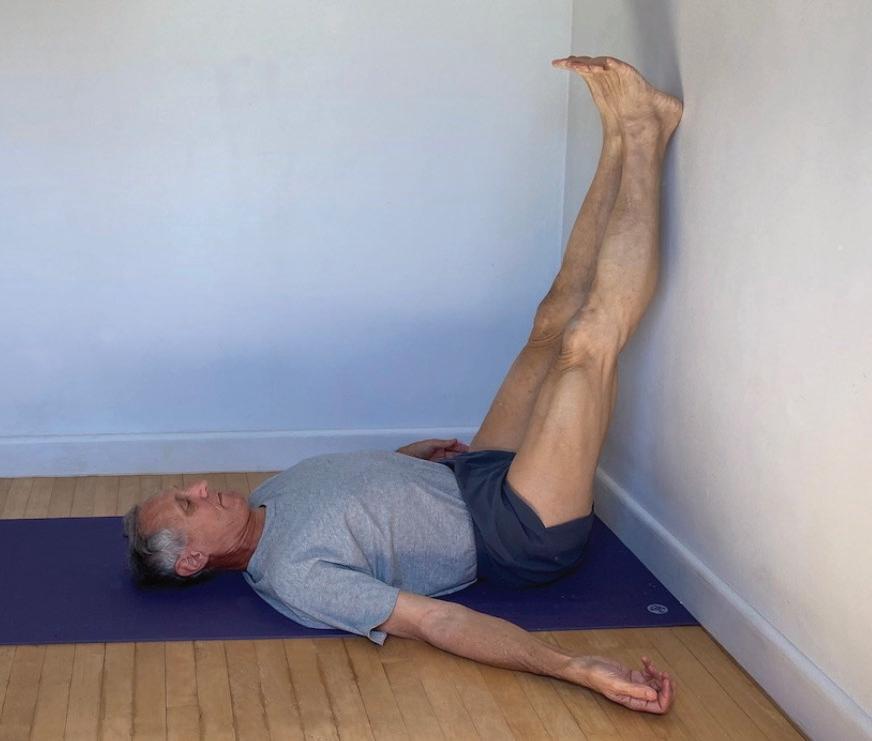
18 The Light | Fall 2022 ON ASANA CONTINUED
Asana
2. S
upported Savasana
Asana 3. Savasana
Asana 4. Urdhva Padasana
Asana 5. Viparita Karani
Asana 5.5. Viparita Karani (head elevated)
6. Salamba Sarvangasana
(Shoulderstand with the back of the head on the floor, shoulders elevated on the edge of a stack of folded blankets or a comparable prop, and the shoulders, trunk, pelvis, and legs in a vertical line, or as close to vertical as you can comfortably manage)
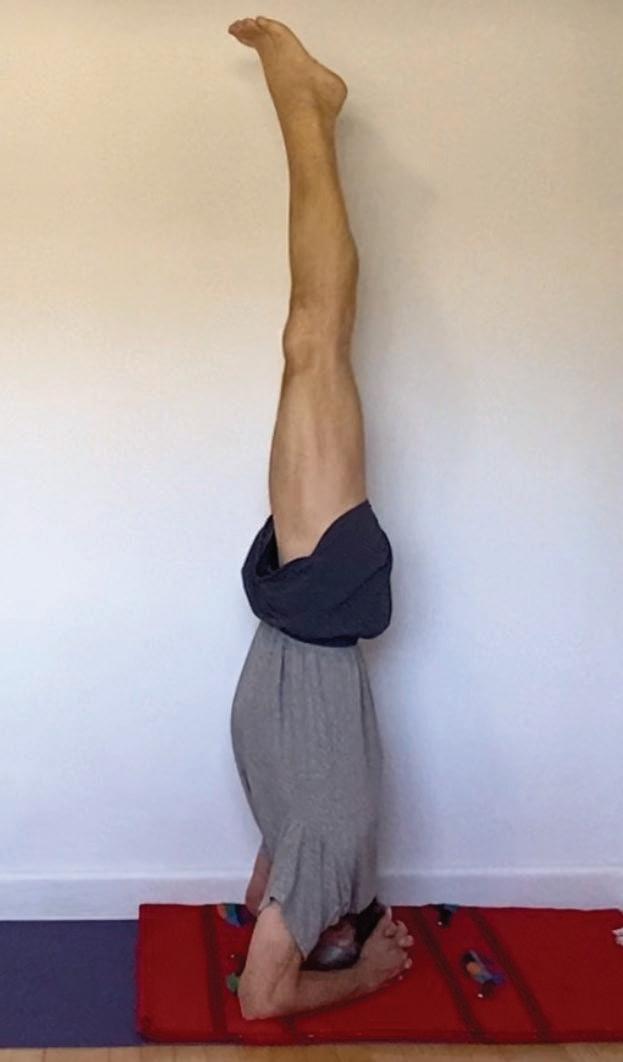
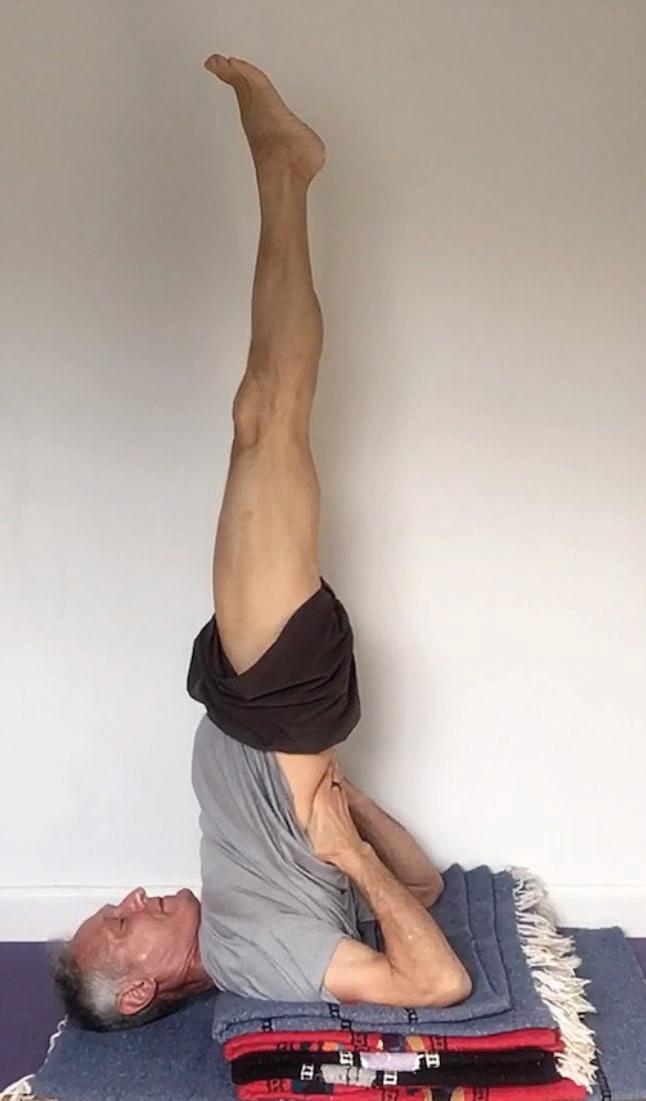
BASICS OF CIRCULATION
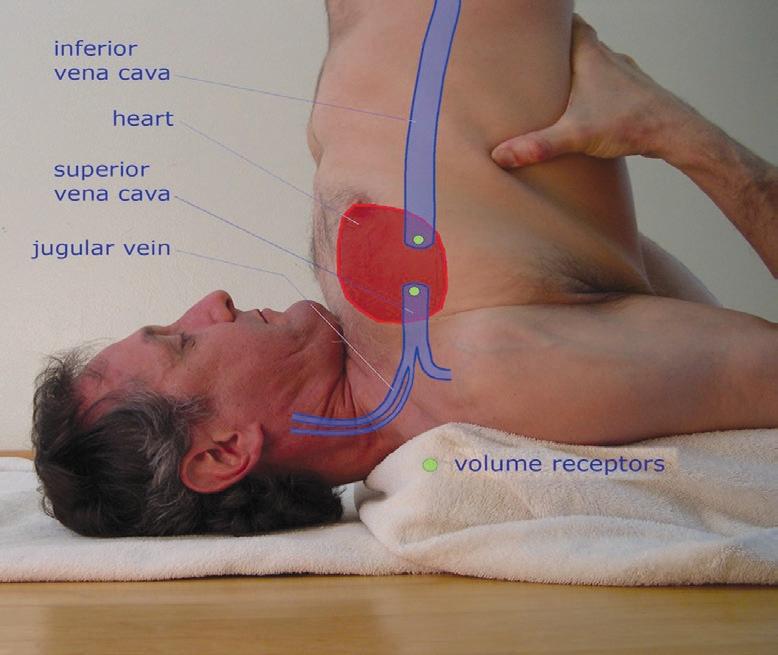
The heart pumps blood out through arteries, and blood returns to the heart through veins. This is circulation. The heart functions as if it were two pumps; one circulates blood through the lungs, the other circulates it through the rest of the body. Here, we’ll only talk about circulation through the rest of the body.
The heart pumps out blood to the body at high pressure. The blood exits the top of the heart through a single, giant artery called the aorta. The aorta branches into large arteries, which in turn branch into smaller and smaller arteries, which finally branch into fine capillaries that reach every cell.
The capillaries deliver oxygen, nutrients, water and other important molecules to the cells. The cells excrete carbon dioxide and other waste products into the fluid that surrounds them (the interstitial fluid).
7. Salamba Sirsasana I
(Headstand I, top of head and forearms on the floor, the rest of the body in a vertical line, or as vertical as you can comfortably manage)
On the path back to the heart, the venules converge into small veins, which converge into larger and larger veins, until all venous blood ends up in one of two giant veins, the superior vena cava or the inferior vena cava.
The blood from the capillaries begins its journey back to the heart in tiny veins called venules. The venules collect water and small molecules from the interstitial fluid. On the path back to the heart, the venules converge into small veins, which converge into larger and larger veins, until all venous blood ends up in one of two giant veins, the superior vena cava or the inferior vena cava (see illustration 1). These two veins deliver blood to the same receiving chamber of the heart, the right atrium.
8. Repeat the same sequence in reverse order
The Light | Fall 2022 19
Asana 6. Salamba Sarvangasana
Illustration 1: Venae Cavae, Heart, and Volume Receptors in Salamba Sarvangasana
Asana 7. Salamba Sirsasana
The lymphatic system runs roughly parallel to the venous system and also carries fluid back to the heart. It collects interstitial fluid containing waste (large molecules, bacteria, cellular debris, etc.) in lymphatic vessels. Once the fluid is inside the vessels it is called lymph. Lymphatic vessels, like veins, converge into larger vessels as they progress toward the heart. Along the way, lymph passes through nodes that filter and process it. All the processed lymph ultimately drains into the superior vena cava, where it becomes part of the venous blood that returns to the heart.
Unlike arterial (outbound) blood, the inbound venous blood and lymph operate at low pressure. They do not have a pump pushing them along. Several mechanisms move these fluids. One is the contraction of skeletal muscles that squeeze the veins and lymphatic vessels. Many of these vessels, especially in the legs and arms, have one-way valves, so squeezing them reliably propels venous blood and lymph toward the heart. Another mechanism is breathing. For example, the same vacuumlike negative pressure in the chest that draws air into the lungs during inhalation also helps draw venous blood and lymph toward the heart. A third factor, gravity, can be the most powerful driver of venous and lymphatic return to the heart under some conditions; however, under other conditions, it can be a strong impediment. We’ll focus next on ways we can strategically use gravity in yoga to aid desirable draining and filling of arterial blood, venous blood, interstitial fluid, and lymph.
DRAINING AND FILLING
Fluids flow downhill, so the first rule of draining and filling is to elevate the part of the body you want to drain above the part you want to fill. A crucial point to keep in mind is that the greater the height difference between the source of the fluid and its destination, the stronger the gravitational draining will be and the greater the pressure the fluid will exert below. The source of the fluid does not have to be directly above the destination, it just has to be higher. We’ll sometimes refer to the height difference as the “vertical drop” even when the fluid travels diagonally down or stairsteps down.
The second rule of draining and filling says that because all circulating blood comes from the heart and returns to the heart, the vertical drop that matters most in an asana is not the height difference between the feet and the head (although this still does matter), it is the height difference between the heart and whatever part of the body you want to drain or fill. For example, in any pose with the legs elevated, the strength with which gravity drains blood away from the feet depends much more on how far the feet are above the heart than on how far the feet are above the head. Likewise, in poses with the head below the heart, the degree to which gravity increases blood pressure in the head depends mainly on how far the head is below the heart, with a much smaller influence of how far the head is below the feet.
The main reason for this lies in the venous system, because it contains three to five times more blood volume than the arterial system1. All venous blood returning from body regions below the heart (that is, the legs, pelvis, abdomen, and lower thorax) flows into the inferior vena cava, then into the heart. All venous blood returning from body regions above the heart (that is, the head, neck, upper chest, and arms) flows into the superior vena cava, then into the heart. There are no veins that go around the heart to connect blood in the lower body to blood in the upper body. Therefore, during an inversion venous blood from the lower body cannot drain into or put filling pressure on veins in the upper body, and during an upright posture, veins in the upper body cannot drain into, or put filling pressure on, veins in the lower body.
The situation in the arterial system is more complicated, so we won’t try to untangle it here, but the upshot is that standing upright increases arterial pressure in the legs far more than turning upside down increases arterial pressure in the head. We’ll see how this plays out when we discuss Tadasana and Salamba Sirsasana
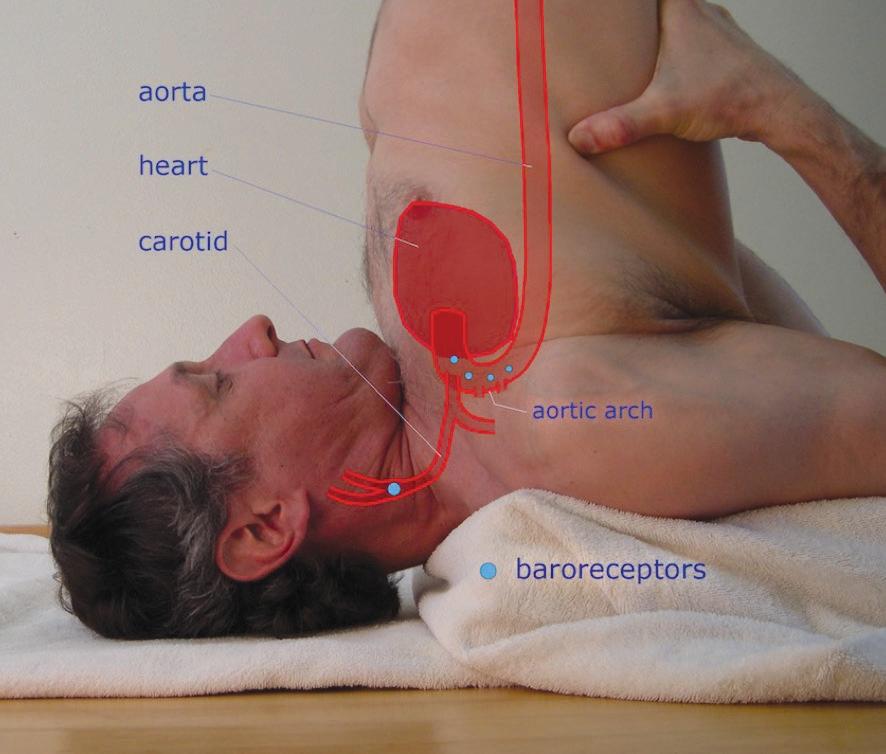
20 The Light | Fall 2022 ON ASANA CONTINUED
We’ll focus next on ways we can strategically use gravity in yoga to aid desirable draining and filling of arterial blood, venous blood, interstitial fluid, and lymph.
Illustration 2: Aorta, Heart, and Baroreceptors in Salamba Sarvangasana
To make sense of how specific asanas affect draining and filling, it’s useful to know the general layout of some major arteries and veins (see illustrations 1 and 2). The aorta is attached to the top of the heart. It first travels up toward the head a short distance (this is the ascending aorta), then arches over (this is the aortic arch) and finally runs down the trunk to the abdomen (this is the descending aorta).
The first arteries that branch off the aorta come out of the top of the arch, then divide further to deliver blood to the head, neck, upper chest, and arms. Additional arteries branch off of the descending aorta at various levels to supply blood to the trunk. The lower (abdominal) end of the aorta splits into arteries that bring blood to the pelvis and legs.
When we are standing upright, as the heart pumps out blood, gravity opposes its upward flow, and this reduces its pressure. The higher the blood rises, the lower its pressure becomes; therefore, blood pressure systematically falls as blood rises through the ascending aorta, the top of the aortic arch, and the arteries of the upper chest, neck, and head. Meanwhile, gravity accelerates and therefore increases the pressure of the downward flow of blood out of the aortic arch, down the descending aorta, and through all the arterial branches that serve the trunk, pelvis, legs, and feet. When we turn completely upside down, gravity exerts the opposite gravitational effects on the blood in the arteries, including the aorta itself.
It’s very important to understand how inversions affect blood flow and blood pressure in the head, so we’ll take a closer look at its pathways. Arterial blood travels through the neck to reach the head via two carotid arteries and two vertebral arteries. (The illustration shows just one carotid artery and omits the vertebral arteries). Each carotid artery splits into two branches within the neck. The internal carotid artery brings blood to the brain and other structures inside the skull. The external carotid artery brings blood to the face and other structures outside the skull. Venous blood exits the head mainly via two jugular veins. Each jugular vein has an internal and an external branch. (The illustration shows the two branches of one jugular vein.)
When you are upside down with the heart higher than the head, gravity helps push arterial blood downward into the head but it also hinders the flow of venous blood out of the head. The net result is that gravity does not increase blood flow through the head during inversions. It does, however, increase blood pressure
in the head, in both the arteries and the veins. Blood vessels in the brain may be somewhat protected from increased pressure because the skull acts like a closed, fluid-filled box that makes it hard for arteries and veins to expand too much. Blood vessels in the face, nose, eyes, and other areas outside the skull are less protected from elevated pressure, but do have some defense mechanisms.
Gravity-induced changes in blood pressure trigger a number of important and interesting reflex responses.
BLOOD PRESSURE REFLEXES
Gravity-induced changes in blood pressure trigger a number of important and interesting reflex responses. We’ll look at three types of reflexes that inversions or other asanas can clearly trigger: the first are called highpressure baroreflexes, the second are volume reflexes (also known as low-pressure baroreflexes), and the third are local arterial pressure reflexes. Each type of reflex is triggered by strategically-located stretch-sensors that send stronger signals when stretched by higher blood pressure and weaker signals when released due to lower blood pressure.
High Pressure Baroreflexes
The stretch sensors for high-pressure baroreflexes are called high-pressure baroreceptors, or just baroreceptors. The best known of these are nerves embedded in the arch of the aorta and in the carotid artery (see illustration). When these sensors are stretched by a rise in blood pressure, they elicit a set of responses that generally tend to lower blood pressure and otherwise calm the body and mind. When a fall in blood pressure reduces the amount of stretch on these sensors, they elicit a set of responses that generally tend to raise blood pressure and activate the body and mind. One consequence of this physiology is that when you go into poses that invert the heart, it often triggers a relaxation response. Another is that when you do standing poses, it activates you.
High-pressure baroreceptors don’t respond much, if at all, to small changes in blood pressure, but do respond to moderate-to-large changes (in a graded fashion). Many of these responses are fast-acting; for example, a rise in pressure at the baroreceptors almost immediately causes the heart to beat much more slowly, the heart muscle fibers to contract more gently, the smooth muscles that constrict most arteries and some veins
The Light | Fall 2022 21
to relax, and the body to breathe more slowly. Other responses are slower-acting; for example, the rise in pressure on the baroreceptors may gradually reduce the levels of several hormones that make the body retain salt and water, thereby tending to eventually reduce blood volume. Conversely, a substantial fall in pressure at high-pressure baroreceptors does the opposite: it greatly speeds up the heartbeat, makes the heart squeeze harder, constricts blood vessels, and so forth.
This means that finding ease and stillness in inversions can often be the key to unlocking their potency.
Perhaps the most interesting high-pressure baroreflex response, from a yoga perspective, is that stimulating the carotid or aortic baroreceptors can trigger a series of nerve signals that significantly slow down your brain waves.2,3,4 Although this has not been studied directly in yoga asanas, it is almost certainly one of the ways that supported inversions like Viparita Karani quiet your mind. If you want to take advantage of this calming reflex in yoga, it’s important to understand that it is easiest to trigger if your body and brain are already partly relaxed. This means that finding ease and stillness in inversions can often be the key to unlocking their potency. Finally, it’s useful to know that the calming baroreflex has an alerting counterpart: lowering blood pressure within the carotid artery and aortic arch can activate your brain; this may be one reason why standing poses generally wake you up.
Volume Reflexes (Low-Pressure Baroreflexes)
The stretch sensors for volume reflexes are called volume receptors, or sometimes low-pressure baroreceptors. Like their high-pressure cousins, they act to reduce load on the circulatory system when it’s high, and vice versa. The best known volume receptors are embedded in the right atrium, at the junctions where the superior and inferior venae cavae come in to deliver blood to the heart. When heart filling pressure increases, it stretches these sensors, and they in essence tell the body and brain that there is an increased volume of venous blood filling up the heart. This elicits a set of reflex responses that tend to reduce the volume load on the heart. A fall in filling pressure elicits opposite responses.
One volume-unloading reflex response to the stretching of the heart’s volume receptors is immediate dilation of veins in the arms and elsewhere so they can, in effect, temporarily store excess blood. Another is increased urine production by the kidneys so the body excretes more liquid. Stretching these receptors can also induce several of the same volume-reducing hormonal responses that the high pressure baroreflexes do. In addition, stimulating the volume receptors signals the heart to secrete its own powerful, home-grown, volumelowering chemical. There are no reports of volume reflexes affecting breathing or brain waves the way that high-pressure baroreceptors do, but this can’t be ruled out because it has not been studied.
Local Arterial Pressure Reflexes
The stretch sensors for local arterial pressure reflexes are located in the walls of certain arteries, for example in tiny arteries in the nasal passages. These reflexes can automatically constrict the arteries when they are filled up at high pressure. The constriction can expel excess blood and limit refilling. This may defend the arteries against damage if blood pressure gets too high during inversion.
With these reflexes, anatomical pathways and principles in mind, we’ll now explore how draining and filling work in the asanas of our demo sequence.
PRACTICE DEMO ROUND 2: EXPERIMENT AND FEEL
The focus of this round is to notice the specific sensations described in the observation instructions below, and to feel how they change when you transition quickly from one pose to the next (holding, again, for 10–30 seconds). It would be ideal to avoid interruptions by setting up the props for all the poses in advance, but if this is not practical, set up the props for two or three poses in a row, practice, then set up two or three more. Go back and forth between poses to better compare differences if you like.
There’s no need to try to figure out what is happening physiologically during this practice, just notice how things feel. We’ll analyze later.
Keep the instructions handy; refer to them frequently as you go along.
22 The Light | Fall 2022 ON ASANA CONTINUED
Observation Instructions for Practice Demo Round 2
1. Tadasana
Notice whether you experience these sensations:
• elevated blood pressure in your feet and ankles;
• no particular blood pressure sensation in your heart, upper chest, neck, head, face, nasal passages/sinuses, or eyes;
• an alert mental state.
2. Supported Savasana
First, notice whether your nasal passages are clear, making it easier to breathe through your nose, and whether you feel reduced pressure in your sinuses.
Next, notice whether the sensation of pressure or fullness in your heart and upper chest are higher than they were in Tadasana.
Finally, notice what pressure, if any, you feel in your feet compared to Tadasana
3. Savasana
Notice whether you feel an even distribution of pressure or fullness from your feet to your head, or perhaps a very slightly uneven distribution directing a bit more pressure and fullness toward your chest and head.
Notice whether your nostrils are less clear than in supported Savasana.
4. Supported Urdhva Padasana
Notice whether you feel:
• a sense of blood draining from the feet — a distinct drop in pressure — compared to Savasana;
• moderately elevated pressure in the rest of your body, distributed evenly from pelvis to head.
5. Viparita Karani
As you move directly from Urdhva Padasana to Viparita Karani, notice whether you feel:
• increased pressure or fullness in the area of your heart, which then spreads to your upper chest, neck, face/head, and arms;
• a distinct further drop in pressure in your feet.
Now try this first experiment while still in Viparita Karani
• disturb the alignment of the pose by dropping your chest and laying your upper back on the floor (untucking your shoulder blades), then notice whether you feel a fall in pressure in your upper chest and neck;
• return to the proper Viparita Karani alignment of lifting and opening your chest, lifting the lower tips of the shoulder blades high off the floor and pressing them into your back, and maximally rolling the tops of your shoulders far underneath you; notice whether you feel a restoration of pressure in your upper chest and neck.
5.5 Now try this second experiment while still in Viparita Karani
• elevate your head by placing a rather thick folded blanket under it, and notice whether this reduces pressure in your head and face, and/or reduces nasal congestion;
• remove the head support so your head is back on the floor, and notice whether this restores pressure to your head, face, and nasal passages.
Notice whether Viparita Karani feels especially relaxing.
6. Salamba Sarvangasana
As you move from Viparita Karani to Salamba Sarvangasana, notice whether you feel:
• a very strong increase in blood pressure focused especially in your upper chest;
• a strong increase in blood pressure in your neck, head, and face;
• a large further drop in blood pressure in the feet, legs, and pelvis compared to Viparita Karani;
• a more active brain, compared to Viparita Karani.
7. Salamba Sirsasana I
When you change from Salamba Sarvangasana to Salamba Sirsasana I, notice whether you feel:
• a distinct shift of blood pressure to the head itself, especially strong in regions nearest the floor (for example, the top of head, forehead, eyes);
• possibly less pressure in the neck and upper chest compared to Salamba Sarvangasana, but still high pressure there;
• either strong clogging or strong clearing of the nose and sinuses;
• similar or lower in pressure in the feet, legs, and pelvis compared to Salamba Sarvangasana;
• a more active brain, compared to Salamba Sarvangasana
8. Repeat the same sequence in reverse order
9. After the final Tadasana, lie flat in Savasana again until you feel ready to move.
The Light | Fall 2022 23
WHAT IS (PROBABLY) HAPPENING IN THE POSTURES
Here are proposed explanations of some of the things that may happen in each posture. They are grounded in science, but only a few of them are based on direct experimental measurements in yoga asanas. There are no fixed practice instructions for this section, but it’s extremely useful to revisit some of the poses as you read along.
1. Tadasana
Why there may be a feeling of pressure in the feet and ankles in Tadasana
The vertical distance from the heart to the feet is maximal in Tadasana, so gravity creates a very strong increase in arterial pressure as blood travels down the descending aorta through the leg arteries to the feet.
For example, one study found that in people who are standing up, arterial blood pressure measured at the ankle averaged 222/142 mm Hg, while arterial blood pressure measured at the arm averaged 129/79 mm Hg.5 Over time, this high pressure in the lower legs and feet can push excess fluid out of the capillaries into the interstitial space, causing swelling.
Meanwhile, the great vertical distance between the heart and the feet in Tadasana also increases downward pressure in the venous system. This makes it harder for the veins and lymph vessels to collect fluid from the interstitial space and send it upward toward the heart. In addition, the downward pressure causes the veins to expand, so a large volume of blood pools in the venous system of the legs and feet. You may see veins in your feet become distended in this pose.
All the factors above may contribute to a feeling of pressure in the feet in Tadasana
Why there may not be any marked feeling of low pressure or fullness in the heart, upper chest, neck, head, face, nasal passages/sinuses, or eyes in Tadasana
The circulatory system has several mechanisms for moving blood upward against gravity while standing.
Let’s look separately at moving venous blood up from the feet to the heart and pushing arterial blood up from the heart to the head.
When we stand upright, pooling of venous blood and interstitial fluid in the abdomen, pelvis and legs effectively removes about 10–20% of our total blood volume from circulation.6 This reduces the amount of venous blood available to fill the heart from below via the inferior vena cava. However, in Tadasana, strong action of the leg muscles squeezing the leg veins, plus constriction of smooth muscle in the walls of some leg veins, aided by one-way valves, helps push a sufficient amount of venous blood up through the legs to increase blood volume in the abdomen. There, strong breathing takes over to help draw a sufficient amount of venous blood upward through the inferior vena cava into the heart to achieve partial filling. Meanwhile, since the head, neck, and upper chest are above the heart in Tadasana, gravity assists the return of venous blood from these regions to the heart via the superior vena cava. This partially offsets the reduced venous-filling pressure from below, so although heart-filling pressure and volume are likely to be somewhat low in Tadasana compared to other poses, it is high enough for us to function normally. This may be partly why there is no marked feeling of low pressure in the heart in this pose. (The pressure is, in fact, somewhat low, but our body can deal with it, so it feels normal.)
In Tadasana, the head is as far above the heart as it can be, so the heart has to work extra hard to pump arterial blood upward with sufficient pressure to supply the head, especially the brain. When we move from lying down to standing, there is an immediate, large fall in blood pressure in the aortic arch and carotid artery, and this quickly triggers strong high-pressure baroreflexes. These increase the pressure of blood being pumped upward out of the heart to the upper chest, neck, head, face, nasal passages, sinuses, and eyes, partially or completely offsetting the tendency of gravity to lower pressure in these locations. This is the main reason that there is no marked feeling of low pressure in regions above the heart in Tadasana.
Why you may feel an alert mental state in Tadasana
The same baroreceptors that activate your cardiovascular system also activate your brain.
2. Supported Savasana
Why the nasal passages and sinuses often clear, making it easier to breathe through the nose in supported Savasana
24 The Light | Fall 2022 ON ASANA CONTINUED
The nasal passages and sinuses clear out when more fluid drains out of them than comes into them. Supported Savasana elevates the head above the heart, causing gravity to both increase fluid drainage out of the nasal region and reduce fluid flow into it. Specifically, elevating the head helps venous blood flow downhill out of the nasal region toward the heart, while it also makes it harder for arterial blood to be pushed uphill out of the heart into the nasal region. This usually clears the nose and sinuses. A similar process probably tends to reduce fluid pressures in all parts of the face and head during supported Savasana
However, there is a paradox. Tadasana elevates the head much farther above the heart than supported Savasana does, yet it does not reliably drain the sinuses or clear the nasal passages, and sometimes it may even clog them. One reason for this may be that, whereas Tadasana triggers a very strong high-pressure baroreflex that helps maintain or increase blood flow to the nasal region, supported Savasana may not be steeply enough upright to trigger a high-pressure baroreflex at all, so there is not an increase in arterial pressure to offset the gravitational drainage the pose provides.
Why sensations of pressure in your heart and upper chest may be higher in supported Savasana than they were in Tadasana , and why you may feel no pressure, or only slight pressure, in your feet in supported Savasana compared to Tadasana .
The short answer is that, whereas the large vertical drop from the head to the feet in Tadasana causes strong gravitational drainage of blood from the upper body and strong gravitational filling of the feet, the small vertical drop in supported Savasana produces much less gravitational drainage of the upper body and puts very little filling pressure on the legs and feet.
Here is a more detailed explanation. It has four parts. (1) In supported Savasana, although the torso and head are higher than the legs, the vertical drop is much smaller than in Tadasana. The smaller vertical drop causes less gravitationally-driven draining of the head and trunk and less filling of the legs and feet. (2) In supported Savasana, the legs are horizontal and the pelvis rests at the same level, so fluid pressure is distributed fairly evenly from the feet to the hips. (There is no concentrated pressure in or near the feet as there is in Tadasana). (3) The relatively small vertical step up from the level of the legs and pelvis to the level of the
heart makes it much easier in supported Savasana than in Tadasana for respiratory action to draw venous blood up from the pelvis and abdomen to the heart. This tends to make cardiac-filling pressure and volume higher in supported Savasana than in Tadasana. (4) The elevation of the head and neck in supported Savasana increases drainage of venous blood and other fluids into large veins in the upper chest, applying pressure that helps to push these fluids into the superior vena cava and then into the heart. In this way, the lifted head position causes increased filling of the veins above the heart and the heart itself.
The four factors above, in various combinations, probably account for the slightly greater sensation of pressure and fullness in the heart and upper chest and lesser sensation of pressure and fullness in the feet in supported Savasana compared to Tadasana.
Bear in mind, though, that supported Savasana is still a head-up, feet-down posture because the head is above the heart while the pelvis, legs and feet are below the heart. The pose still favors an overall gravity-driven shift of fluids away from the head and toward the feet, even though the effect is very mild.
3. Savasana
Why you may feel an even distribution of pressure and fullness from your feet to your head, or perhaps a very slightly uneven distribution directing a bit more pressure and fullness toward your chest and head in Savasana compared to supported Savasana
In flat Savasana, the legs, pelvis, trunk (including the heart), and head are all at the same level (or as close to level as is practical), and the heart itself lies horizontal, so there is no gravitational bias pushing or pulling body fluids toward or away from the head or feet. This is why fluid distribution may feel even from head to toe. However, our circulatory system is structurally biased to systematically push fluids away from the feet and toward the head, even when we are lying down. This is why, when you lie flat in Savasana, you may feel a slightly higher pressure and fullness in your chest and head.
Why your nostrils may be less clear in Savasana than in supported Savasana .
When we lie flat, the natural, structural push of fluids toward the head is unopposed by gravity, so it may gently push excess fluid into the nostrils, leaving less
The Light | Fall 2022 25
space for air to pass through. This does not occur in supported Savasana because the overall slant of the pose, especially the elevation of the head, may produce enough gravitational push of fluids away from the head to overcome the natural push toward the head.
4. Supported Urdhva Padasana
Why you may feel draining of fluids and a distinct drop in pressure in your feet in Urdhva Padasana , compared to Savasana
In Urdhva Padasana the vertical drop from the feet to the heart is relatively large (the full length of the legs), causing fairly strong gravity-driven drainage of fluids from the feet and legs into the pelvis. You may see veins in your feet recede in this pose.
Why you may feel moderately elevated pressure and fullness in the rest of your body, distributed evenly from pelvis to head, in supported Urdhva Padasana
The fluids draining from the feet and legs first fill the veins and lymphatic vessels in the pelvis, then over several heartbeats end up spreading relatively evenly through the pelvis, torso, and head because these body parts are all on the same level, with no gravitational bias pushing fluids toward one part or another.
Moments after you elevate your legs in Urdhva Padasana, the gravitational push of fluids draining out of them puts excess filling pressure on the heart. This usually stimulates the volume reflex that immediately dilates veins in your arms and elsewhere to accommodate part of the excess blood volume coming out of the legs. You might notice veins in your forearms or hands becoming more prominent in this pose.
Filling of the heart remains higher than normal as long as the legs remain elevated, and this causes the volume receptors to trigger the slower-acting body responses that may eventually reduce overall blood volume. It may take 10–20 minutes in the pose to develop some of these responses, and it may take repeated practice to produce a significant reduction in blood volume. Reduced blood volume can lower blood pressure, so theoretically, consistent, extended daily practice of Urdhva Padasana or other inversions that increase cardiac filling might help reduce blood pressure. However, this has not been proven clinically.
5. Viparita Karani
Why you may feel increased pressure in the area of your heart, which then spreads to your upper chest, neck and face/head, when you transition from Urdhva Padasana to Viparita Karani
When you transition directly from Urdhva Padasana to Viparita Karani without bringing the legs down you elevate your pelvis and abdomen well above your heart. This causes an immediate increase in the volume of venous blood draining from the pelvis and abdomen through the inferior vena cava and pushing into the heart. That is why you may feel an immediate increase in the sensation of pressure and fullness in the heart. Over the next few heartbeats, the higher volume of blood going into the heart comes out on the arterial side, filling the upper chest, neck, face, and the rest of the head with a higher volume of blood than they had before. That is one of the reasons you may feel the sensation of pressure spread to these areas. The pelvis and abdomen end up with lower blood volume, and regions from the heart to the head end up with higher blood volume for as long as you stay in the pose.
Why lifting your chest in Viparita Karani increases pressure in your upper chest and neck.
Lifting your chest and rolling your shoulders under increases arterial and venous pressure in the neck and upper chest by raising the heart a little higher and tilting it nearly upside down. These actions combine to increase the vertical drop from the heart to the aortic arch, carotid artery, superior vena cava, jugular vein, and other blood vessels. The greater vertical drop increases the filling pressure of all these vessels, which probably amplifies feelings of pressure in the upper chest, neck, and head in Viparita Karani.
Why you may feel a distinct further drop in pressure in your feet when you transition from Urdhva Padasana to Viparita Karani
When you lift your pelvis up from Urdhva Padasana to Viparita Karani you also raise your legs and feet higher above your heart. The increased vertical distance causes lower pressure of blood flowing upward in the arteries that supply the feet and stronger draining of venous blood and lymph traveling downward out of the feet.
26 The Light | Fall 2022 ON ASANA CONTINUED
Why elevating your head in Viparita Karani may reduce feelings of pressure in your head and face, and/or reduce nasal congestion, and why bringing your head back down to the floor may restore pressure and/or congestion.
Viparita Karani can increase blood pressure in the face and promote nasal congestion because it places the head below the heart. In this position, gravity increases the pressure of arterial blood flowing downhill from the heart to the head and also increases back-pressure (pressure against the direction of flow) on venous blood flowing uphill from the head to the heart. Elevating the head close to or above heart level reduces the pressure of arterial blood pushing into it and increases ease of drainage of venous blood out of it. Both of these factors may reduce feelings of pressure and fullness in your head and face, and/or reduce nasal congestion. Lowering the head back down below heart level restores the vertical drop that may have caused the feelings of pressure and congestion in the first place.
Why Viparita Karani may feel especially relaxing.
We have seen that the elevation and upside down tilt of the heart in Viparita Karani raise blood pressure in the aortic arch and carotid artery. This increases pressure on the baroreceptors located there. This may trigger the high-pressure baroreflex response that slows your brain waves, making you feel more relaxed. This response works best when you are already partly relaxed, comfortable, and give it some time to develop. Viparita Karani usually provides all of these conditions.
6. Salamba Sarvangasana
Why you might feel a very strong increase in blood pressure focused especially in your upper chest, and a strong increase in blood pressure in your neck, head, and face as you move from Viparita Karani to Salamba Sarvangasana.
In Salamba Sarvangasana, but not Viparita Karani (1) the legs, pelvis, and abdomen are as high above the heart as they can be, so gravity pushes venous blood from the lower body as strongly as possible into the heart through the inferior vena cava, and this high volume of blood gets pumped out of the heart into the aorta within a few beats, (2) in a fully vertical Salamba Sarvangasana, the heart is completely upside down and as high above the aortic arch and other arteries of the upper chest as it can be, so as the heart pumps out
blood, gravity maximally increases its pressure on these arteries, (3) the heart is also as high above the superior vena cava and other veins of the upper chest as it can be, so gravity maximally increases pressure on blood in these veins, (4) although there is a greater vertical drop from the upper chest to the head in Salamba Sarvangasana than in Viparita Karani, the drop is not large in absolute terms, so gravity only weakly drains blood away from the upper chest into the head; the four factors above suggest that both arterial and venous blood pressure and blood volume in the upper chest may be higher in Salamba Sarvangasana than in any other pose in this series, and (5) in Salamba Sarvangasana, the vertical drop from the heart to the head is greater than in Viparita Karani, so Salamba Sarvangasana puts greater fluid pressure in the neck, face and the rest of the head than Viparita Karani does.
Why you might feel a large further drop in pressure in the feet, legs, and pelvis as you move from Viparita Karani to Salamba Sarvangasana
When you lift your pelvis up from Viparita Karani to Salamba Sarvangasana you also raise your legs and feet higher above your heart. The increased vertical distance causes stronger draining of fluids from the feet and legs, which you may feel as a drop in pressure.
Why you might feel a more active brain in Salamba Sarvangasana compared to Viparita Karani.
This may seem paradoxical at first. Salamba Sarvangasana puts more pressure on the aortic and carotid baroreceptors than Viparita Karani does and is therefore theoretically capable of producing a stronger brain-quieting baroreflex response. However, this response can be blocked or reversed by muscular effort, mental effort, or discomfort, all of which are more common in Salamba Sarvangasana than in Viparita Karani. One might expect that skilled practitioners who can practice Salamba Sarvangasana with minimal effort and great comfort might experience a greater brain-quieting baroreflex. Likewise, anyone who can get comfortable in supported Salamba Sarvangasana, which requires little muscular or mental effort, may be able to enjoy this quieting experience.
Incidentally, it has been proposed that the flexed position of the neck in Salamba Sarvangasana may somehow stimulate the carotid baroreceptors. This hypothesis awaits evidence.
The Light | Fall 2022 27
7. Salamba Sirsasana I
Why you might feel a distinct shift of blood pressure to the head itself, especially strong in regions nearest the floor (for example, the top of head, forehead, eyes) when you change from Salamba Sarvangasana to Salamba Sirsasana.
Salamba Sirsasana creates the maximum possible vertical drop from feet to head and from heart to head, so it causes maximal shift of all body fluids toward the head, with the maximum fluid pressure in the parts of the head nearest the floor.
It appears that no one has scientifically measured actual blood pressure in the head in Salamba Sirsasana, but we can make an educated guess about it. Extrapolating from a 1963 study7 a rough estimate is that a person whose arterial blood pressure while standing in Tadasana is 104/75 mm Hg at heart level and 213/178 mm Hg at the ankle might have a pressure of 148/113 mm Hg at forehead level while in Salamba Sirsasana
Why you might feel less pressure, but still high pressure, in the upper chest in Salamba Sirsasana compared to Salamba Sarvangasana.
Salamba Sirsasana takes the head and most of the neck substantially further below the upper chest than Salamba Sarvangasana does, so gravity drains fluids away from the upper chest into the neck and head more strongly in Salamba Sirsasana than in Salamba Sarvangasana. This may account for the sensation of lower pressure in the upper chest that may occur in Salamba Sirsasana
Why you might feel either strong clogging or strong clearing of the nose and sinuses in Salamba Sirsasana.
In Salamba Sirsasana, the nose and sinuses are as far below the feet and heart as they can be, so filling pressure there is maximal. This can cause nasal and sinus tissues to swell with fluid. However, blood vessels of the nose and sinuses may have the local arterial reflex that causes them to automatically constrict and expel fluid when they are filled up at high pressure. Some people experience strong clearing of the nose and/or sinuses in Salamba Sirsasana; it is possible that this may be caused by such a local reflex. It seems plausible that when this occurs, the reflex might help protect the arteries against damage from excessive blood pressure, but it would require careful study to demonstrate convincingly if and when this is true.
Why you might feel similar or lower in pressure in the feet, legs, and pelvis in Salamba Sirsasana compared to Salamba Sarvangasana
The vertical drop from the feet to the heart is about the same in Salamba Sirsasana and Salamba Sarvangasana. This means that gravity probably aids venous drainage from the feet to the heart about the same amount in both poses, so the feet may feel similar, low pressure in the two poses. On the other hand, the lower head position relative to the heart in Salamba Sirsasana makes it harder for venous blood to return from the head to the heart than in Salamba Sarvangasana. This could reduce the volume of blood filling the heart, making it harder for the heart to pump arterial blood all the way up the feet in Salamba Sirsasana than in Salamba Sarvangasana. This could hypothetically cause a sensation of lower pressure (and actual lower pressure) in the feet in Salamba Sirsasana
Why you might feel a more active brain in Salamba Sirsasana compared to Salamba Sarvangasana
The carotid baroreceptors are further below the heart in Salamba Sirsasana than in Salamba Sarvangasana, so one might expect blood pressure on these receptors to be higher in Salamba Sirsasana, and this could cause a stronger baroreflex-mediated quieting response in the brain. However, practicing Salamba Sirsasana typically requires more muscular effort and attention to balance than practicing Salamba Sarvangasana does, and these factors might make it more challenging to fully activate the baroreceptor-mediated calming effect in Salamba Sirsasana
8. Repeat the same sequence in reverse order
9. After the final Tadasana, lie flat in Salamba Savasana again until you feel ready to move. Why is it recommended to lie flat in Savasana after the final Tadasana?
Tadasana is an activating pose and not ideal for putting the mind and body in a rested, balanced state at the end of practice. Savasana is the most neutral pose with respect to gravitational effects, mental effort, and muscular effort, so it helps restore both physiological and mental balance.
The practice demo sequence we did here was designed to teach about the physiology of inversions. It was not a typical inversions practice sequence. It is often
28 The Light | Fall 2022 ON ASANA CONTINUED
good for a typical inversions practice sequence to end with supported Savasana, a restful, head-up pose, as a counterpose to all the head-down poses. This could theoretically help speed draining of waste fluids (venous blood and lymph) that could have accumulated in the head, neck, and upper chest in the head-down poses. Flat Savasana would also support such draining, but it would probably be slower.
FURTHER PRACTICE
Here are some ways you can use knowledge about inversions in practice.
Experiment with longer durations in the poses of the demo sequence.
Experiment with variations of the poses, see and feel what happens, and think about why. For example, practice Eka Pada Sarvangasana and Eka Pada Sirsasana, feel the difference between the foot of the down leg and the up leg, then compare the feet when you bring them back together.
Experiment with poses that invert one part of the body but not another, such as Adho Mukha Svanasana, Uttanasana, and Setu Bandha Sarvangasana. Think about what parts of the body are below the heart and what parts are above the heart in these poses, and notice associated sensations.
Design and adjust asanas to achieve specific draining and filling effects. For example, try to design a pose that helps drain swollen ankles while also reducing nasal congestion, then actually set it up, practice it, and adjust it so it works best.
References
1. Wolff, C.B. et al. (2016). A Discussion on the Regulation of Blood Flow and Pressure. In: Elwell, C.E., Leung, T.S., Harrison, D.K. (eds) Oxygen Transport to Tissue XXXVII. Advances in Experimental Medicine and Biology, vol 876. Springer, New York, NY. https://doi. org/10.1007/978-1-4939-3023-4_16
2. Bonvallet, M., P. Dell, and G. Hiebel. Tonus sympathique et activité électrique corticale. Electroencephalogr. Clin. Neurophysiol. 6: 119-144, 1954. doi: 10.1016/0013-4694(54)90011-5
3. Bridgers, S. L., S. S. Spencer, D. D. Spencer, and C. T. Sasaki. A cerebral effect of carotid sinus stimulation: Observation during intraoperative electroencephalographic monitoring. Arch. Neurol. 42: 574-577, 1985. doi: 10.1001/ archneur.1985.04060060076012
4. Dell, P., and Y. Padel. Rapid falling asleep provoked by selective stimulation of vagal afferents in the cat. Electroencephalogr. Clin. Neurophysiol. 18: 725, 1965.
5. About half the people chosen for this study had normal blood pressure and the other half had high blood pressure. The difference between arm and ankle was about the same in each group. The blood pressure values reported here are the average for all participants, so it is higher than normal blood pressure.
Malhotra et al. Blood pressure changes in the leg on standing. J Clin Hypertens (Greenwich)., Sep-Oct 2002;4(5):350-4. doi: 10.1111/j.15246175.2002.00767.x.
6. Truijen et al. A definition of normovolaemia and consequences for cardiovascular control during orthostatic and environmental stress. Eur J Appl Physiol (2010) 109:141–157 DOI 10.1007/s00421009-1346-5.
7. Rao S. Cardiovascular responses to head-stand posture. J Appl Physiol. 1963 Sep;18:987-90. doi: 10.1152/jappl.1963.18.5.987
Roger Cole, Ph.D. is an Iyengar Yoga teacher and research scientist with over 40 years experience applying science to asana and pranayama practice. He specializes in training students of all levels, from beginners to teachers, in anatomy, physiology, precise physical technique, breathing, meditation, relaxation, sleep, and biological rhythms.
The Light | Fall 2022 29
©Copyright 2022
by Roger Cole, all rights reserved.
Pranayama
Beginning Your Pranayama Practice
by John Schumacher
In the three previous articles, I presented preparations and essential elements for taking up the practice of pranayama: regular asana practice, conducive lifestyle, a skilled and inspiring teacher, and commitment. I discussed why we would want to practice pranayama: the transformative power of the practice and its capacity to bring us physical, physiological, mental, emotional, and spiritual well-being. And I set the stage for practicing pranayama by examining the importance of calming the mindbody in Savasana and considering how to tune in to the breath in a focused and subtle manner. Now we are ready to begin the formal practice.
Quiet receptivity is essential if you are to realize the full benefits of the practice.
In the Iyengar method we begin in Savasana with reclining pranayamas. As I explained in more detail in the most recent article, Savasana allows you to come to a quiet state, free from strain and tension, the mind settled and receptive. Quiet receptivity is essential if you are to realize the full benefits of the practice.
For many years, I taught a weekly pranayama class at Unity Woods. In the first week’s lesson, I offered some introductory remarks, covering some of the same material I have written about in the previous articles in The Light. Then the students lay in Savasana and, as they had already learned to do in asana class (I required at least one year of Iyengar Yogasana practice before beginning pranayama), they gradually let go and settled into a calm, quiet state.
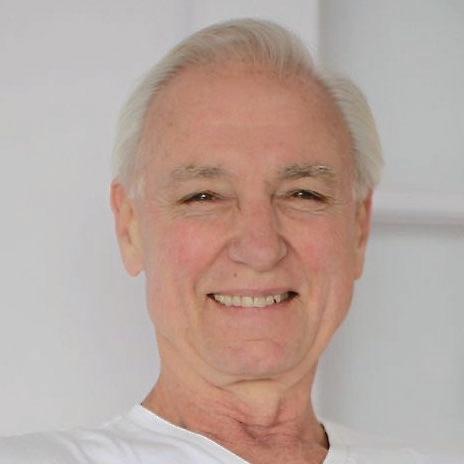
Begin your pranayama practice like that. Do Savasana.
In that relaxed, attentive state, acquaint yourself with your breath in a deep and intimate way. All these breaths are done through the nose. Learn where in the body your breath moves: abdomen (upper, lower), chest (upper, middle, lower), side, back, left, right? Learn what the pace of your breathing is: slow, moderate, fast, regular, irregular? Observe your inhalation and exhalation: which is naturally longer/shorter, or are they even? Become aware of your state of mind: calm, agitated, focused, scattered? Spend at least 10 minutes on Savasana and observation, more if you have the time and capacity. Practice this for at least a week.
To be honest, this is a difficult way to start. You want to do pranayama. DO pranayama, not lie around and watch what may feel like nebulous aspects of breathing in and out. Just staying focused on the breath when you’re not DOING anything with it is very challenging. This is, of course, the practice of dharana (the sixth limb, concentration), using your breath as your object of concentration. It illustrates the interpenetration of all the limbs with one another. Don’t be distracted by the distractions. Receptive means receptive. Each time you go wandering in your mind, bring your attention back to the various aspects of the breath you are observing. I’ve had mornings where a large chunk of my practice is simply settling down enough to be quiet and be with my breath. It took me a while to accept that this was a legitimate practice and not a waste of time. I now consider it to be one of the most important parts of my pranayama practice. It sets the stage for what is to come and provides clues as to where to go next. After taking time to simply observe and become acquainted with your undirected, effortless, “normal” breath, the “doing” can begin.
There are many pranayamas and many variations of pranayamas. The Iyengar system is unique in its organization and nomenclature. Generally, basic pranayamas are divided between reclining and seated. Reclining pranayamas have lower numbers; seated, higher. Depending on whether the inhalations and exhalations are equal or one of the two movements is emphasized over the other, different numbers are assigned.
The most basic pranayama is Ujjayi. It is the simplest in the sense that the breath flows through both open nostrils in an uninterrupted movement, as does your
30 The Light | Fall 2022
ON
ordinary breath. Ujjayi I is done while lying in Savasana. Guruji sometimes referred to Ujjayi I as “conditioned breath.” The breath is taken from an unconditioned state (relaxed, effortless, undirected) to a conditioned state (intentional, adjusted).
After arriving at a quiet, alert state in Savasana and observing your normal breath, adjust the breath so the inhalations and exhalations are even in duration. We are not trying to maximize the movement of the breath in Ujjayi I, so don’t take full deep breaths. Do take enough breath that you don’t feel short of breath.
In your preliminary observations, you may have noticed one movement is longer than the other. Let’s say your exhalation is longer than your inhalation. As you breathe slowly and smoothly, increase the length of your inhalation to equal the length of your exhalation. You may find, however, that when you do that, your exhalation also increases so that the movements still aren’t even. Shorten your exhalation until a balance is achieved. Each breath is unique, and each breath is to be adjusted. Do this until you have attained a steady, gentle rhythm
Among the characteristics you noted in your earlier practice of observing the breath was the location (desa) of your breath, i.e., where in your body the breath moved and where it didn’t. As you now begin to direct the breath in Ujjayi I, start your inhalations by slightly drawing back your lower abdomen between the pubis and navel. This should not be a strong muscular action or create a sucking feeling. Rather, it is as if someone had placed their hand on that area and were very gently pressing as you begin your inhalation. This will automatically direct the breath upward toward the upper abdomen, diaphragm, and lowermost rib area.
In addition to an upward, vertical movement, the inhalation should also have a broadening, horizontal movement. As the upward inbreath reaches the diaphragm/lower rib region, spread the breath from the center to the sides. Again, don’t go for deep or maximum inhalation. When you first feel resistance in your inhalation, that’s enough. Ujjayi I should be nearly effortless.
At the end of the inhalation, the lower rib region will feel lightly lifted. As you exhale, release your abdomen away from the lifted area, maintaining that feeling of lightness in the lower ribs, so that area doesn’t collapse or become heavy. Let your abdomen slowly release away from the chest toward the pelvis and let it descend from the front toward the back of the abdomen. Don’t press
For most of us, our eyes are our primary source of information about the world. In pranayama, however, our ears are more important.
or squeeze the breath out. At the end of your exhalation, your abdomen should be completely relaxed. Into that passive, receptive space, the next inhalation flows. Establish a steady, gentle rhythm. The movements of the breath and body should not be harsh or jerky. Relax your shoulders, trapezius, and neck. Relax your throat, jaw, tongue, temples, eyes.
Ujjayi breath is characterized by being an audible breath, i.e., the practitioner makes a sound on both the in breaths and the out breaths. It is easier to learn the sound on the exhalations, so let’s start there. Trying to describe the sound and how to make it by writing about it is challenging. In person, I can make the sound so you have some idea of what it should sound like. The best I can do here is to describe it this way: Imagine you are going to clean your eyeglasses. You open your mouth and exhale on them from your throat with a “hhhaaa” sound to fog them before you wipe them clean. That is how you make the sound on the Ujjayi exhalation, except that you keep your mouth closed. Although you are exhaling through your nose, the feeling is as if you were exhaling from your throat. Despite that, don’t try to do anything with your throat. Keep it relaxed as you exhale a soft, steady breath. The sound should be soft and steady as well.
After learning to do this on the exhalation, then you can try on the inhalation. Again, although you inhale through the nose, the feeling is as if you were inhaling through the throat, but don’t try to use throat muscles. This generally doesn’t come quite as easily as with exhalations. Although the in breath and out breath both take place in the throat, the sound is slightly different, and where you feel the touch of the breath in the throat is also slightly different. Guruji describes the sound on the inhalations as a “sibilant sound ‘ssss’” and the sound on the exhalations with the “aspirate ‘hhhh’.”
For most of us, our eyes are our primary source of information about the world. In pranayama, however, our ears are more important. Patanjali says that in pranayama our breath should become suksmah, subtle, soft, fine, exquisite. As we practice, the sounds of our breath and body guide us to adjust, soften, and refine our breath until it has become exquisitely subtle.
The Light | Fall 2022 31
In your preliminary practice, one of the things you observed about the location of the breath was any difference between the left side of the torso and the right. As you direct the breath in Ujjayi I, inhale and exhale so that the two sides move equally. You will almost certainly find that one side feels more inviting, more open, more receptive, more mobile, while the other side is reluctant, dark, inaccessible. To create an even balance between the two sides, you can attempt to direct the breath into the less active side by trying to move that side more, perhaps by moving the lower ribs. This is possible, but requires a great deal of physical skill. Instead, notice that as you observe the disparity between the two sides, your attention goes much more readily to the more mobile side. The other side goes relatively unnoticed. Direct your attention toward the obscure side. Actively look mentally into that side. This may not be so easy and initially requires mental effort. The dull side may seem inaccessible at first. Stay with it. You have already learned in your asana practice that some poses, some actions don’t come easily, and that persistent effort over time is required to progress.
Continue to work this way until the light of your consciousness illuminates the dark side such that the movement there is greater than the previously more mobile side. When the channel of awareness has been established on the reluctant side and movement has come, adjust your attention so that your consciousness spreads evenly on both sides and the movements are equal. The mental effort will become more relaxed, and the equanimity of the breath will bring soothing equanimity to the mind. This may happen quickly, slowly, or not for some time.
This practice will also attune you to the state of the brain. As one side of the body is more active, so one side of the brain is more active. As you work to direct your attention toward one side of the body or the other, notice also that not only is your attention more on one side of the body, but that one side of the brain is more alert than the other. You seem to “see” more with the right brain or the left brain than with the other. Just as you can learn to move the breath on the dull side by directing more attention to that side, so you can learn to attend, to “see,” more clearly from the dull side of the brain.
We know that breath and mind are linked and interactive, and we know that relationship is a two-way street. Breath affects mind: “Calm down. Take a deep breath.” Mind affects breath: “I’m so nervous, I can’t catch my
Consistency is crucial in all aspects of yoga sadhana
breath.” This is common knowledge. But few realize how subtle and intimate that relationship is. The simple act of balancing the movement of the breath evenly between the left and right can open us to a profound experiential realization of that truth.
Indeed, according to Patanjali, one of the primary reasons for practicing pranayama is to clarify and focus the mind. In Sutra II:34, he says, “pracchardana vidhaharanabhyam va pranasya.” Guruji translates this as, “[The consciousness becomes favourably disposed, serene, and benevolent] by maintaining the pensive state felt at the time of soft and steady exhalation and during passive retention after exhalation.” And in Sutra II:53, Patanjali says, “dharanasu ca yogyata manasah,” which Guruji translates as, “The mind also becomes fit for concentration.” The movement of consciousness and breath are inextricably intertwined.
In Ujjayi I, the point is to develop the skill and sensitivity to direct the breath in such a way that the movements are balanced, steady, smooth, and harmonious. In my early days of practicing pranayama, Ujjayi I seemed unnecessary and inconsequential. And in my early days of practicing asana, Tadasana seemed boring and of little importance. But as my practice has matured, I have come to understand that the skillful perception and control developed in this simple practice underpins all the succeeding pranayamas, just as the “simple” posture of Tadasana lays the foundation for all the other asanas
Consistency is crucial in all aspects of yoga sadhana Patanjali says “Sa tu dirghakala nairantarya satkara asevito drdhahumih,” which Guruji translates as “Long, uninterrupted, alert practice is the firm foundation for restraining the fluctuations.” This is true for every limb of the eight limbs of Ashtanga yoga, but especially for the practice of pranayama. Guruji used to say that if you missed a week of asana practice, you could regain what you lost in a week. But, he said, if you missed a week of pranayama practice, it would take two weeks to get back to where you were. Thus, daily pranayama practice is the key to making and maintaining progress. Even 15 minutes a day can have deep and lasting value. In Sutra II:52, Patanjali says, “tatah ksiyate prakasa avaranam,” which Guruji translates as, “Pranayama removes the veil covering the light of knowledge and heralds the dawn
32 The Light | Fall 2022 ON PRANAYAMA CONTINUED
of wisdom.” To underscore the point, Guruji says that “Pranayama is the bridge between the physical and the spiritual. Hence pranayama is the hub of yoga.” Good reasons to practice pranayama, don’t you think?
I hope that these articles have piqued your interest in pranayama and have persuaded you that the practice is within reach and worthwhile.
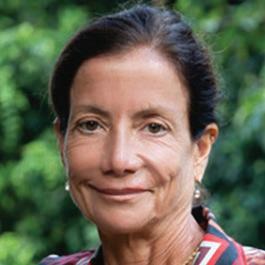
John Schumacher (CIYT, Level 4) has practiced yoga for 50 years. He is the founder and Director of Unity Woods Yoga Center, serving the Washington, D.C. metropolitan area since 1979. For 33 years, he studied in India regularly
with B.K.S. Iyengar, who personally certified him as an Advanced Junior I Iyengar Yoga teacher. John’s clear, precise style and his engaging sense of humor have made him one of America’s leading yoga teachers. In 2015, Yoga Journal awarded him its prestigious Good Karma Award for spending “40-plus years sharing [his] practice to help authenticate yoga in America today.”
John has written for a variety of publications. He has also appeared in numerous local and national media outlets across the U.S., speaking about the practice and benefits of yoga. He conducts classes and workshops for students and teachers all over the world.
Pajama Yoga
BY MARCIA MONROE
It is hard to believe two years have passed since the pandemic began and our lives changed for better or worse.
Yoga practice—sadhana, and teaching became constricted to connections from within a screen. Consequently, the concept of tapas became imperative in my practice. Without the discipline and the ardor to practice, chaos could easily have become the next virus. Turning on the computer as a preparation to practice has been the most challenging evolution for citta vritti, in my experience.
Over the years, I have purchased recordings of the Pune classes, and books. In this sense, being homebound has been an inspirational retreat to practice, reflect and realize how lucky I was to have been exposed to the Iyengar family, and the path of embodiment through yoga.
The 2020 lockdown took me from Pune to Brazil, as all the flights to the U.S. were canceled. It was a positive fate to reconnect with my country. There, I had the opportunity to be an assessor for the Iyengar Yoga Association of Brazil's first online assessment. I was happy to witness the amazing persistence of students, who had waited up to two years to go through the process. Although being a faithful student of Prashant Iyengar, I was not sure if this should be called a real yoga assessment, or if it should be considered a yoga education for aspiring teachers. Who am I to assess or judge a profound ancient science and evolutionary system as transmitted by Guruji and his family? Is
this assessment structure nourishing for the sadhaka evolution in the long run?
Prashant Iyengar is brilliantly sharing his teaching on Saturdays with IYNAUS in a new online program.
Prashant Iyengar is brilliantly sharing his teaching on Saturdays with IYNAUS in a new online program. He unfolds, in my opinion, very important themes for us “teachers” to reflect upon and investigate. Unfortunately, the rigid aspects of the “mind” still seek for a fixed model that no longer exists, only in a few places and in our memories. I embrace and welcome this new model of education, alignment and learning, knowing the pandemic changed reality and past impressions. Old relationships, attachments to classes and teachers, titles, etc. need to be redefined. How should we include cultural, social, racial, and gender
The Light | Fall 2022 33
diversity in yoga education, studying the individual situation and context while maintaining the tradition and direction instead of reinforcing discrimination? When we say, “We do it this way, we do it that way,”— who is ‘we?’
Guruji was a visionary and created the foundation for us to face the internal and external lockdowns. The morning self- and group practice in Pune created a feeling of unity, connection, and belonging among different cultures, races, genders, ages and life histories. This yoga sadhana and self-practice became a solid support to the world outside the global shock we all have been experiencing. Guruji has provided a system that encourages dynamic learning that everything is in constant movement through the means of practice, inquiry, reflection, and skillful action to the external world.
I have been teaching weekly online classes in China early in the morning. These classes took place at Integral Yoga Institute, now also Iyengar Institute of New York. As I prepared the room for the virtual class, there was pre-class time to make sure everything in class would go smoothly. I checked sound, monitors, Wi-Fi, mics, and the visual aspects. It felt like a performance, getting ready to be seen and to act faithfully to the ancient teachings. One time, after I finished my class, I ran into a senior Iyengar teacher, who confided in me the fatigue of teaching online and her lack of desire to teach. She felt the best being at home, doing her own thing.
Guruji once mentioned that it is very difficult to sort things out and grow alone, and that we need the company of noble minds. We ought to be in satsang and sadhana group practices, teaching, and learning.
He told me that when we couldn’t find an answer to a problem, let Isvara decide. The misperception of oneness and peace can bring isolation when not balanced. The accepted challenge remains the relationship to self, breath, mind, senses, and others. How should we find balance in this virtual evolution? What is balance?A new counter and positive current is now evolving from the strict lockdowns and practice almost feels like a kumbhaka, where the space between the inhalation and exhalation creates a suspension of time and a reflection of potential seeds and possibilities.
Marcia Monroe is a Certified Iyengar Teacher and a faculty member of the Iyengar Institute of New York. She is the author of the book Yoga and Scoliosis, which has a forward by B.K.S. Iyengar.
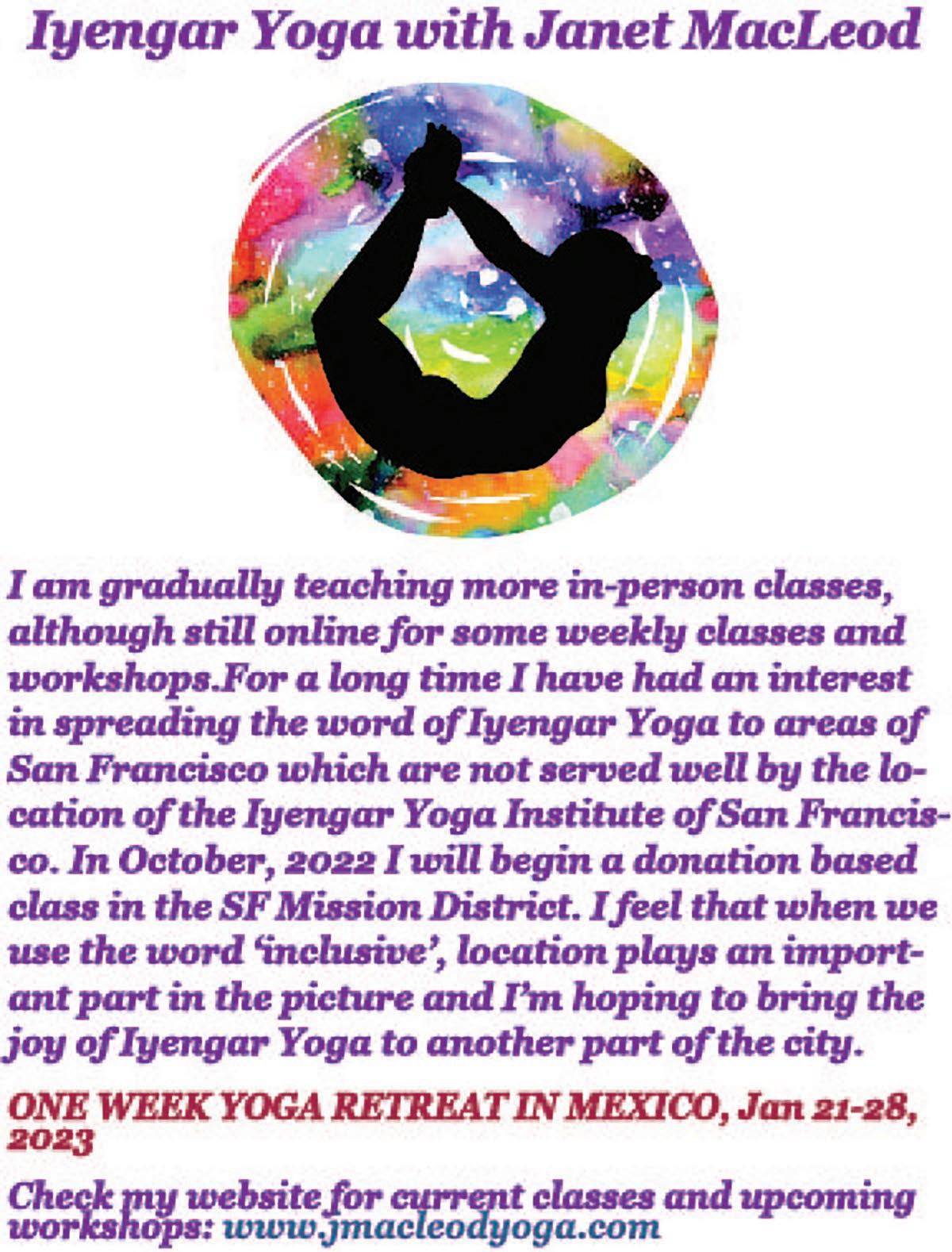

34 The Light | Fall 2022
PAJAMA YOGA CONTINUED
The Back Leg in Lateral Standing Poses
BY LOIS STEINBERG, PH.D.
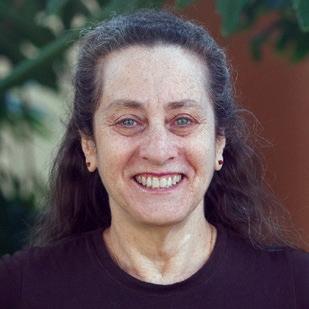
Guruji once said that he could instantly tell the difference between an experienced practitioner and a casual one by noting the outer back knee in Utthita Trikonasana Experienced practitioners turn the back knee out. Casual ones turn the back knee in. I will write about the back leg in lateral standing poses.
When we do a sequence of poses from Parsva Utthita Padasana to Utthita Trikonasana, Utthita Parsvakonasana, and Virabhadrasana II, we find the weight is naturally heavier to the forward leg and lighter to the back leg as we proceed through these lateral standing poses. We need to counter that tendency and maintain the weight on the back leg to make it progressively heavier as we go into the pose. The back leg should be grounded, made dense, with the earth element in the bones.
The back leg should be grounded, made dense, with the earth element in the bones.
Generally, for the back leg, we have to intensify the pressure to the outer heel/side of the foot. This requires the lift of the inner ankle, shin, and thigh, and maintaining the thigh back, with each of these actions initiated before bending into the pose. Many nuances can be applied to achieve these efforts. In the case of pain in the foot, ankle, knee, or hip, you can adapt the pose to improve these conditions on both legs.
A lot of attention is given to the forward leg because it will cause pain if excessive weight is borne on the problem side. Measures such as raising the forward leg foot on a slanting plank, a piece of quarter round, a block, or even higher on a Viparita Karani box can alleviate the pain. Putting the back foot to a rope wall and holding the rope or positioning a chair to place the forward hand higher can lessen the weight on the forward leg and avoid pain But that is still addressing the pain felt in the forward leg.

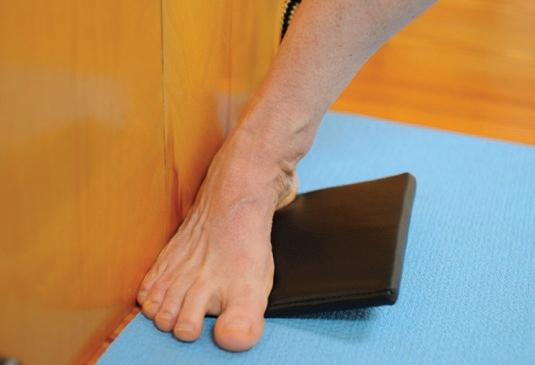
We may not feel discomfort when the problem leg is the back leg. We overlook addressing that side because it may not hurt as much, if at all, because the weight is less. But the weight should also be evenly borne on the back leg. You may find, if you give attention to the back leg, you may improve the pose and the ailment.
I present adaptations to the back leg of the lateral standing poses. They should not all be applied at once. Practice using one of the supports at a time, starting with the lift to the inner back foot. Work up the leg from there. Repeat the same pose using each support separately to gain a deeper understanding of the effects and how it benefits your condition. Then repeat without support in the middle of the room with the imprint of the supports fully engaged.
1. Start in Utthita Hasta Padasana using the wall to support the back leg foot. Position the outer heel and small toe, the entire side of the foot, down the wall to the floor. Place a folded washcloth, pad (Figure 1), or knee rod (Figure 2) under the big toe ball mound and inner heel so the inner foot is raised. Step the forward leg away from the wall and stand with the hands on the hips. Turn the forward leg out to Parsva Utthita Hasta Padasana. Strongly lift the back leg inner ankle to the wall as if trying to touch the outer ankle to the wall. At the same time resist the outer ankle inwards. Lengthen the toes forward and the inner heel backward to avoid shortening the inner foot. The ankle should become thin or narrow. Lift the inner shin and thigh towards the wall. Maintain the back leg efforts and proceed to the lateral standing pose. This is the simplest adaptation.
The Light | Fall 2022 35
Figure 1 Figure 2
2. Start as above. Position a block or similar object (Figure 3) under the inner shin. Lift the inner shin away from the block, even more when going to the pose and holding the pose. Guruji did this to me with a sharp object and I would be injured if I did not lift the inner shin! My back leg inner shin has not forgotten this.
4. Knee rods keep the patella centered and work the outer knee ligaments back (Figure 5). If knee rods are not available position belts above and below the knee. Turn the front of the back leg knee out and move the outer knee back in the direction of the wall behind you.
3. Position a long knee rod to the outer shin with two belts, between the gastrocnemius and anterior tibialis muscles. A “dent” will appear when you move the outer shin to the inner shin and that is the place to position the rod. The buckles are on the outer side tightened from front to back. Lift the inner foot, inner shin, and move the outer shin back. Figure 4 shows the pose independent of the wall for the purpose of depicting the prop clearly. You can use the wall for the back foot.
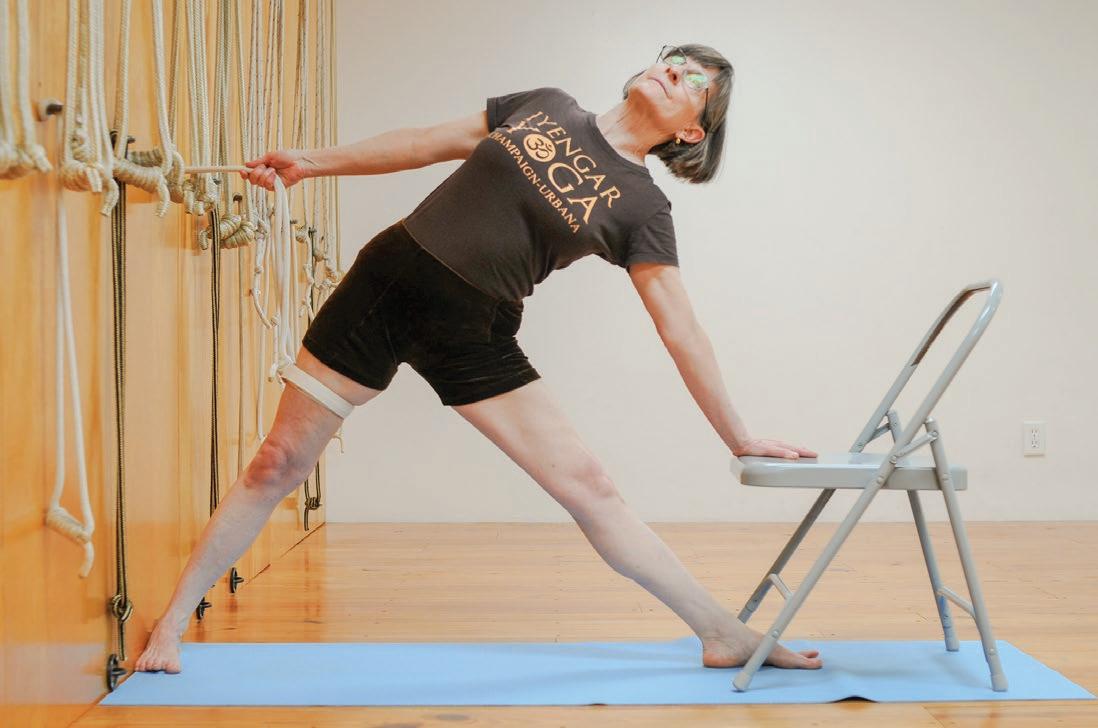
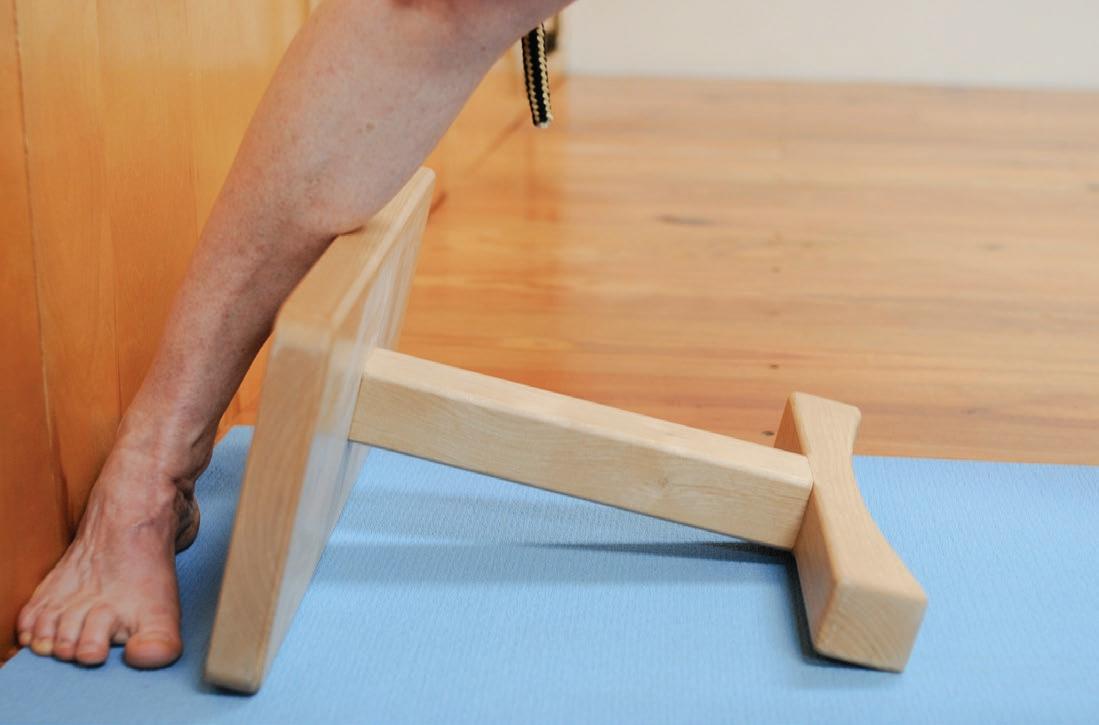
5. Position a belt around the middle thigh (Figure 6).1 Move the inner, front, and outer thigh away from the belt and the back of the thigh towards the belt.
6. Step the back leg inside a lower rope and step away from the wall until the rope is taut and the body is perpendicular to the rope wall, as if the back foot is up to the wall (Figure 7, shown with Utthita Trikonasana). Move the outer femur head inwards and lift the inner femur head higher than the outer. The strong effort must be maintained on the femur head, especially when going to and while in the pose. The pull of the rope releases and softens the inner groin towards the outer leg. This action will also open the lower organic body in the outer basin of the pelvis on that side.

1. Please note: It is possible to position a belt to the top thigh. However, it is short term relief that may not improve the situation and could make it worse. Ligaments and tendons are non-vascular tissues and the blood supply at the top of the thigh could be diminished by the belt and cause injury. If applied for a short time and not pulled overly tight, no harm will come. However, in my opinion, it is better not to use a belt to the top thigh.
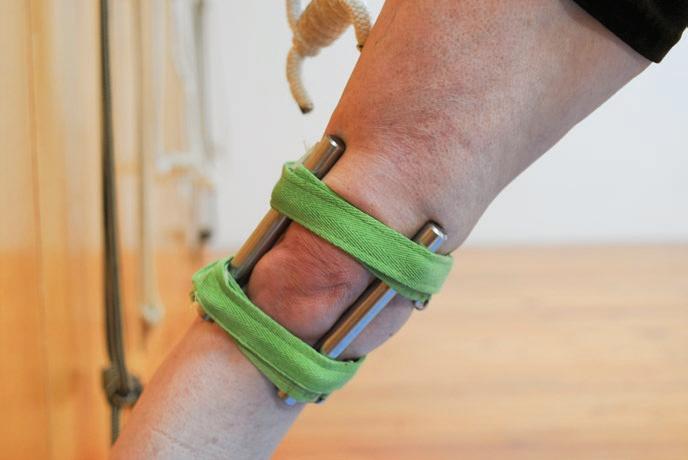
36 The Light | Fall 2022 BACK LEG CONTINUED
Figure 3 Figure
6
Figure 5
Figure 4
Ardha Chandrasana is also a lateral standing pose, but is a special case because the leg is raised.

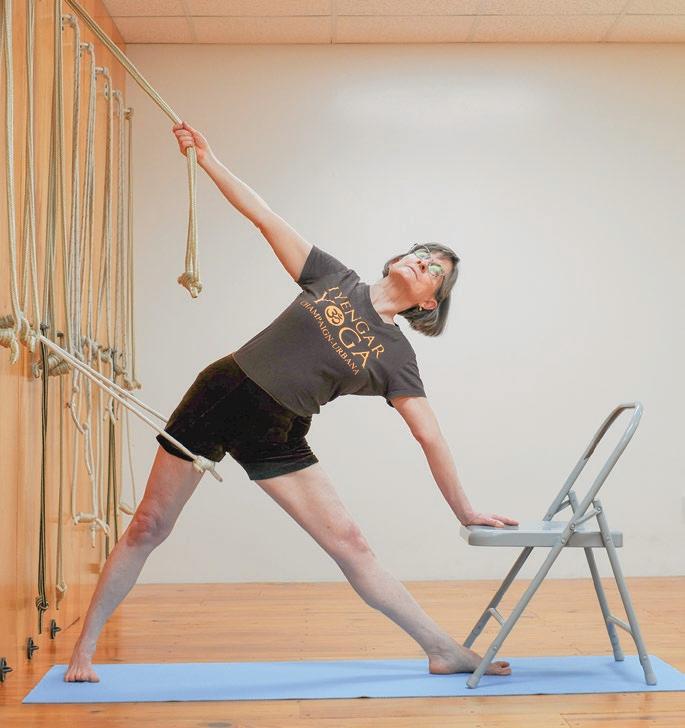
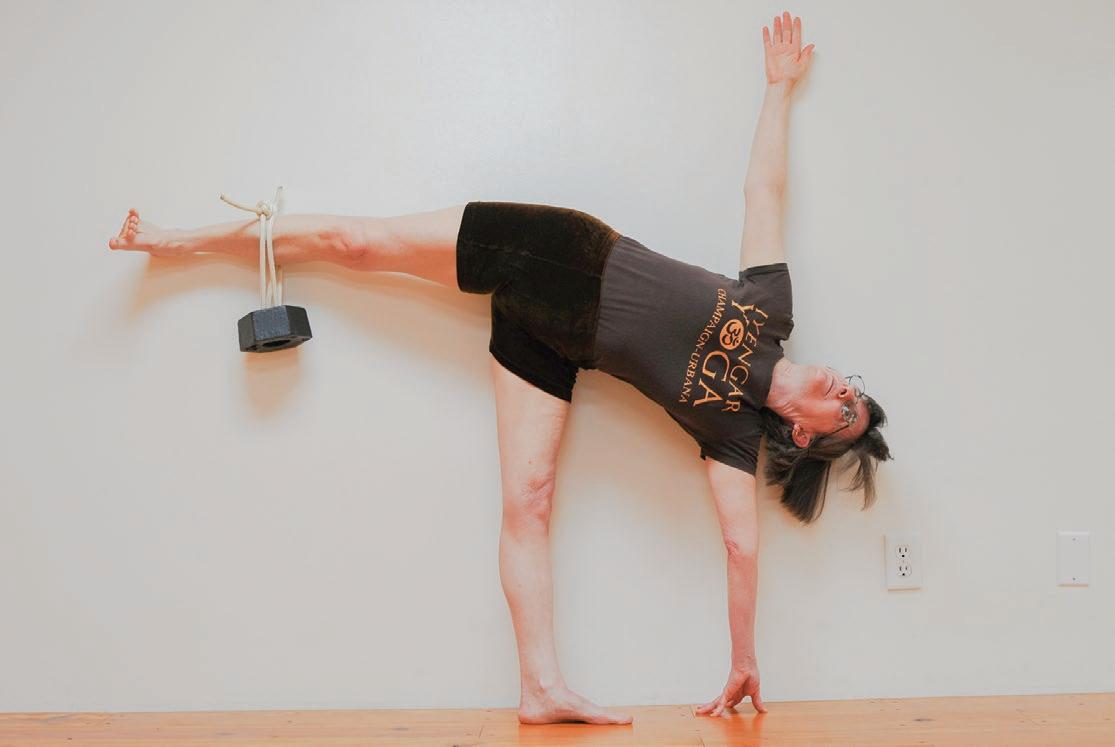
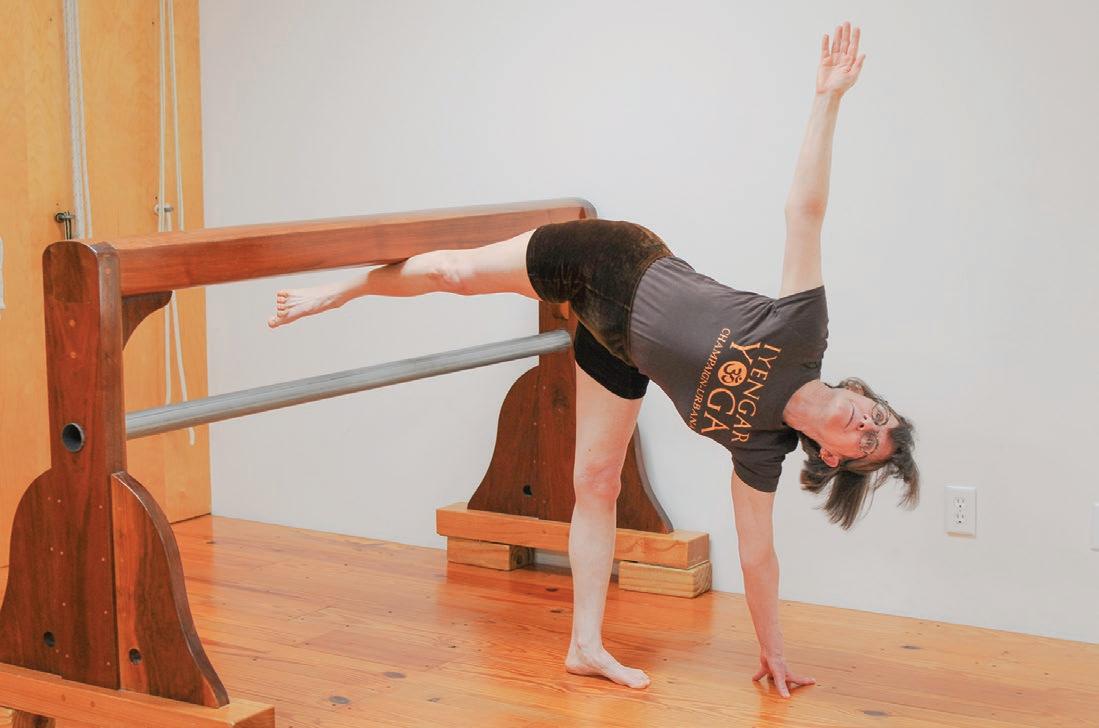
1. Inflate the back foot big toe ball mound before lifting it from the floor (Figure 8). Lift the small toe up to the ceiling and turn the foot slightly out (Figure 9). Lift and extend the entire raised leg to the inner foot. Resist the outer leg to the inner leg and move it towards the hip socket.
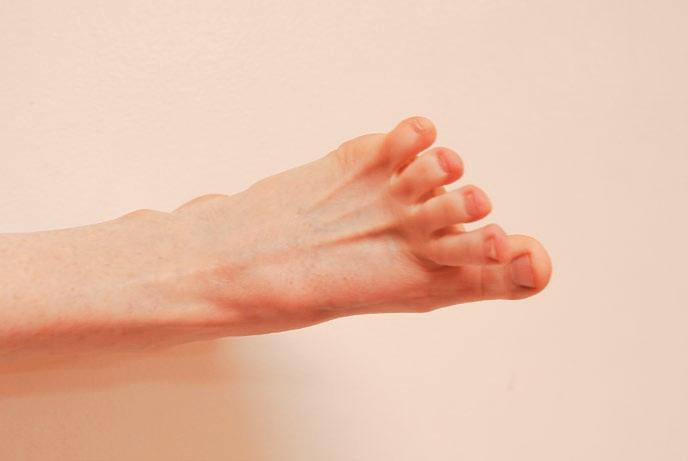
2. Raise a trestle on blocks. Then position the outer shin under the trestle (Figure 10). The raised leg may be low, but the effect is felt. A helper can position a rope to a weight and hang it from the outer shin (Figure 11). The weight should be close to the shin. Lift the inner shin up against the weight.
3. Place knee rods and belts, or just belts above and below the knee. Vertically bifurcate the kneecap to the outer and inner knee, respectively.
This is a snapshot of the back leg in the lateral standing poses. Happy practice!
Lois Steinberg (Ph.D., CIYT Level 4, C-IAYT) has four decades of extensive studentship with the Iyengars at the Ramamani Iyengar Memorial Yoga Institute in Pune. Lois is the director of Iyengar Yoga Champaign-Urbana in Illinois. She is the author of numerous books and articles. She served on the IYNAUS board and the Assessment Committee (formerly Certification Committee) and continues to serve as an assessor.
The Light | Fall 2022 37
Figure 10 Figure 11 Figure 7 Figure 8 Figure 9
Tribute to Faeq Biria
BY CAROLYN BELKO
Most of us came upon the blessing of Iyengar Yoga in a class or workshop, and, with time and practice, our lives transformed. Few of us have had the burning quest to travel in our own country or to India to find our Guru. Faeq Biria had that burning zeal to experience and search for the truth in yoga which led him to B.K.S. Iyengar.
has made the reader free from boredom.” This memory power has served us all.
The quest of his experiences could fill a book, never mind what transpired after Guruji came into his life. If one had the opportunity to listen to Faeq’s encounters with the yogis of the day, his words of yogic truths and guidance would fill one’s being. Faeq, a person of grand experience, joy, and wisdom, embodied humbleness. He arranged his life’s service in yoga as per Guruji’s prompts. He accompanied Guruji all over the world, driving Guruji on road trips in Europe in the old days. Guruji sent Faeq as an envoy to teach Iyengar Yoga throughout Europe, Africa, South America, and Asia. In some countries he was sent to train teachers and offer guidance to start associations. His summer intensives in the south of France were started thanks to Guruji’s idea.
Faeq did not write the book some of his students pleaded for him to do. As he told us, he was blessed to be of assistance to Guruji as he wrote his books. Early on with Tree of Yoga, then from Light on the Yoga Sutras of Patanjali, through all eight Astadala Yogamalas, Faeq could be seen at Guruji’s right hand in the RIMYI library.
In Astadala Yogamala vol. 8, Guruji acknowledges Faeq’s service by saying, “Faeq Biria — Who with dedication to the subject and to me, came to India every year specifically to help me, lending his unimaginable memory power which was a great help for me to rebuild the subject from his constructive thoughts which guided me to remove those repetitions that non-deliberately appeared in the volumes. With his memory power, he
My first taste of experience with tapas took place in classes, workshops, and in intensives with Faeq. He guided us to experience our bodies like clay pots in the kiln of Iyengar Yoga and to witness the effects of the cleansing and resulting mental clarity. It was like a measuring stick, to see where one could go on the mat at home, then to make it one’s own. To say the understanding of Guruji’s teachings was deeply rooted in him, is not sufficient to express the depth of the well of understanding from the source. For his students, what he brought to teaching was awe inspiring, whether that was in teacher training or in classes of asana, pranayama, or meditation There were always further layers waiting to be discovered. One could only imagine the breadth of his sadhana to bring so much forth to us. In all his expansive light, he always left us with the imprint that what we experienced with him was but a glimpse of the vastness of Guruji’s teaching: our shared beacon of the light.
To say he offered generously of his time and energy to others is an understatement.
Faeq emanated a contagious joy and enthusiasm for Iyengar Yoga and towards people who sincerely approached him to learn the subject. To say he offered generously of his time and energy to others is an understatement. Those of us near him would often ask,
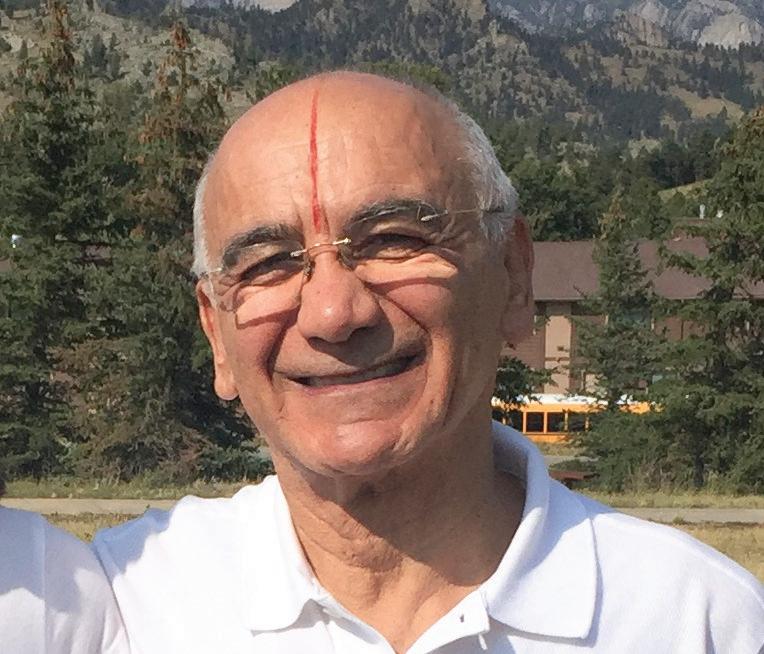

38 The Light | Fall 2022
Faeq, a person of grand experience, joy, and wisdom, embodied humbleness.
How does he do it? His attitude brought us beyond one’s self. He once said Guruji could see the positive potential for transformation through yoga practice in everyone who took to the practice. Faeq offered this message, doing his utmost to aid seekers, making sure they had all the tools he could fathom to construct a steady Iyengar Yoga practice.
One would look with wonder at his knowledge of books on the Indian schools of thought. Always during his travels, he found gems to add to his library or share with others. His delivery of his understanding of the vast yoga philosophical concepts and beliefs, gave us transformative reflections on and off the mat. Faeq’s inexhaustible studies of Sanatana Dharma offered us a clear and accessible window to view living yoga as a path and all in the light of Guruji’s works.
Words cannot describe the life of exceptional souls. Faeq’s quest in yoga, devotional love for Guruji and the subject, combined with incredible will and insight brought an exceptional teacher to us. At his final intensive in the U.S., in Colorado in 2019, Faeq told me one of his simplistic truths with his contagious enthusiasm, “Guruji’s teachings contain all of what one may find in yoga. One is to delve in and discover.”


This is not the first time a great teacher has passed. With Faeq as the mentor and teacher for so many, we thought of him as a firm foundation, one who would always be here. Since his passing forward, I bear witness to him in my life. I view these times in practice, teaching, and lifestyle as empowerments. I feel humbled and blessed all at once to be one of the many to have learned with such a great soul.
* In the next issue, look for a collaborative article on Faeq Biria’s Blacons Intensive Experience
Carolyn Belko started the study of Iyengar Yoga with Faeq and Corine Biria in 1990 at the Iyengar Yoga Center of Paris, where she trained with them and became a CIYT. She presently teaches at The Iyengar Yoga Source in San Diego.
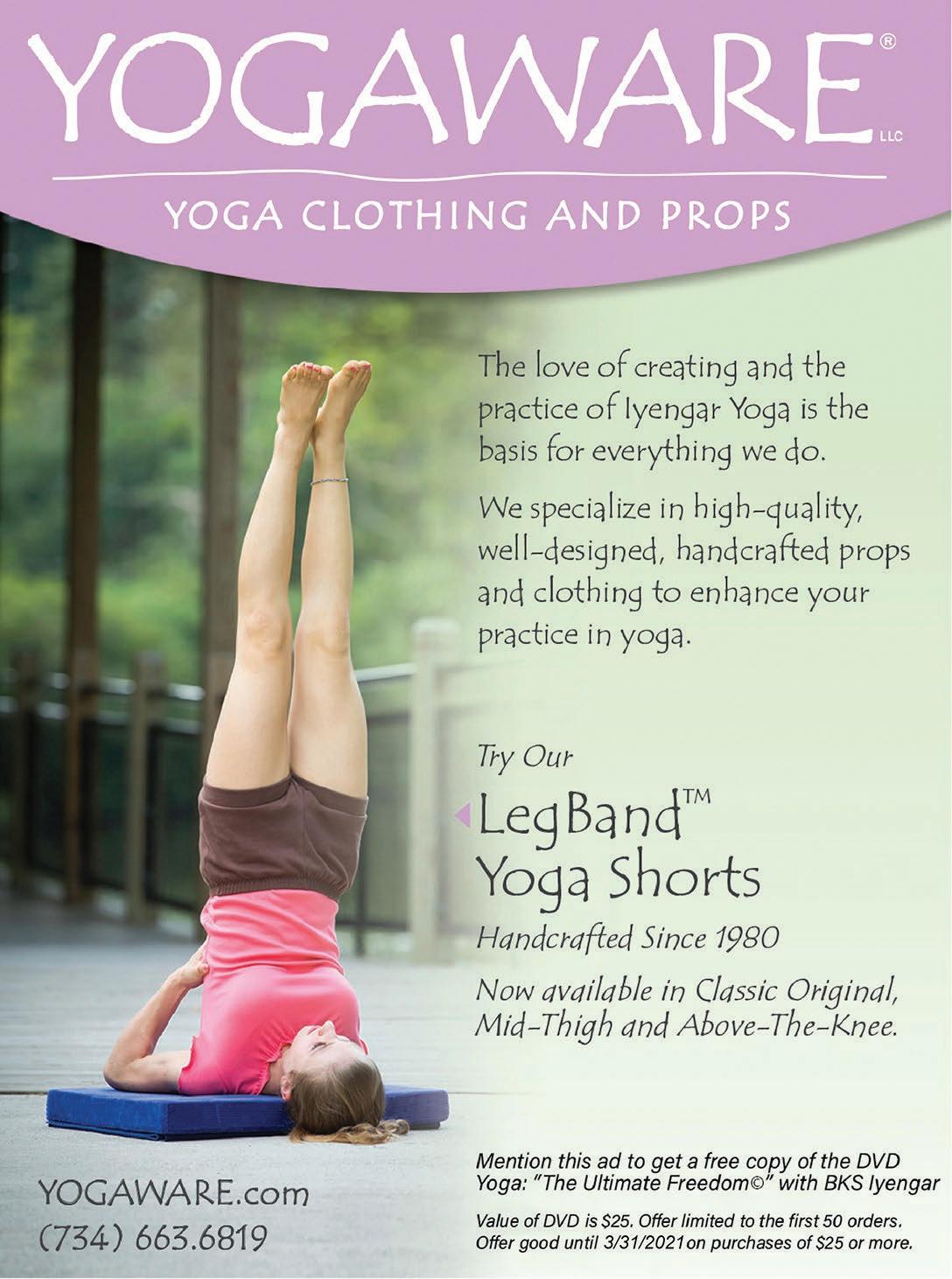
The Light | Fall 2022 39
September 2019, Estes Park, CO
Carolyn Belko and Faeq Biria
IYNAUS is pleased to welcome Abhijata Iyengar, who will lead our 2023 convention in San Diego. Abhijata Iyengar began her yoga study at 16 under her maternal grandfather’s direct guidance, Yogacharya B.K.S. Iyengar, her aunt, Dr. Geeta S. Iyengar, and her uncle Sri Prashant Iyengar. Abhijata holds a Bachelor of Science in Zoology and a Masters in Bioinformatics. She was contemplating a Ph.D. when her path changed, and
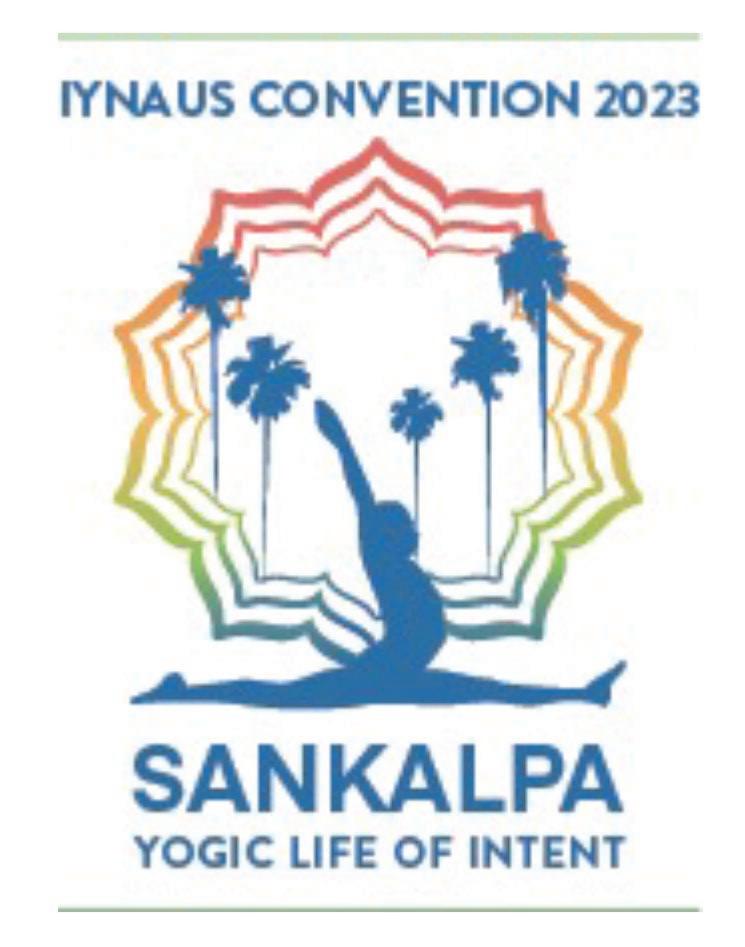
she began teaching Iyengar Yoga under the tutelage of her grandfather, aunt, and uncle. Currently, Abhijata is a senior teacher at RIMYI in Pune and teaches internationally at Iyengar Yoga conventions around the world. She is in charge of the therapeutic classes at the institute. While her family’s influence is evident in her instruction, she has developed her teaching style that evinces poise, maturity, and humor.
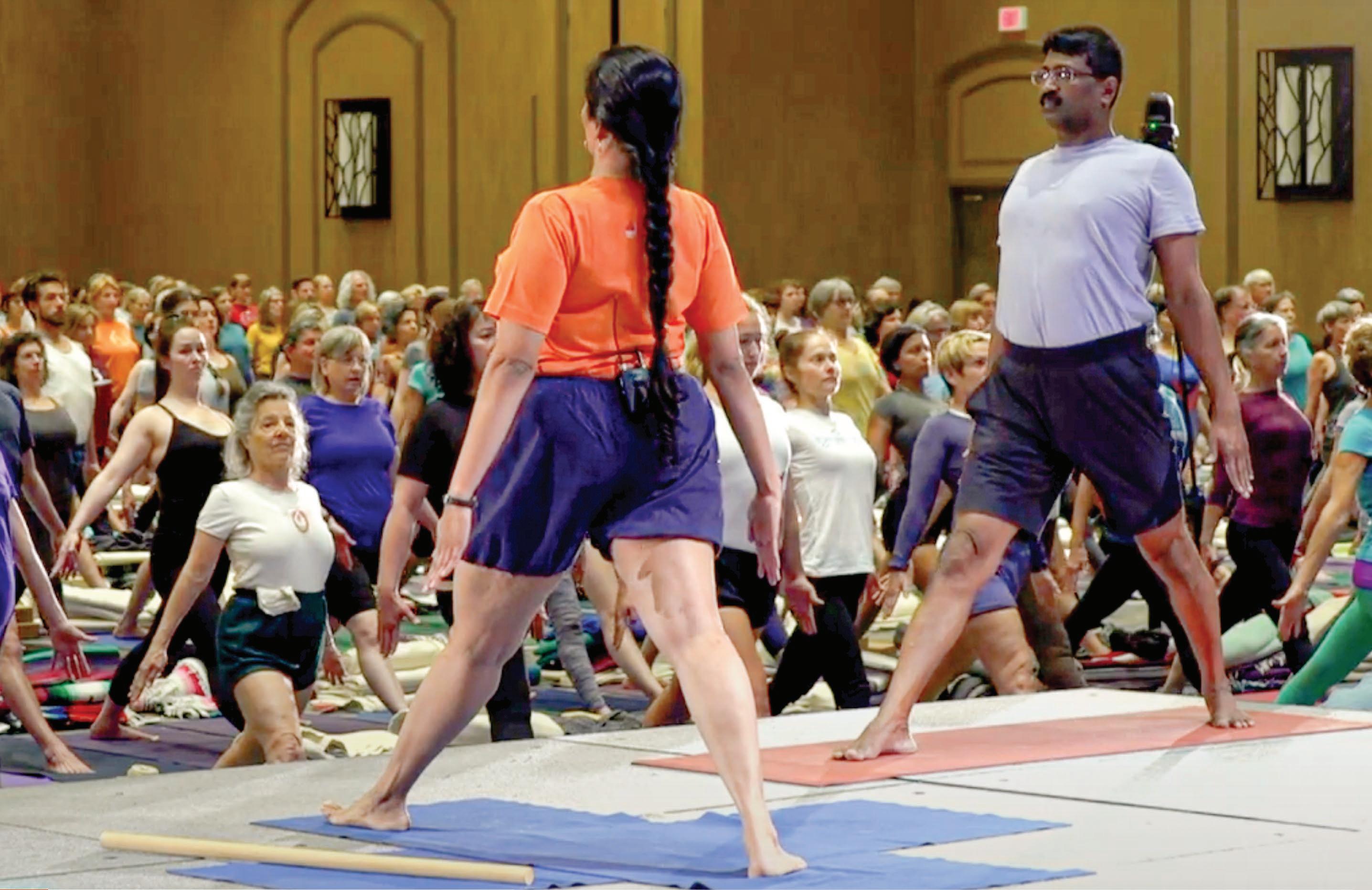
40 The Light | Fall 2022
WARRIOR II: THE ARCHER
Face north and spread your feet from west to east. Stretch your arms out to the sides. Reach beyond the edges of the sky. Turn your right foot out to point due east, your head to gaze down your right arm, and bend your knee to form a perfect square. Release your skin, keep your muscles firm. Slow your breath. Go in. Linger there.
Unattached to outcomes, you cannot fail. Whatever you’re afraid of, cast aside. Drop your blinders, see on a cosmic scale. Single-eyed, your body full of light, look beyond the arrow, through the veil, release the bowstring, let the arrow sail.
UPWARD BOW
With palms and soles pressed down, extend your arms and legs to vault your navel skyward, arc your spine. Your vertebrae may smolder, sweat beads on your brow and temples glisten, tidal waves surge through your heart and gut. The upward facing bow is made of fire. If this bow shot an arrow it would soar beyond the bounds of all you’ve ever known.
This bow you wield was forged by Brahma. Its celestial string cannot be broken. Walk your feet in closer to your hands, lift your tailbone higher. Nothing stands between you and what you strive for. Let go of all desire, let the arrow fly.
by John Whitney Steele, CIYT, from his new book of poems about yoga: Shiva’s Dance, in stock at the IYNAUS bookstore. More information and signed copies are available through his website
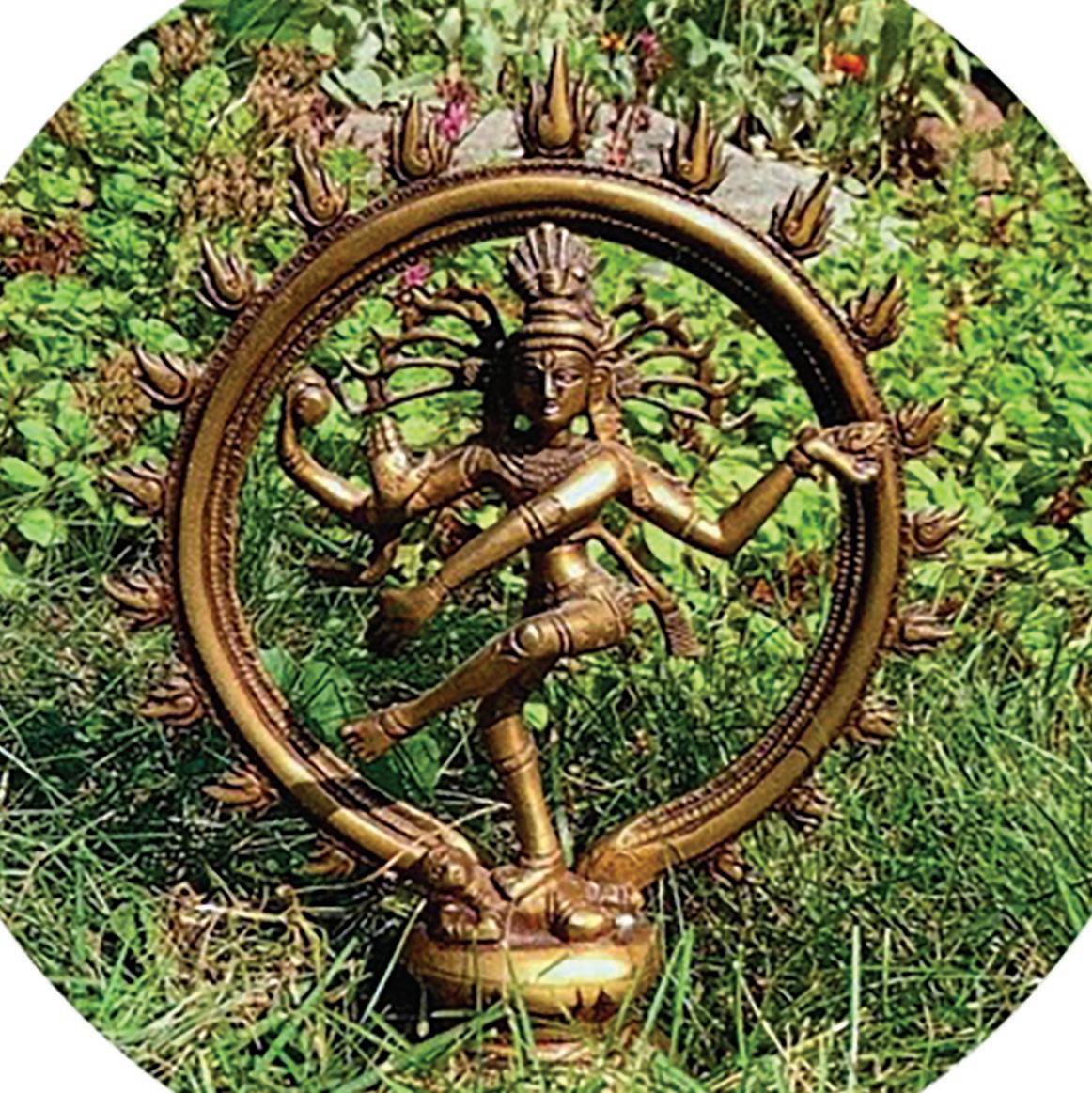
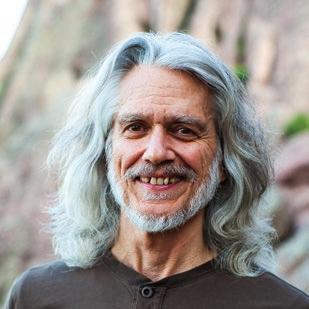
The Light | Fall 2022 41
I wish my teacher Patricia Walden a happy birthday, and I would like to express my gratitude for the years of wonderful teaching and mentorship. I was first introduced to Patricia after studying Iyengar Yoga for many years. Her approach was very different. While it appeared softer and gentler on the surface, I found that my experience was deeper and more profound.
Patricia’s history of a long, uninterrupted mentorship with B.K.S. Iyengar is reflected in her teaching and her understanding of the eight limbs of yoga.
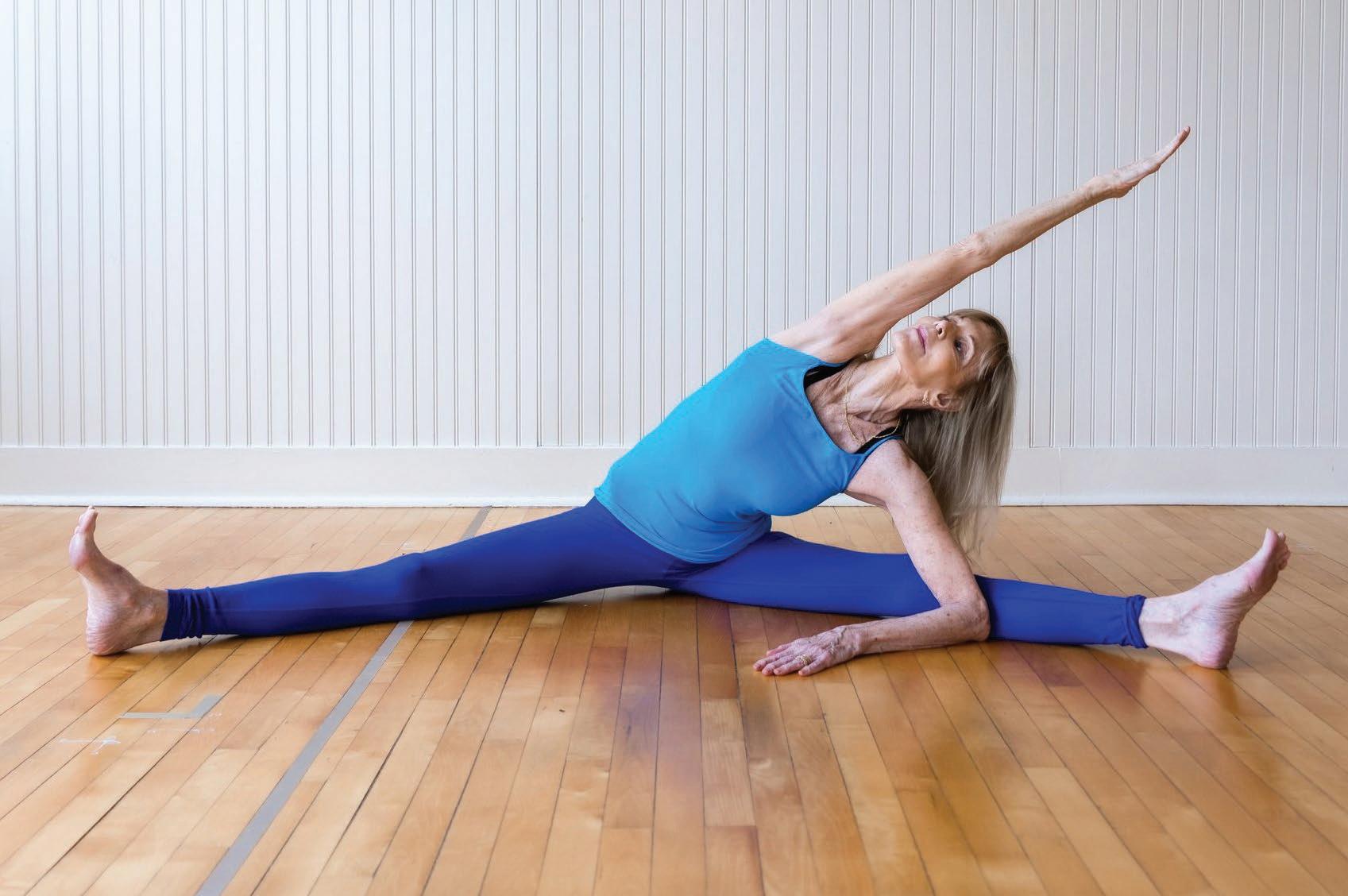
I will be forever grateful for Patricia Walden. HAPPY BIRTHDAY! —Randy Just
B.K.S. Iyengar Yoga National Association of the United States c/o Gloria Goldberg 770 Sycamore Avenue, Ste. 122-136 Vista, CA 92083 USA www.iynaus.org
Patricia Walden































































